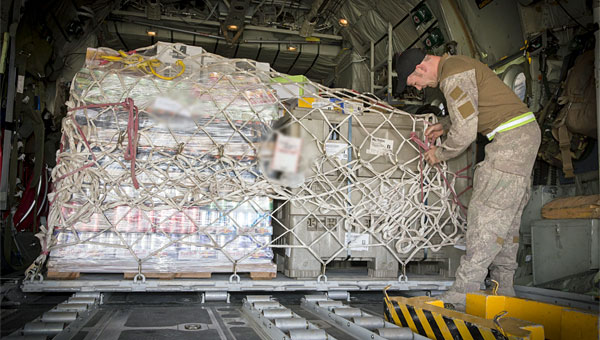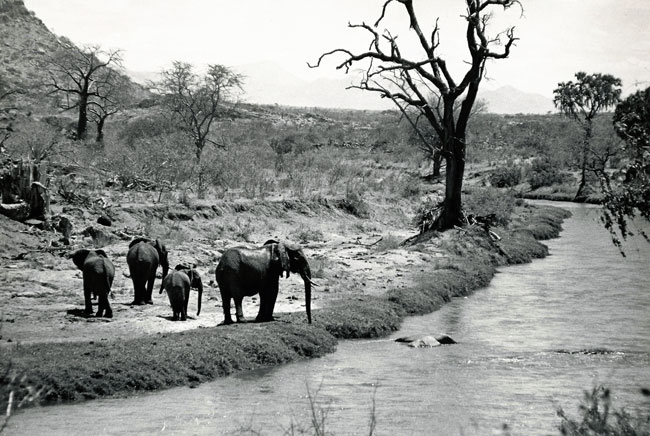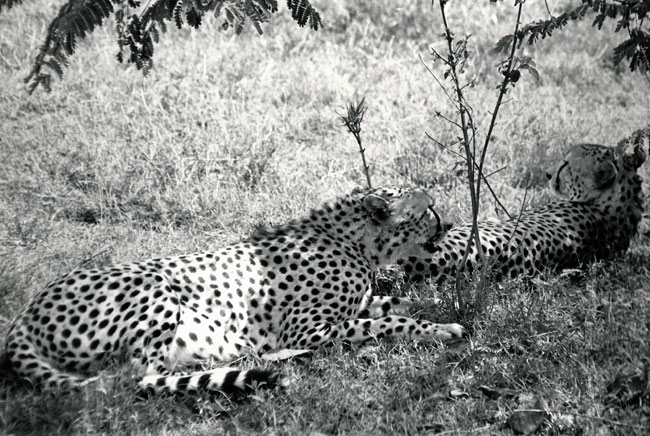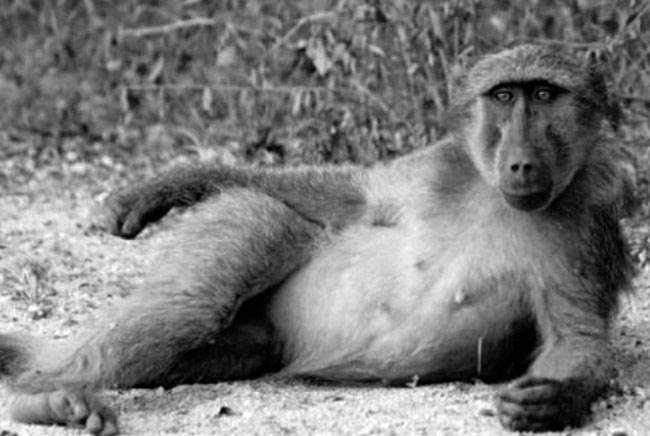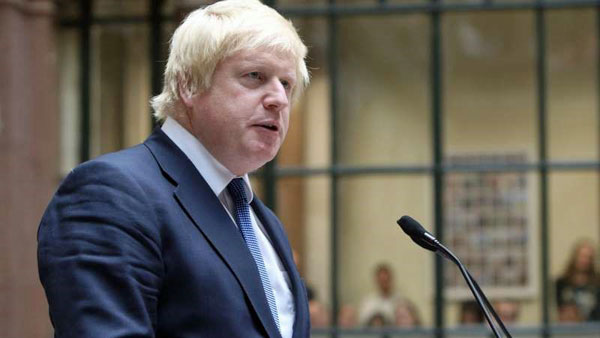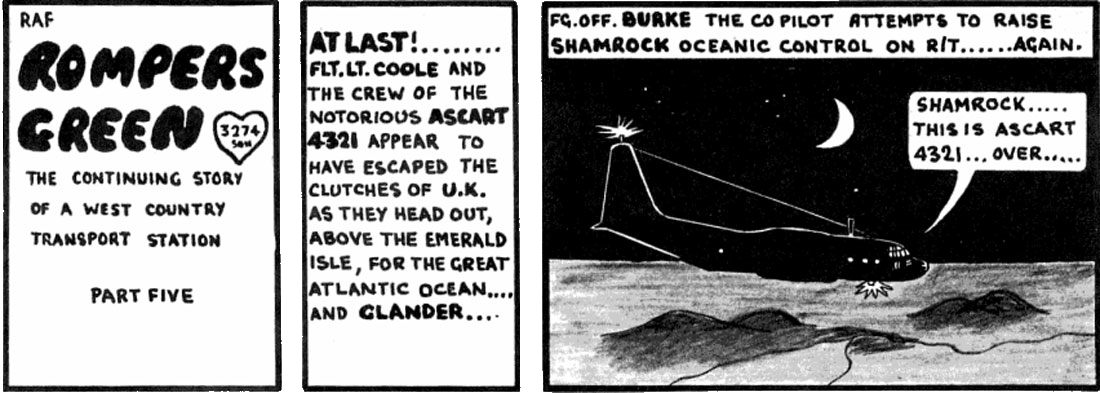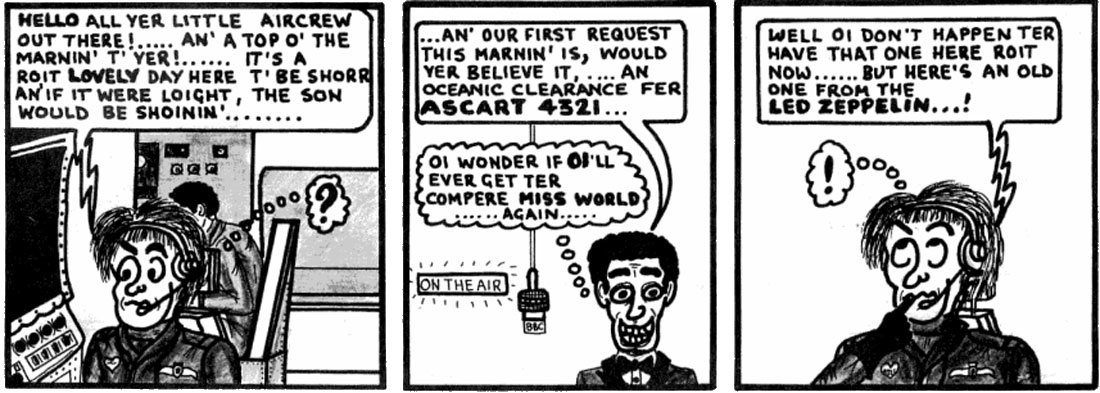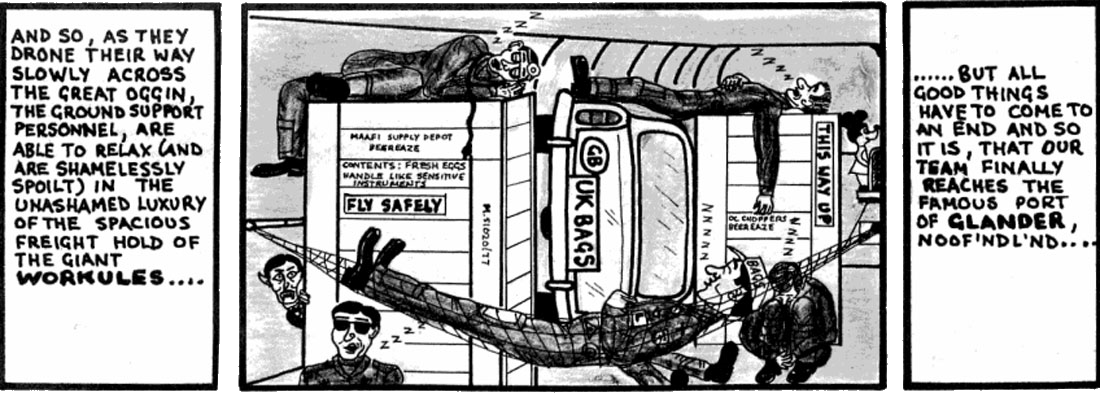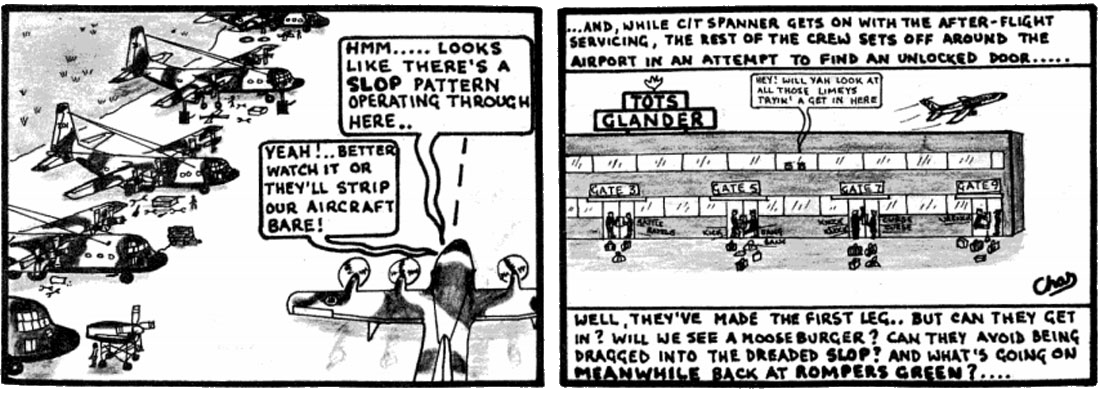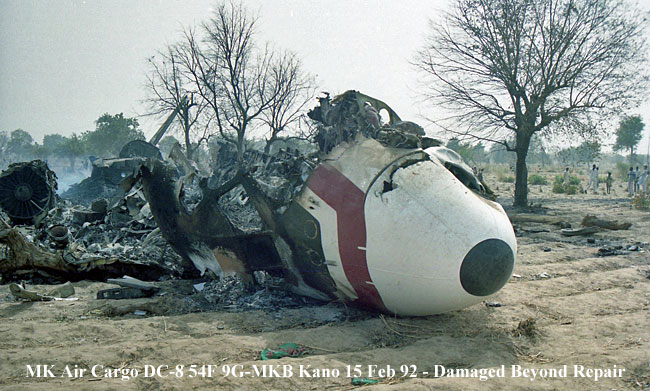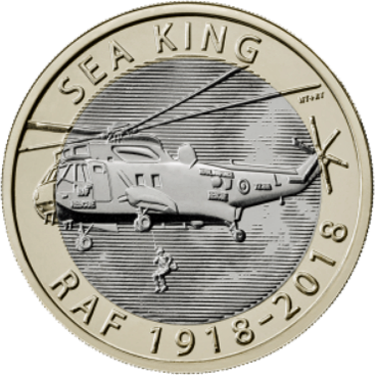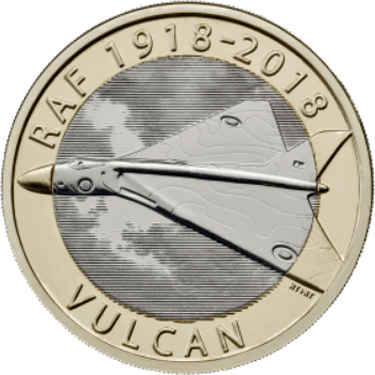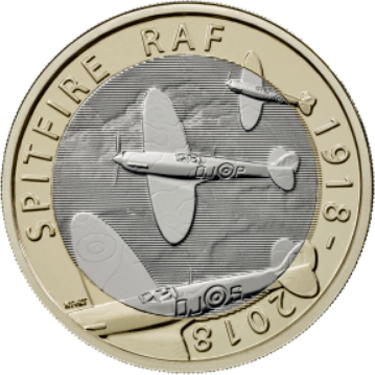







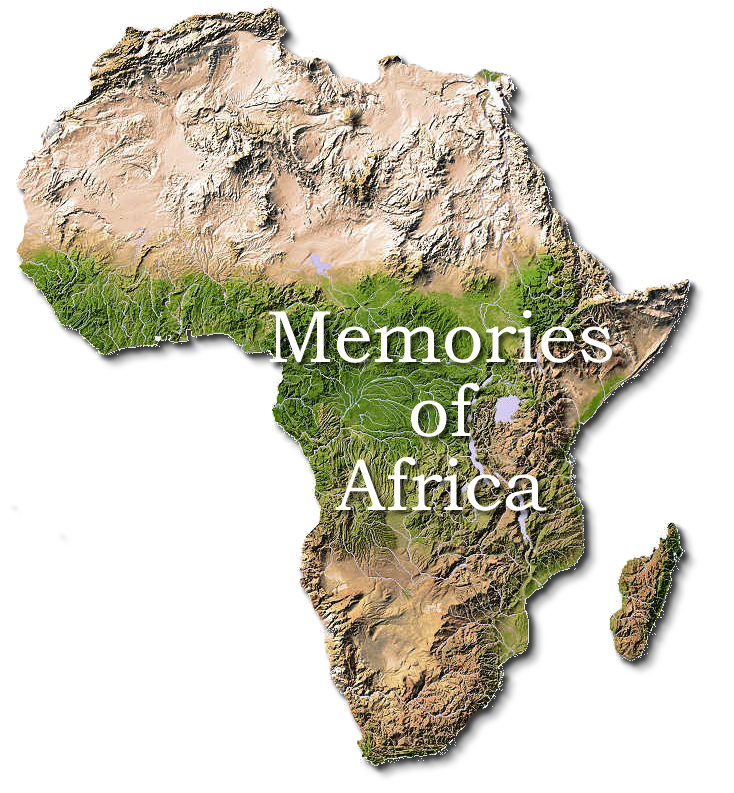





Boris Johnson Says VIP RAF Voyager 'Is Never Available'


From: Steve Harpum, York
Subject: Re: UKMAMS OBA OBB #042718
Many thanks, Tony - as ever, an interesting and enjoyable read, but I was literally brought to a halt by the picture of the UKMAMS Ops room. There sits the late, great Jim Stewart, of whom the stories are legion, and a certain (very, very young) Fg Off Andy Kime (and my sincere apologies to the other two gentlemen in the picture for forgetting their names). That picture was like stepping through a time warp for me, with so many happy memories coming flooding back.
I reckon that picture must have been taken in the early 1980's, but if you have any details I'd be very grateful.
Cheers, Steve
Subject: Re: UKMAMS OBA OBB #042718
Many thanks, Tony - as ever, an interesting and enjoyable read, but I was literally brought to a halt by the picture of the UKMAMS Ops room. There sits the late, great Jim Stewart, of whom the stories are legion, and a certain (very, very young) Fg Off Andy Kime (and my sincere apologies to the other two gentlemen in the picture for forgetting their names). That picture was like stepping through a time warp for me, with so many happy memories coming flooding back.
I reckon that picture must have been taken in the early 1980's, but if you have any details I'd be very grateful.
Cheers, Steve
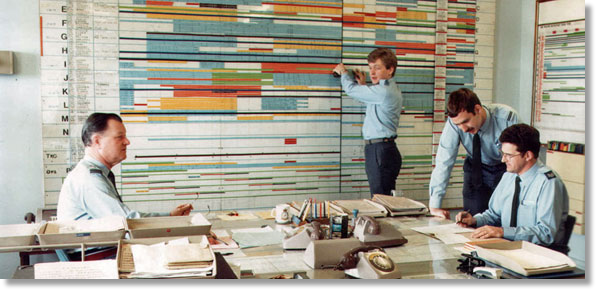
From: Ian Berry, West Swindon
Subject: RE: Ops Photo
Tony/Steve,
With the aid of high resolution and a magnifying glass the picture was taken in June 1985. The two airmen in the picture are Sgt Ian Williams, last heard of as an employee of the Science Museum Reserve collection at Wroughton Airfield and SAC Chris Trevelyan whom when I last met in the 90's was a Bush Pilot flying the mail out of Seattle to inland Washington State.
Kindest regards,
Ian
Subject: RE: Ops Photo
Tony/Steve,
With the aid of high resolution and a magnifying glass the picture was taken in June 1985. The two airmen in the picture are Sgt Ian Williams, last heard of as an employee of the Science Museum Reserve collection at Wroughton Airfield and SAC Chris Trevelyan whom when I last met in the 90's was a Bush Pilot flying the mail out of Seattle to inland Washington State.
Kindest regards,
Ian
From: Alex Masson, Chelmsford, Essex
Subject: Memories of RAF Abingdon
Before we went to Christmas Island in 1956, Philip Pratley then a Corporal, and myself an SAC, went to Watchfield to join the 47 Company RASC (Royal Army Service Corps) to be taught how to despatch parachutes from transport aircraft. All of this was put into practice and we flew from Abingdon in the Hastings and Valetta aircraft of 1312 Flight and dropped our supplies on Watchfield.
Towards the end of the first week, one afternoon was to be a lecture by the CO, who was a Captain whose name I cannot now recall. He commenced by explaining that this lecture was most important, and went on to describe the ‘weight and balance’ of the cargo aeroplane, in this case the ‘Hastings’. He correctly drew our attention to the restrictive limits of the permissible ‘centre of gravity’ of the aircraft, which changes according to where the load is variously placed, and how it had to remain within these limits throughout take off, flight and ultimately the landing condition.
While this was intriguing stuff for some students, others, judging by the blank looks on some faces, clearly were completely baffled. To us, however, it was second nature as we had been loading these aeroplanes for almost two years.
I suppose I was getting a little bored with this as he wasn’t teaching us anything we did not know. My mind wandered and I was elsewhere when suddenly I was brought down to earth by something the Captain said. He was going through the mathematics of this aircraft load, putting a Landrover hard up front in a Hastings with some kind of small field gun up behind it with the trail of the gun snugly placed under the Landrover. I made a quick calculation and leaned over to Phil, who had been a little more awake than me, for he was scribbling furiously and he pre-empted me by saying, “Yes, it’s nose heavy!” I remarked “His figures are wrong.”
Next thing I was aware of the Captain bellowing at us telling us to be quiet and that he would not tolerate any talking or interruptions of his lecture. Before he had finished, I said, “Just a ‘cotton picking’ minute! Is that the entire load for that aircraft?” “Yes!” he snapped. I continued, “Then you are doing something wrong!” The Captain went into a rage. “Don’t tell me I’m wrong. I have here the official instructions ….” I interrupted him again saying, “I don’t know what you have there, but we load these planes every day of our working life and can see that something is badly wrong! If that is all the load then the plane will be nose heavy and well out of trim” Phil joined me, adding, “He’s right Sir! That plane will be nose heavy but at this moment I can’t for the life of me, see why.”
Gathering around the table, the Captain commenced, “Let’s start at the beginning, the basic empty weight of the Hastings is 41,689 lbs plus crew and standard equipment at 4,470 lbs gives us 46,159 lbs before load or fuel ….” We both broke in with “No way! Before fuel and load Hastings are between 53 and 54,000 lbs.” Then I saw on the top of the form ‘Hastings Mk1’. I said, “Good grief! There are no Mark 1’s flying in the RAF. They are all Mark 2’s or 1A’s.
Subject: Memories of RAF Abingdon
Before we went to Christmas Island in 1956, Philip Pratley then a Corporal, and myself an SAC, went to Watchfield to join the 47 Company RASC (Royal Army Service Corps) to be taught how to despatch parachutes from transport aircraft. All of this was put into practice and we flew from Abingdon in the Hastings and Valetta aircraft of 1312 Flight and dropped our supplies on Watchfield.
Towards the end of the first week, one afternoon was to be a lecture by the CO, who was a Captain whose name I cannot now recall. He commenced by explaining that this lecture was most important, and went on to describe the ‘weight and balance’ of the cargo aeroplane, in this case the ‘Hastings’. He correctly drew our attention to the restrictive limits of the permissible ‘centre of gravity’ of the aircraft, which changes according to where the load is variously placed, and how it had to remain within these limits throughout take off, flight and ultimately the landing condition.
While this was intriguing stuff for some students, others, judging by the blank looks on some faces, clearly were completely baffled. To us, however, it was second nature as we had been loading these aeroplanes for almost two years.
I suppose I was getting a little bored with this as he wasn’t teaching us anything we did not know. My mind wandered and I was elsewhere when suddenly I was brought down to earth by something the Captain said. He was going through the mathematics of this aircraft load, putting a Landrover hard up front in a Hastings with some kind of small field gun up behind it with the trail of the gun snugly placed under the Landrover. I made a quick calculation and leaned over to Phil, who had been a little more awake than me, for he was scribbling furiously and he pre-empted me by saying, “Yes, it’s nose heavy!” I remarked “His figures are wrong.”
Next thing I was aware of the Captain bellowing at us telling us to be quiet and that he would not tolerate any talking or interruptions of his lecture. Before he had finished, I said, “Just a ‘cotton picking’ minute! Is that the entire load for that aircraft?” “Yes!” he snapped. I continued, “Then you are doing something wrong!” The Captain went into a rage. “Don’t tell me I’m wrong. I have here the official instructions ….” I interrupted him again saying, “I don’t know what you have there, but we load these planes every day of our working life and can see that something is badly wrong! If that is all the load then the plane will be nose heavy and well out of trim” Phil joined me, adding, “He’s right Sir! That plane will be nose heavy but at this moment I can’t for the life of me, see why.”
Gathering around the table, the Captain commenced, “Let’s start at the beginning, the basic empty weight of the Hastings is 41,689 lbs plus crew and standard equipment at 4,470 lbs gives us 46,159 lbs before load or fuel ….” We both broke in with “No way! Before fuel and load Hastings are between 53 and 54,000 lbs.” Then I saw on the top of the form ‘Hastings Mk1’. I said, “Good grief! There are no Mark 1’s flying in the RAF. They are all Mark 2’s or 1A’s.
We then explained that there were no Mk1 aircraft in RAF Squadron service any more, they were all now modified up to Mk2 standard with bigger, heavier and more powerful engines. They had been re-designated Mk1A aircraft. This had altered the C of G limits. No wonder his calculations were wrong.
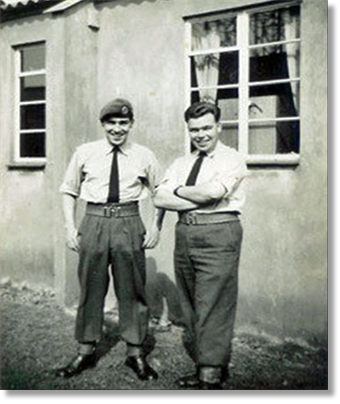
In due course we were called to re-assemble in the class. The Captain addressed us with, “I would like to express my appreciation to the RAF chaps here, who have drawn my attention to a fairly serious error. I would like to apologise for bawling at them for interrupting; I am more than pleased that they did.
"We have been instructing on an obsolete aircraft and we have never been updated as to what the RAF is currently using. Signals are, at this very moment going out to all trained staff to be aware of this fact, and arrangements are in hand for a re-training programme for all personnel to be initiated.”
The Captain, whose name escapes me, was greatly appreciative of our intervention, and spent a long time talking with us and finding out exactly what our job was in the RAF. For the remainder of the course we were consulted on all manner of procedures, just in case there were any other quirks in loading aeroplanes which could effect the efficiency of the training programme of 47 Company RASC.
One time, as we were loading some Landrovers in the mock-up of the Hastings, the RSM came up to see what we were doing. He paused by me and said, “You haven’t got that right!” I did see what he meant at first. He said, “Look here! You have not got that chain across the floor from here to there!” and he indicated with his ‘pace stick’ and he drew a line on the floor where it should be, behind the wheels of the Landrover.
Then I caught on, he had been looking at the plans but only from above, and had not realised that the chain was supposed to go over the axle of the vehicle. “I think it is better my way, the Landrover needs tying down, the Hasting floor does not!” He turned and disappeared.
"We have been instructing on an obsolete aircraft and we have never been updated as to what the RAF is currently using. Signals are, at this very moment going out to all trained staff to be aware of this fact, and arrangements are in hand for a re-training programme for all personnel to be initiated.”
The Captain, whose name escapes me, was greatly appreciative of our intervention, and spent a long time talking with us and finding out exactly what our job was in the RAF. For the remainder of the course we were consulted on all manner of procedures, just in case there were any other quirks in loading aeroplanes which could effect the efficiency of the training programme of 47 Company RASC.
One time, as we were loading some Landrovers in the mock-up of the Hastings, the RSM came up to see what we were doing. He paused by me and said, “You haven’t got that right!” I did see what he meant at first. He said, “Look here! You have not got that chain across the floor from here to there!” and he indicated with his ‘pace stick’ and he drew a line on the floor where it should be, behind the wheels of the Landrover.
Then I caught on, he had been looking at the plans but only from above, and had not realised that the chain was supposed to go over the axle of the vehicle. “I think it is better my way, the Landrover needs tying down, the Hasting floor does not!” He turned and disappeared.
Alex Masson, Philip Pratley - Abingdon,1956
Cheers,
Alex (and Legs!)
Alex (and Legs!)
From: Sam Mold, Brighton & Hove
Subject: Aden
To all RAF association newsletter editors listed on my computer, I'm sure several of your members would have survived a two-year stint to the barren rocks of Aden. I would be surprised to learn that anyone ever did two tours to this former colony, now a part of Yemen. A posting to the Suez Canal zone was not a popular posting, made even worse for unruly airmen who were punished with a posting to Aden for their troubles.
By the time my tour (1961-62) came round, massive improvements had been made with accommodation upgrades for airman and leasing modern flats in the Maala road for Married Quarters. The then Governor claimed this was the best street in the Arab world, and I don't think he was far wrong in his assessment.
There was a cold storage building in Steamer Point to keep fresh the meat and vegetables flown in from Kenya by RAF Beverley transport planes based at Khormaksar. My tour was neatly divided between the two RAF Stations: Steamer Point and Khomaksar. I enjoyed both of them; in fact, I liked Aden very much indeed. Some people find it hard to believe that I preferred my two-year tour in Aden more so than the 15-month tour served in Australia.
In its favour, Aden only has a couple of days rain a year, but more importantly, in those days, it is especially remembered as one of the cheapest places in the world. As a heavy 80-a-day smoker and a drinker who needed to replace sweat lost in the hot season when temperatures reached 120 degrees in the shade, made worse by 100% high humidity rates, it was essential to quench one's thirst. The day-to-day living expenses were so cheap that I can still recall prices. A pack of 200 king-size Rothmans cigarettes costs 9 shillings (45p); the same price as a bottle of spirits, other than the slightly more expensive brandy.
It would be nice to write a book about one of my favourite postings, but why bother when a book on the subject has already been written by someone much more clever than I could ever be.
The late Peter Richards, a retired RAF engineering Warrant Officer, was writing a book, 'Return to Aden', but died before it had been completed. His two sons added the final two chapters and had the book published in 2004. It is a very comprehensive account and covers the full history of what once was a British Protectorate. I really enjoyed reading the book that turned out to be a wonderful memory-jogger. Names long forgotten came flying off the pages, reminding me of times long gone by. Anyone who has served in Aden, will, I'm sure, enjoy reading the book as much as I have.
Subject: Aden
To all RAF association newsletter editors listed on my computer, I'm sure several of your members would have survived a two-year stint to the barren rocks of Aden. I would be surprised to learn that anyone ever did two tours to this former colony, now a part of Yemen. A posting to the Suez Canal zone was not a popular posting, made even worse for unruly airmen who were punished with a posting to Aden for their troubles.
By the time my tour (1961-62) came round, massive improvements had been made with accommodation upgrades for airman and leasing modern flats in the Maala road for Married Quarters. The then Governor claimed this was the best street in the Arab world, and I don't think he was far wrong in his assessment.
There was a cold storage building in Steamer Point to keep fresh the meat and vegetables flown in from Kenya by RAF Beverley transport planes based at Khormaksar. My tour was neatly divided between the two RAF Stations: Steamer Point and Khomaksar. I enjoyed both of them; in fact, I liked Aden very much indeed. Some people find it hard to believe that I preferred my two-year tour in Aden more so than the 15-month tour served in Australia.
In its favour, Aden only has a couple of days rain a year, but more importantly, in those days, it is especially remembered as one of the cheapest places in the world. As a heavy 80-a-day smoker and a drinker who needed to replace sweat lost in the hot season when temperatures reached 120 degrees in the shade, made worse by 100% high humidity rates, it was essential to quench one's thirst. The day-to-day living expenses were so cheap that I can still recall prices. A pack of 200 king-size Rothmans cigarettes costs 9 shillings (45p); the same price as a bottle of spirits, other than the slightly more expensive brandy.
It would be nice to write a book about one of my favourite postings, but why bother when a book on the subject has already been written by someone much more clever than I could ever be.
The late Peter Richards, a retired RAF engineering Warrant Officer, was writing a book, 'Return to Aden', but died before it had been completed. His two sons added the final two chapters and had the book published in 2004. It is a very comprehensive account and covers the full history of what once was a British Protectorate. I really enjoyed reading the book that turned out to be a wonderful memory-jogger. Names long forgotten came flying off the pages, reminding me of times long gone by. Anyone who has served in Aden, will, I'm sure, enjoy reading the book as much as I have.
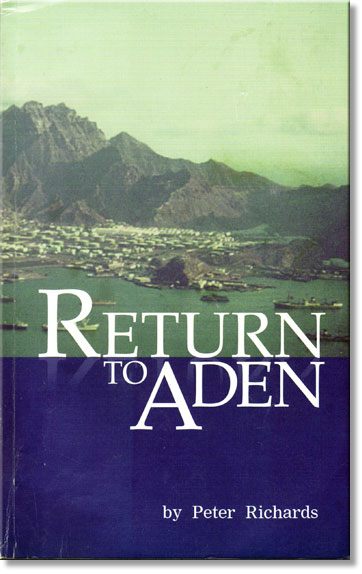
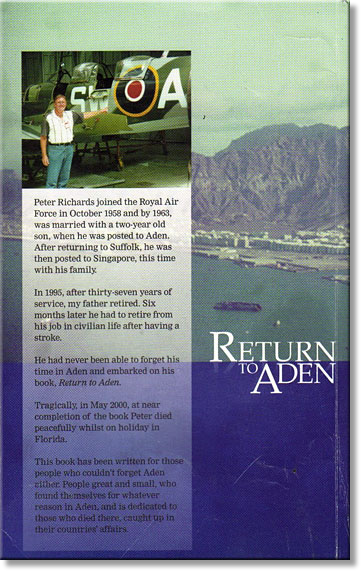
Those who wish to buy the book can obtain a copy by contacting Peter's widow: Mrs. Cherie Richards
Best wishes and happy hunting for 'Return to Aden' - Sam
Best wishes and happy hunting for 'Return to Aden' - Sam

NZDF's Mission in the Middle East off to a Flying Start
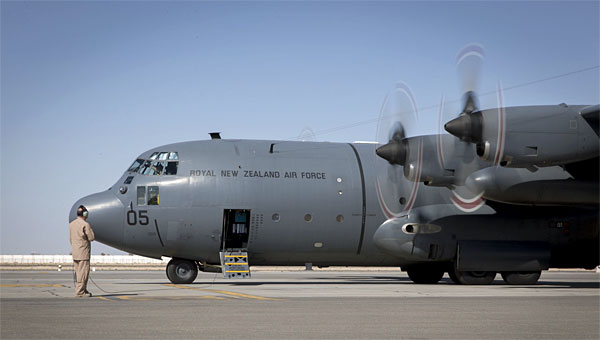
The New Zealand Defence Force’s (NZDF) air transport mission in the Middle East got off to a flying start this week, with the delivery of two tonnes of supplies for coalition troops operating in Iraq. The 32-strong detachment and a Royal New Zealand Air Force C-130H(NZ) Hercules aircraft are operating with the Australian Defence Force’s air mobility task group to transport supplies and personnel required for New Zealand, Australian and coalition operations in the Middle East region.
Squadron Leader Brad Scott, the Commander of the air transport team’s first rotation, said 30 New Zealand military personnel were also flown to Camp Taji in Iraq this week. “The entire team has been looking forward to this mission and to work once again with our Australian partners,” Squadron Leader Scott said. “Everyone is eager to get stuck in and show why we are regarded as a reliable and trusted coalition partner.” The detachment includes aircraft technicians, logistics specialists, maintenance personnel, and an Air Movements Load Team that will support coalition aircraft in the region.
Squadron Leader Brad Scott, the Commander of the air transport team’s first rotation, said 30 New Zealand military personnel were also flown to Camp Taji in Iraq this week. “The entire team has been looking forward to this mission and to work once again with our Australian partners,” Squadron Leader Scott said. “Everyone is eager to get stuck in and show why we are regarded as a reliable and trusted coalition partner.” The detachment includes aircraft technicians, logistics specialists, maintenance personnel, and an Air Movements Load Team that will support coalition aircraft in the region.
On a similar six-month deployment in 2016 an NZDF air transport mission transported nearly 800 tonnes of supplies and about 3200 military personnel to Iraq and Afghanistan. A month-long mission in 2017 transported 120 tonnes of supplies and about 500 personnel supporting coalition operations in the Middle East.
Medium.com
Medium.com

From: Jack Pyne, Wiltshire
Subject: Information on Sgt. Tony Pyne
Dear Mr Gale,
My name is Jack Pyne, I am 18 and don’t live too far away from RAF Lyneham. Sergeant Tony Pyne was my grandad, sadly he passed away last year. He was never too open about his time in the RAF and UKMAMS to my Nan, Dad or myself, all I know is that he was a very keen photographer and artist.
I gave him a quick search online and came across a couple of pictures of him and some of the old briefs on your site. I also saw that one of his former colleagues, Norman Radcliffe, had written a message on the site saying that he had a cartoon image that my grandad drew whilst he was serving. I searched Mr Radcliffe to see if I could get into contact with him, but sadly he too has passed away.
I was wondering if you had this cartoon or any other information or know of any places where I could find some of his cartoons, photos or anything on him?
I realise this is quite a strange request and completely out of the blue but any help would be massively appreciated as I try to find out about my grandad’s career.
Thank you for your time and I hope to hear from you sometime soon.
Jack Pyne,
Subject: Information on Sgt. Tony Pyne
Dear Mr Gale,
My name is Jack Pyne, I am 18 and don’t live too far away from RAF Lyneham. Sergeant Tony Pyne was my grandad, sadly he passed away last year. He was never too open about his time in the RAF and UKMAMS to my Nan, Dad or myself, all I know is that he was a very keen photographer and artist.
I gave him a quick search online and came across a couple of pictures of him and some of the old briefs on your site. I also saw that one of his former colleagues, Norman Radcliffe, had written a message on the site saying that he had a cartoon image that my grandad drew whilst he was serving. I searched Mr Radcliffe to see if I could get into contact with him, but sadly he too has passed away.
I was wondering if you had this cartoon or any other information or know of any places where I could find some of his cartoons, photos or anything on him?
I realise this is quite a strange request and completely out of the blue but any help would be massively appreciated as I try to find out about my grandad’s career.
Thank you for your time and I hope to hear from you sometime soon.
Jack Pyne,
From: Tony Gale, Gatineau, QC
Subject: Re: Information on Sgt. Tony Pyne
Dear Jack,
Thank you for your enquiry, although I was saddened to learn of your Grandfather's passing; please accept my belated condolences.
I did know Tony and indeed worked with him on several occasions. That was when the squadron was in its infancy back in the late 60's and early 70's at RAF Abingdon (now Dalton Barracks, a British Army base).
You will possibly have gleaned all the information and seen all the photographs that I have if you have performed a site search through the Google search bar at the bottom of the OBA home page.
I can do two things to perhaps aid you - firstly I'll place your e-mail into the upcoming monthly newsletter, due to be published on the 25th May, and secondly, I'll copy your e-mail directly to some surviving members of your Grandfather's former team, Alpha Team, in the hopes that someone out there can shed some light on the items you are looking for.
Here's looking forward to some responses!
Yours sincerely,
Tony Gale
Subject: Re: Information on Sgt. Tony Pyne
Dear Jack,
Thank you for your enquiry, although I was saddened to learn of your Grandfather's passing; please accept my belated condolences.
I did know Tony and indeed worked with him on several occasions. That was when the squadron was in its infancy back in the late 60's and early 70's at RAF Abingdon (now Dalton Barracks, a British Army base).
You will possibly have gleaned all the information and seen all the photographs that I have if you have performed a site search through the Google search bar at the bottom of the OBA home page.
I can do two things to perhaps aid you - firstly I'll place your e-mail into the upcoming monthly newsletter, due to be published on the 25th May, and secondly, I'll copy your e-mail directly to some surviving members of your Grandfather's former team, Alpha Team, in the hopes that someone out there can shed some light on the items you are looking for.
Here's looking forward to some responses!
Yours sincerely,
Tony Gale
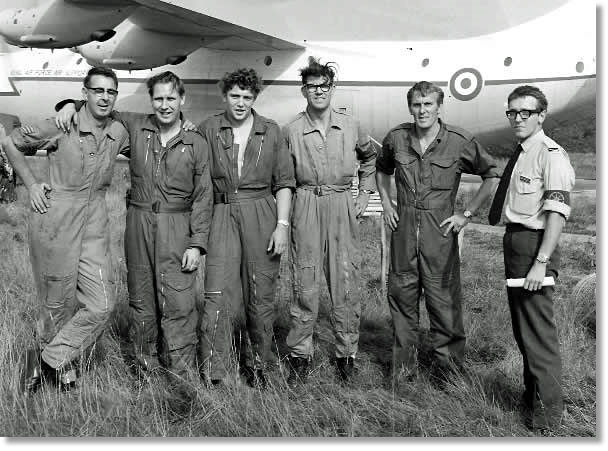
Alpha Team - Værløse, Denmark, 1969
Tony Pyne, Pete Spear, Alan "Boot" Pratt, John Evans, Jack Worrell (Eng) and Dave "Dizzy" Benson.
The Zambian Oil Lift
By Jeremy Porter with Photographs by Ian Stacey
By Jeremy Porter with Photographs by Ian Stacey
The whole operation began for UKMAMS on the 18th of December 1965, when a team departed RAF Abingdon for Dar Es Salaam (Tanzania) with five Britannia's of 99 and 511 Squadrons. Also on their way was a second team destined for Zambia where they would be staying in Lusaka. As far as the British press were concerned the MAMS team in Tanzania were accommodated in the recently finished Kilimanjaro Hotel, which was the pride and joy of the then President Julius Nyere. The harsh reality of life was slightly different for the down route team in Zambia - billeting for these unfortunates was achieved by taking over one wing of a local girls' boarding school.
As an insider will tell you, this sort of arrangement represents an absolute idyll for the average MAMS team. Sadly though, not everyone sees the arrangement through the same rose-coloured spectacles and becomes progressively less well appreciated by the other agencies involved as time goes on. Actually, the convoluted accommodation arrangements for both teams turned out to be slightly different from the standard bed and breakfast and the truth will emerge in its proper chronological order.
As an insider will tell you, this sort of arrangement represents an absolute idyll for the average MAMS team. Sadly though, not everyone sees the arrangement through the same rose-coloured spectacles and becomes progressively less well appreciated by the other agencies involved as time goes on. Actually, the convoluted accommodation arrangements for both teams turned out to be slightly different from the standard bed and breakfast and the truth will emerge in its proper chronological order.
The oil lift came into being as a result of an unstable political situation on the African continent (no surprises there). Zambia is a land-locked state and is therefore dependent on the ports and facilities of neighbouring states for its imports. It was hardly the fault of the Zambian Government that Rhodesia announced its unilateral declaration of independence which annoyed the United Nations sufficiently for them to impose sanctions on Ian Smith's regime. However, part of these sanctions involved the cutting off of oil supplies to Rhodesia, and this is where the problems started for Zambia. Most of Rhodesia's oil came into the country through a pipeline that started in the Mozambique ports where the tankers delivered it having sailed down from the Persian Gulf States. The pipeline, however, didn't terminate in Rhodesia but turned north and crossed into Zambia, feeding them with oil in the same manner as their neighbour. Cutting off the Rhodesians' oil meant turning off the supplies in Mozambique and therefore effectively cutting off the Zambians who, having voted for the sanctions, got justifiably annoyed at the subsequent effect on themselves.
The UN was faced with three options; the first was that they called off the oil sanction, but the UN was quite proud that it had got one of its few resolutions through a vote (quite a novelty) and was determined to see it through. The second option was to ask the Zambian Government to declare UDI as well, thus making them eligible to suffer sanctions, thereby justifying their plight. This however, met with an understandable lack of enthusiasm with the Zambian representatives at the UN and so was similarly discounted. The final option was to keep Zambia supplied whilst the Rhodesians suffered. This was the solution that the UN wanted to pursue, and the concept of the oil lift was born.
The UN was faced with three options; the first was that they called off the oil sanction, but the UN was quite proud that it had got one of its few resolutions through a vote (quite a novelty) and was determined to see it through. The second option was to ask the Zambian Government to declare UDI as well, thus making them eligible to suffer sanctions, thereby justifying their plight. This however, met with an understandable lack of enthusiasm with the Zambian representatives at the UN and so was similarly discounted. The final option was to keep Zambia supplied whilst the Rhodesians suffered. This was the solution that the UN wanted to pursue, and the concept of the oil lift was born.
Obviously, to run an airlift of such magnitude is an expensive proposition. Using the Britannia aircraft, each flight was able to carry around 2,250 gallons of fuel stores from Tanzania to Zambia, whilst the aircraft performing the service would, on its round trip, use approximately 2,700 gallons of fuel getting there and back. It was to be a trial of strength as to which side Rhodesia or "The Rest of The World" would suffer the most and give in first. Purists might venture the notion that in the event the Rhodesians seemed to continue to get oil supplies (almost certainly through South Africa) whilst many businesses in countries overtly supporting the sanctions continued to trade with Rhodesia (albeit slightly less overtly).
This policy is known to the economically inclined nations as commercial expediency, possibly because many politicians themselves have commercial interests. Few politicians are quite so active in the sporting sphere and so sportsmen of whatever persuasion would be tempting early retirement should they try the same tactic. The net result of the sanctions might, at the time, have been construed by the uncharitable as an expensive waste of time and money.
To ensure the airlift was to run smoothly and waste money in the most efficient manner, the teams established in Lusaka and Dar Es Salaam were to receive a small collection of aircraft handling aids. To achieve this, and before the airlift started, MAMS teams in Aden and Nairobi had been busy flying in the necessary heavy equipment previously held at their respective locations. Being traditionalists by nature, the UN stipulated that the oil lift should predominantly move loads of oil. Not surprisingly, the loads were in fact found to be fuel oil destined for both Zambian industry and transport. The operation was set up so that the teams in Dar Es Salaam received the oil from the refineries adjacent to the port, where it was decanted into 45 gallon oil drums. From here it was loaded to the RAF aircraft participating in the operation, flown from the airhead across to Zambia and landed in the capital's Lusaka airport. The team in Lusaka, led by Flying Officer Ian Stacey, would then offload the aircraft and distribute the drums to the authorities, where it was hoped that at least some of it would find its way into the legitimate economy. Other members of the team responsible for this included Sgts: Guthrie and Jim Balls, Cpls Chas Cormack and Brian Dunn, and SACs Roger Bullows and Jimmy Jamieson.
The daily lifts would start at first light and would last until dusk, with the aircraft stopping the nights at Dar Es Salaam. As each aircraft was scheduled to carry out two runs a day, the main bulk of the work was done at midday when the first flight returned and needed to be turned round for the second leg. At midday the temperature often climbed well above 100 Deg F and the humidity strived to join it.
The midday turnarounds were done against the clock, and involved the download of the inbound empty barrels from the Britannia, followed by the reload of the full barrels for the second trip. As there were no mad dogs available to do the work, Englishmen provided the main bulk of the workforce.
The outbound loads were comprised of an average of 50 forty-five gallon oil drums giving a payload of around 21,000 lbs. The drums were stacked in six stacks of eight barrels, with the balance reposing in the rear of the aircraft, depending on passengers to be carried.
Without the need to carry passengers, the aircraft could carry 52 drums, but for the loss of two drums up to four passengers could be flown with the load. As well as the barrels, the aircraft was literally festooned with wooden dunnage to protect the floor and stop the multitude of restraining chains from slipping off of the barrels. To help the team in their task, a freight lift platform was deployed from RAF Lyneham. Unfortunately, this particular piece of equipment had been recently the subject of an AOC's (Air Officer Commanding) inspection. It is one of the more glamorous duties of the AOC to inspect pieces of aircraft handling equipment and satisfy himself that all the nuts and bolts are painted bright red. This ensures that all the nuts and bolts are readily visible, but paradoxically almost impossible to move without paint stripper, a tin of WD 40, and a heavy duty torque wrench. This piece of equipment had sadly passed the inspection.
This policy is known to the economically inclined nations as commercial expediency, possibly because many politicians themselves have commercial interests. Few politicians are quite so active in the sporting sphere and so sportsmen of whatever persuasion would be tempting early retirement should they try the same tactic. The net result of the sanctions might, at the time, have been construed by the uncharitable as an expensive waste of time and money.
To ensure the airlift was to run smoothly and waste money in the most efficient manner, the teams established in Lusaka and Dar Es Salaam were to receive a small collection of aircraft handling aids. To achieve this, and before the airlift started, MAMS teams in Aden and Nairobi had been busy flying in the necessary heavy equipment previously held at their respective locations. Being traditionalists by nature, the UN stipulated that the oil lift should predominantly move loads of oil. Not surprisingly, the loads were in fact found to be fuel oil destined for both Zambian industry and transport. The operation was set up so that the teams in Dar Es Salaam received the oil from the refineries adjacent to the port, where it was decanted into 45 gallon oil drums. From here it was loaded to the RAF aircraft participating in the operation, flown from the airhead across to Zambia and landed in the capital's Lusaka airport. The team in Lusaka, led by Flying Officer Ian Stacey, would then offload the aircraft and distribute the drums to the authorities, where it was hoped that at least some of it would find its way into the legitimate economy. Other members of the team responsible for this included Sgts: Guthrie and Jim Balls, Cpls Chas Cormack and Brian Dunn, and SACs Roger Bullows and Jimmy Jamieson.
The daily lifts would start at first light and would last until dusk, with the aircraft stopping the nights at Dar Es Salaam. As each aircraft was scheduled to carry out two runs a day, the main bulk of the work was done at midday when the first flight returned and needed to be turned round for the second leg. At midday the temperature often climbed well above 100 Deg F and the humidity strived to join it.
The midday turnarounds were done against the clock, and involved the download of the inbound empty barrels from the Britannia, followed by the reload of the full barrels for the second trip. As there were no mad dogs available to do the work, Englishmen provided the main bulk of the workforce.
The outbound loads were comprised of an average of 50 forty-five gallon oil drums giving a payload of around 21,000 lbs. The drums were stacked in six stacks of eight barrels, with the balance reposing in the rear of the aircraft, depending on passengers to be carried.
Without the need to carry passengers, the aircraft could carry 52 drums, but for the loss of two drums up to four passengers could be flown with the load. As well as the barrels, the aircraft was literally festooned with wooden dunnage to protect the floor and stop the multitude of restraining chains from slipping off of the barrels. To help the team in their task, a freight lift platform was deployed from RAF Lyneham. Unfortunately, this particular piece of equipment had been recently the subject of an AOC's (Air Officer Commanding) inspection. It is one of the more glamorous duties of the AOC to inspect pieces of aircraft handling equipment and satisfy himself that all the nuts and bolts are painted bright red. This ensures that all the nuts and bolts are readily visible, but paradoxically almost impossible to move without paint stripper, a tin of WD 40, and a heavy duty torque wrench. This piece of equipment had sadly passed the inspection.
While the team wrestled with the platform, a forklift was recruited locally and was just robust enough to reach the sill height of the aircraft. Using this piece of kit, the loading of the barrels could commence while teams of stevedores struggled to undo the nuts on the platform.
As always, the team members were the very model of sartorial elegance and indulged in their strenuous activities clad in the finest raiment of tropical khaki. This early sort of KD had been specifically designed by the army and required heavy starching if it was to be even vaguely presentable. The reason for this was to catch out slipshod squaddies who tried to pass parade inspections by only pressing their uniform. This 'make it difficult' policy was actively pursued by the military during the sixties, although a further attempt at producing "stay-dull" dust attracting shoes was scrapped by the ministry owing to spiraling costs. So equipped with hard-to-manage uniforms, the teams went to work. The loading of oil drums onto aircraft is not the cleanest of professions and should not be recommended to those with a hyper-sensitive reaction to dirt. Not surprisingly, the work, coupled with the heat and humidity prevalent in the area, did little to improve the appearance of the unstarched UKMAMS team.
The appearance of the movers in the hotel foyer after a day's work did little to support the hotel's claim to a five star rating. This fact actually came to the attention of the President who summoned the detachment commander and re-briefed him on the statuesque and monumental magnificence of his hotel and the standards that the RAF were to maintain to avoid upsetting the other guests. The fact that the RAF detachment were in fact the only guests carried little weight and the detachment was duly obliged to modify its behavior.
To improve their appearance, the MAMS team had ties made bearing a strange motif of mushrooms and oil barrels arranged in diagonal rows on a green background. This design celebrated the fact that the team were now referred to as "mushroom airways" a result of being kept in the dark and fed on manure. On New Year's Eve, the UKMAMS team, mindful of their appearance and resplendent in new suits, were photographed by a local paper dancing in the New Year.
Once again, the President found the dress inappropriate which one might find a rather pedantic attitude were it not for the fact that the team, displaying an ingenious sense of protocol, were in the hotel swimming pool at the time. This time the detachment commander was summoned to the presence of the President again and, despite the best efforts of the diplomatic service, the team were evicted from both the hotel and the country.
Although this state of affairs might seem strange to a person cherishing a more traditional view of military experience, it is not uncommon for members of UKMAMS to be recruited by civilian companies they tend to come across during the course of their duties.
It is less common for their exit from RAF employment to be quite so contentious, many preferring to finish an engagement or purchase their exit before taking up with a more lucrative offer.
It has always been the case that civilian companies involved in transport or logistics tend to find that the members of professional movements organisations such as UKMAMS are particularly good value for money, having been trained and received considerable and diverse experience and all at the British taxpayers' expense.
Shortly after their unscheduled arrival in Kenya, the teams were due to be exchanged. This exchange was to take the form of a shuffle whereby the team in Lusaka were to return to UK to be replaced by the team from Kenya, who in turn would be replaced by a fresh team from the UK. The Lusaka team had been enjoying life a lot more than their up-route counterparts, for a start the working day was shorter and offloads are considerably easier than onloads. This, with the added bonus of staying in a girls' college, must have seemed an enviable attraction to Ian Stacey's team, who up until now had not been noted for their retiring sense of fun.
As always, the team members were the very model of sartorial elegance and indulged in their strenuous activities clad in the finest raiment of tropical khaki. This early sort of KD had been specifically designed by the army and required heavy starching if it was to be even vaguely presentable. The reason for this was to catch out slipshod squaddies who tried to pass parade inspections by only pressing their uniform. This 'make it difficult' policy was actively pursued by the military during the sixties, although a further attempt at producing "stay-dull" dust attracting shoes was scrapped by the ministry owing to spiraling costs. So equipped with hard-to-manage uniforms, the teams went to work. The loading of oil drums onto aircraft is not the cleanest of professions and should not be recommended to those with a hyper-sensitive reaction to dirt. Not surprisingly, the work, coupled with the heat and humidity prevalent in the area, did little to improve the appearance of the unstarched UKMAMS team.
The appearance of the movers in the hotel foyer after a day's work did little to support the hotel's claim to a five star rating. This fact actually came to the attention of the President who summoned the detachment commander and re-briefed him on the statuesque and monumental magnificence of his hotel and the standards that the RAF were to maintain to avoid upsetting the other guests. The fact that the RAF detachment were in fact the only guests carried little weight and the detachment was duly obliged to modify its behavior.
To improve their appearance, the MAMS team had ties made bearing a strange motif of mushrooms and oil barrels arranged in diagonal rows on a green background. This design celebrated the fact that the team were now referred to as "mushroom airways" a result of being kept in the dark and fed on manure. On New Year's Eve, the UKMAMS team, mindful of their appearance and resplendent in new suits, were photographed by a local paper dancing in the New Year.
Once again, the President found the dress inappropriate which one might find a rather pedantic attitude were it not for the fact that the team, displaying an ingenious sense of protocol, were in the hotel swimming pool at the time. This time the detachment commander was summoned to the presence of the President again and, despite the best efforts of the diplomatic service, the team were evicted from both the hotel and the country.
Although this state of affairs might seem strange to a person cherishing a more traditional view of military experience, it is not uncommon for members of UKMAMS to be recruited by civilian companies they tend to come across during the course of their duties.
It is less common for their exit from RAF employment to be quite so contentious, many preferring to finish an engagement or purchase their exit before taking up with a more lucrative offer.
It has always been the case that civilian companies involved in transport or logistics tend to find that the members of professional movements organisations such as UKMAMS are particularly good value for money, having been trained and received considerable and diverse experience and all at the British taxpayers' expense.
Shortly after their unscheduled arrival in Kenya, the teams were due to be exchanged. This exchange was to take the form of a shuffle whereby the team in Lusaka were to return to UK to be replaced by the team from Kenya, who in turn would be replaced by a fresh team from the UK. The Lusaka team had been enjoying life a lot more than their up-route counterparts, for a start the working day was shorter and offloads are considerably easier than onloads. This, with the added bonus of staying in a girls' college, must have seemed an enviable attraction to Ian Stacey's team, who up until now had not been noted for their retiring sense of fun.
As it was to turn out, the boys in Lusaka had really been doing their homework. Although most have declined to volunteer their names and experiences for publication, one of the original members, Mick McMahon, has broken silence to expose some of the exploits. It will therefore come as a great disappointment to those interested to learn that this account will not do likewise. Suffice to say that during the Operation, UKMAMS handled aircraft of Air Canada, BOAC, British Caledonian, Airbridge and Lloyd International, all with a great deal of not unprofitable professionalism.
The UKMAMS team were lucky to have among their number a man who could be described as an investment genius who, on behalf of his colleagues (and quite legally), managed to make the best use of the financial opportunities available. Working on the purest of socialist principles, all money received from the team's investments was used for the benefit of all who contributed. Such was the wisdom and foresight of this "financial security planning" that the UKMAMS team were quite literally able to live on the income without recourse to their hard-earned salary. With so much extra money available, Rest and Relaxation became a more attractive pastime.
To ensure that their members were to be refreshed for the next round of work, the MAMS team, using their investment returns, took out a long term let on a rather charming chalet on the shores of Lake Kariba. Travel to and from the chalet was by way of a minibus graciously donated to the team by a South African who was helping to distribute the fuel being flown into the country. By strange coincidence, the same man was able to ensure that the minibus remained topped up with petrol, although where he managed to find the stuff (which was closely controlled and rationed) will forever remain a mystery. The new team therefore arrived to a well set up operation and were looking forward to a prolonged stay in a girls' school. Unbeknown to Ian Stacey and his team, just before they arrived, the accommodation was changed, possibly as a result of over-fraternization with the locals with whom they were sharing.
The MAMS team found themselves evicted to a local showground, more commonly used and noted for the display of prize cattle. Also accommodated here were the rest of the detachment, which had been rapidly growing to some 400 strong. Most of the other inmates were RAF Regiment (rock apes), who were quite indistinguishable from the cattle that they had replaced and a detachment of Javelin aircraft plus their air and ground crews. This rather large cadre of personnel and equipment was intended as a deterrent against possible aggression against the transport forces conducting the airlift.
As can be imagined, bed spaces were at an absolute premium in the main show hall, with Rock Apes (named after one of their members historically did a rather good monkey impression whilst on holiday in Gibraltar) and pilots all fighting for the area of shallowest cow dung. The team down from Kenya arrived at a bit of a disadvantage, but as luck would have it the out-going team were sufficiently well placed in the affections of the building's owners to have been able to ensure that the VIP balcony over the main show ring was available for the exclusive use of UKMAMS. Not only was the balcony dung free, but it was also roomy and overlooked the main hall. One extra advantage of the balcony was that it had access to the main electrical fuse system for the whole hall. A popular pastime for the MAMS team continued to centre around the timely cancellation of all artificial light at intervals designed to create the maximum chaos for the hordes below attempting to bed down for the night whilst trying to avoid the cattle mess.
The work continued using both military and civil aircraft. BOAC were operating VC-1Os, which had both good capacity and payload. The team also turned round the Airbridge Corvairs which were slightly more limiting, but gave the MAMS team the opportunity of showing the civilians just how efficiently they could utilise the airframe, saving the company a considerable sum and gaining UKMAMS quite a bit of kudos. British Caledonian operated Britannia aircraft but as a standard passenger frame with the seats removed. Despite the unsuitability of the aircraft role fit, the MAMS teams were able to cram on board 40 drums of fuel which represented quite a respectable payload, but all of which had to be loaded through the passenger door.
The UKMAMS team were lucky to have among their number a man who could be described as an investment genius who, on behalf of his colleagues (and quite legally), managed to make the best use of the financial opportunities available. Working on the purest of socialist principles, all money received from the team's investments was used for the benefit of all who contributed. Such was the wisdom and foresight of this "financial security planning" that the UKMAMS team were quite literally able to live on the income without recourse to their hard-earned salary. With so much extra money available, Rest and Relaxation became a more attractive pastime.
To ensure that their members were to be refreshed for the next round of work, the MAMS team, using their investment returns, took out a long term let on a rather charming chalet on the shores of Lake Kariba. Travel to and from the chalet was by way of a minibus graciously donated to the team by a South African who was helping to distribute the fuel being flown into the country. By strange coincidence, the same man was able to ensure that the minibus remained topped up with petrol, although where he managed to find the stuff (which was closely controlled and rationed) will forever remain a mystery. The new team therefore arrived to a well set up operation and were looking forward to a prolonged stay in a girls' school. Unbeknown to Ian Stacey and his team, just before they arrived, the accommodation was changed, possibly as a result of over-fraternization with the locals with whom they were sharing.
The MAMS team found themselves evicted to a local showground, more commonly used and noted for the display of prize cattle. Also accommodated here were the rest of the detachment, which had been rapidly growing to some 400 strong. Most of the other inmates were RAF Regiment (rock apes), who were quite indistinguishable from the cattle that they had replaced and a detachment of Javelin aircraft plus their air and ground crews. This rather large cadre of personnel and equipment was intended as a deterrent against possible aggression against the transport forces conducting the airlift.
As can be imagined, bed spaces were at an absolute premium in the main show hall, with Rock Apes (named after one of their members historically did a rather good monkey impression whilst on holiday in Gibraltar) and pilots all fighting for the area of shallowest cow dung. The team down from Kenya arrived at a bit of a disadvantage, but as luck would have it the out-going team were sufficiently well placed in the affections of the building's owners to have been able to ensure that the VIP balcony over the main show ring was available for the exclusive use of UKMAMS. Not only was the balcony dung free, but it was also roomy and overlooked the main hall. One extra advantage of the balcony was that it had access to the main electrical fuse system for the whole hall. A popular pastime for the MAMS team continued to centre around the timely cancellation of all artificial light at intervals designed to create the maximum chaos for the hordes below attempting to bed down for the night whilst trying to avoid the cattle mess.
The work continued using both military and civil aircraft. BOAC were operating VC-1Os, which had both good capacity and payload. The team also turned round the Airbridge Corvairs which were slightly more limiting, but gave the MAMS team the opportunity of showing the civilians just how efficiently they could utilise the airframe, saving the company a considerable sum and gaining UKMAMS quite a bit of kudos. British Caledonian operated Britannia aircraft but as a standard passenger frame with the seats removed. Despite the unsuitability of the aircraft role fit, the MAMS teams were able to cram on board 40 drums of fuel which represented quite a respectable payload, but all of which had to be loaded through the passenger door.
By contrast, the Corvairs had a range payload performance which meant that only twenty eight drums could be moved at a time. Ironically, the Corvairs had a huge front door and lots of space, having been converted to carry short haul car traffic cross channel. The Royal Canadian Air Force also took part flying C-130s in from the Congo, 108 barrels at a time.
As all the additional units got involved the work, loading in Lusaka gradually crept up to cover the whole of the daylight hours. To keep traveling time to a minimum, UKMAMS acquired a caravan and a cooker that they managed to establish on the Embakasi airfield as a "mobile" crew room. Once again, the team seemed dogged by political problems and, having enjoyed a good few social beers in the airport bar with the local British expats, they were approached by a representation from the government and told that they would have to desist as they were there to help a black nation and not fraternize with the whites. I believe that an offer by the team to reoccupy the girls' college was not taken in the helpful vein in which it was intended and the Government shortly put the airport bar out of bounds. Golf suddenly became popular and MAMS took to patronising the local club and its nineteenth green facilities. Funnily enough, the same expats that used to occupy the airport bar were also keen golfers and so the dangerous liaison was able to continue.
As the Church is keen to make known, "helping others brings its own rewards" and by following a similar investment strategy as their predecessors, the UKMAMS team continued to flourish financially. To UKMAMS, the show ground now began to seem a little down market for people of their standing, although still quite suitable for the Pilots and Regiment personnel. It seemed that the time had come to move. The MAMS team sold their plot in the show ground and moved into a rented house just a stone's throw from a pub called the Pig and Whistle which inevitably became the local. Whilst here, they were visited by a base mover called Cpl Mick Moffatt who came down from Ndola which was occupied by another team of movers from the Air Force Middle East MAMS (a sister organisation to UKMAMS). A lively young man with an unconventional sense of humour when he went home, he took with him a smallish crocodile wrapped in wet cardboard.
Having successfully cleared customs on his return to UK thanks to there not being a question on the declaration form that covered crocodiles, Cpl Moffat deposited the reptile in the ornamental pond of a well-known local hotel. The crocodile remained undetected until the management drained the pool to find out why the ducks, so admired by the public, had been steadily disappearing despite constant restocking. If anyone recalls this incident from the papers, or any of the hotel management recognises the story, you now know the culprit. The crocodile was lucky enough to find refuge in London Zoo, which was its best alternative to being turned into a handbag.
The airlift ended for the civil airlines in July 1966 and the RAF finally pulled out in the following November. The moral of the whole airlift must be that if you are a duck on a pond in an hotel, and see a member of UKMAMS carrying a wet cardboard parcel, be sure you are "Swift to Move".
As a footnote, Charlie Cormack wrote the following in May 2001 regarding the chaps that went over the wall during the operation: The names you want for posterity are Geordie Davison, Dave Rossam and Fergie Ferguson who were all from MEAF MAMS at Dar Es Salaam at the beginning of the oil lift and their team leader was a P/O Wiblin (The Dreaded Piolt Office Wiblin - DPOW!) We had a session on new years eve 1965 in the Kilimanjaro Hotel in Dar Es Salaam, and whilst the aircrew were getting their pictures taken dancing in the pool in full evening dress, the movers were giving it some welly on the roof bar. It was at that stage that the three above mentioned expressed their intentions, as one minute they were going to be sent to Nairobi, and then they were told they were to go back to Aden to complete their tours. Geordie and Dave are still in South Africa to my knowledge, whilst Fergie "gave himself up " as his Mum was not very well and he was subsequently court martialled. His defending officer was one Sqn Ldr Don Clelland who got him off with 84 days and discharge but as he had already done a total very close to that number of days under open arrest, he never had to do any bird.
As all the additional units got involved the work, loading in Lusaka gradually crept up to cover the whole of the daylight hours. To keep traveling time to a minimum, UKMAMS acquired a caravan and a cooker that they managed to establish on the Embakasi airfield as a "mobile" crew room. Once again, the team seemed dogged by political problems and, having enjoyed a good few social beers in the airport bar with the local British expats, they were approached by a representation from the government and told that they would have to desist as they were there to help a black nation and not fraternize with the whites. I believe that an offer by the team to reoccupy the girls' college was not taken in the helpful vein in which it was intended and the Government shortly put the airport bar out of bounds. Golf suddenly became popular and MAMS took to patronising the local club and its nineteenth green facilities. Funnily enough, the same expats that used to occupy the airport bar were also keen golfers and so the dangerous liaison was able to continue.
As the Church is keen to make known, "helping others brings its own rewards" and by following a similar investment strategy as their predecessors, the UKMAMS team continued to flourish financially. To UKMAMS, the show ground now began to seem a little down market for people of their standing, although still quite suitable for the Pilots and Regiment personnel. It seemed that the time had come to move. The MAMS team sold their plot in the show ground and moved into a rented house just a stone's throw from a pub called the Pig and Whistle which inevitably became the local. Whilst here, they were visited by a base mover called Cpl Mick Moffatt who came down from Ndola which was occupied by another team of movers from the Air Force Middle East MAMS (a sister organisation to UKMAMS). A lively young man with an unconventional sense of humour when he went home, he took with him a smallish crocodile wrapped in wet cardboard.
Having successfully cleared customs on his return to UK thanks to there not being a question on the declaration form that covered crocodiles, Cpl Moffat deposited the reptile in the ornamental pond of a well-known local hotel. The crocodile remained undetected until the management drained the pool to find out why the ducks, so admired by the public, had been steadily disappearing despite constant restocking. If anyone recalls this incident from the papers, or any of the hotel management recognises the story, you now know the culprit. The crocodile was lucky enough to find refuge in London Zoo, which was its best alternative to being turned into a handbag.
The airlift ended for the civil airlines in July 1966 and the RAF finally pulled out in the following November. The moral of the whole airlift must be that if you are a duck on a pond in an hotel, and see a member of UKMAMS carrying a wet cardboard parcel, be sure you are "Swift to Move".
As a footnote, Charlie Cormack wrote the following in May 2001 regarding the chaps that went over the wall during the operation: The names you want for posterity are Geordie Davison, Dave Rossam and Fergie Ferguson who were all from MEAF MAMS at Dar Es Salaam at the beginning of the oil lift and their team leader was a P/O Wiblin (The Dreaded Piolt Office Wiblin - DPOW!) We had a session on new years eve 1965 in the Kilimanjaro Hotel in Dar Es Salaam, and whilst the aircrew were getting their pictures taken dancing in the pool in full evening dress, the movers were giving it some welly on the roof bar. It was at that stage that the three above mentioned expressed their intentions, as one minute they were going to be sent to Nairobi, and then they were told they were to go back to Aden to complete their tours. Geordie and Dave are still in South Africa to my knowledge, whilst Fergie "gave himself up " as his Mum was not very well and he was subsequently court martialled. His defending officer was one Sqn Ldr Don Clelland who got him off with 84 days and discharge but as he had already done a total very close to that number of days under open arrest, he never had to do any bird.
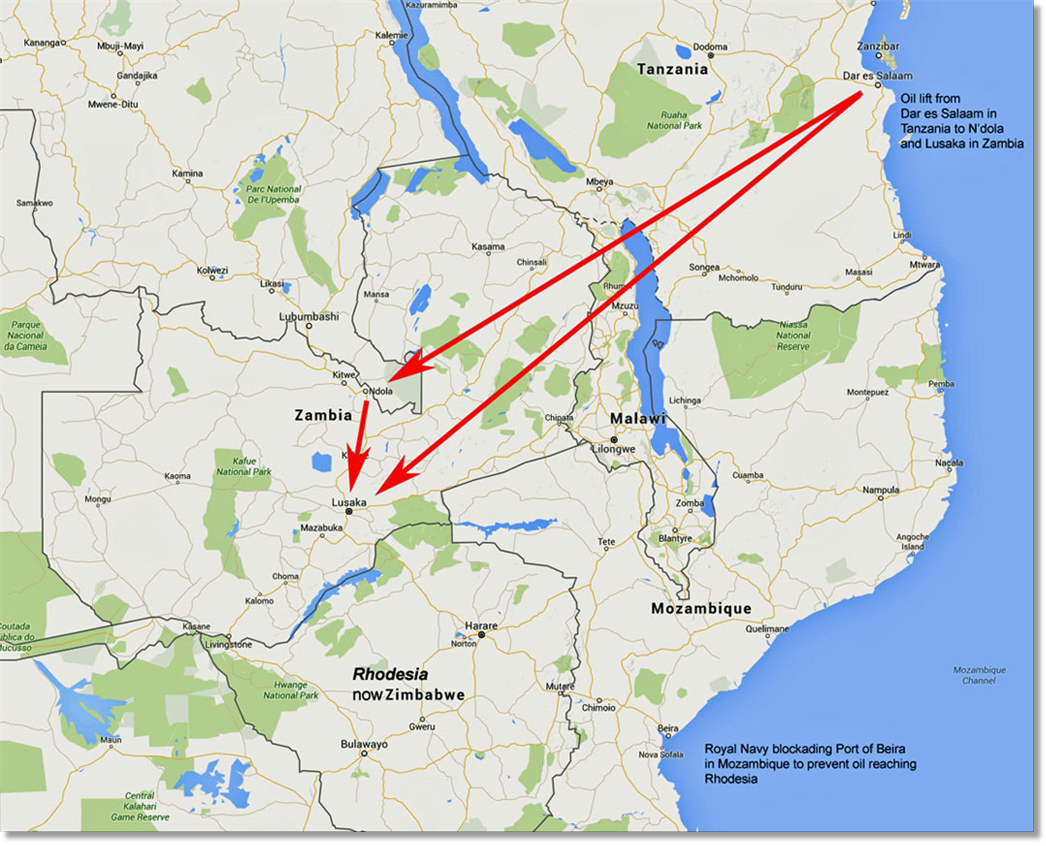
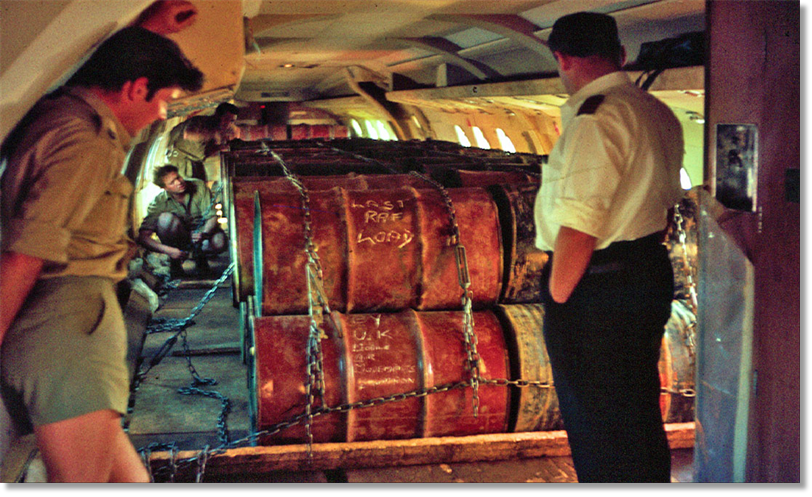
Chas Cormack and Brian Dunn on a British Caledonian Britannia back-loading empties for Dar-Es-Salaam
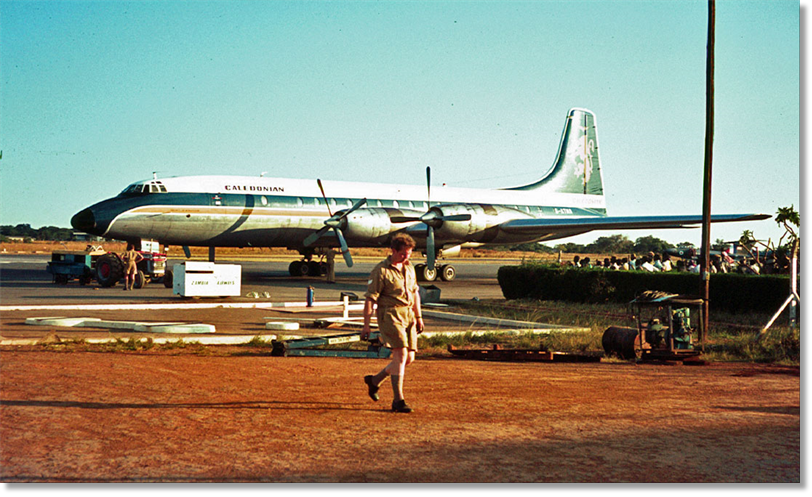
Having completed the back-load, Brian Dunn walks away from the British Caledonian Britannia, which will soon depart for Dar Es Salaam.
These aircraft were difficult to work with as there was no cargo door and all loads had to be manhandled through the passenger doors.
These aircraft were difficult to work with as there was no cargo door and all loads had to be manhandled through the passenger doors.
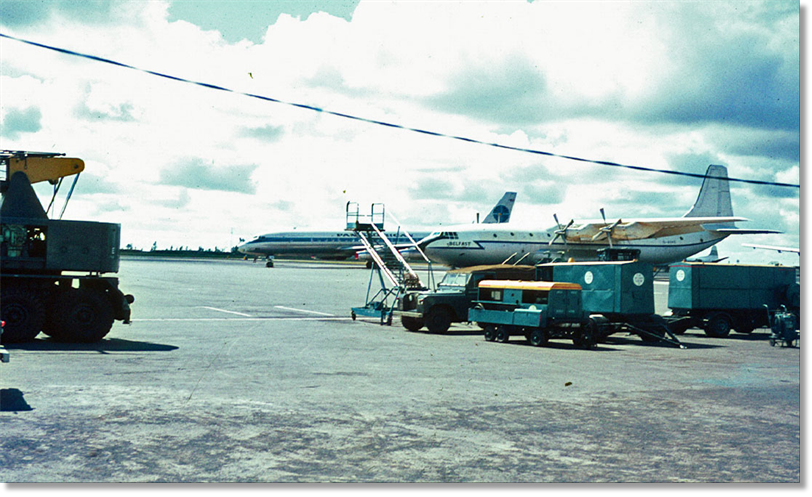
Embakazi Airport - the very first Short Belfast on air trials was roped in to help out. There's a civilian G-XXXX registration number on her which cannot be made out. A UKMAMS Landrover is behind the GPU in the foreground.
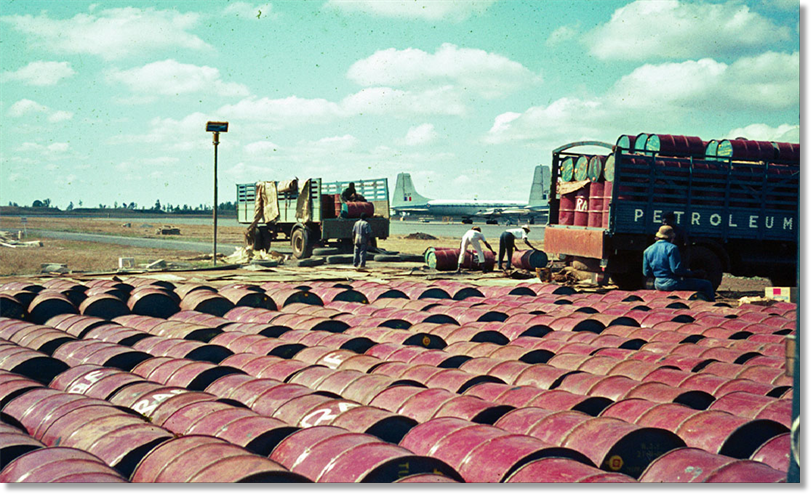
Embakazi Airport, Nairobi - a stockpile of fuel oil awaits to be allocated to transport aircraft for onmove to Zambia
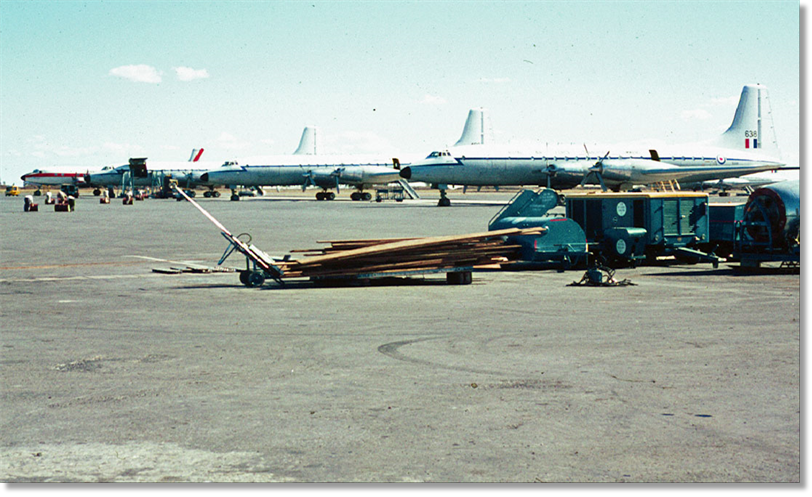
Embakazi - drums of fuel oil being rolled across the tarmac towards a waiting RAF Britannia where they will be loaded to the aircraft with the aid of the Britannia Freight Lift Platform (BFLP).
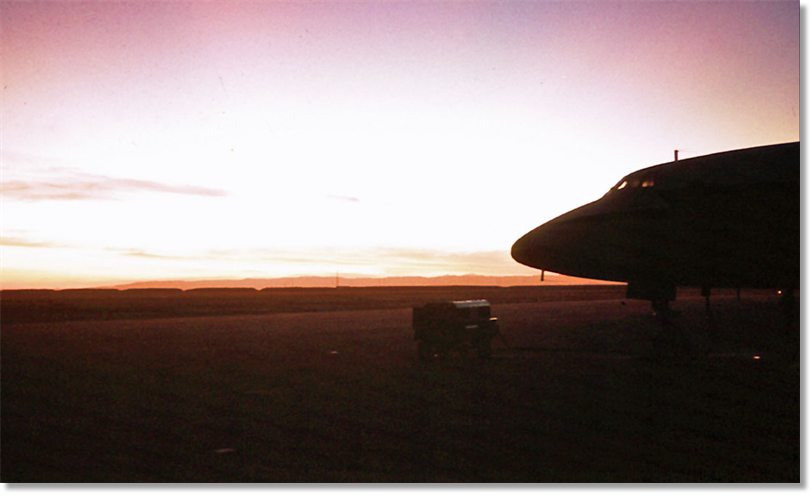
As the sun rises over the African landscape, a Britannia awaits in the relative coolness of the dawn for the work day to commence.
Some down time for the boys - Roger Bullows and Chas Cormack on the lake above the Kariba Dam in the Kariba Gorge of the Zambezi river basin between Zambia and Rhodesia
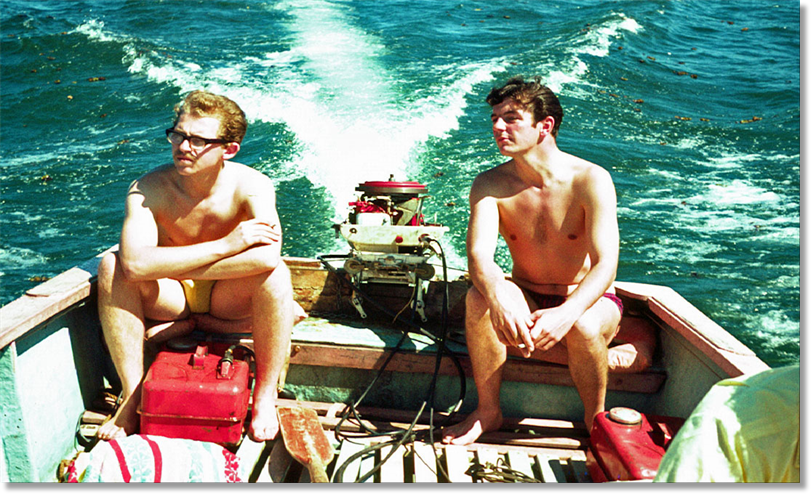
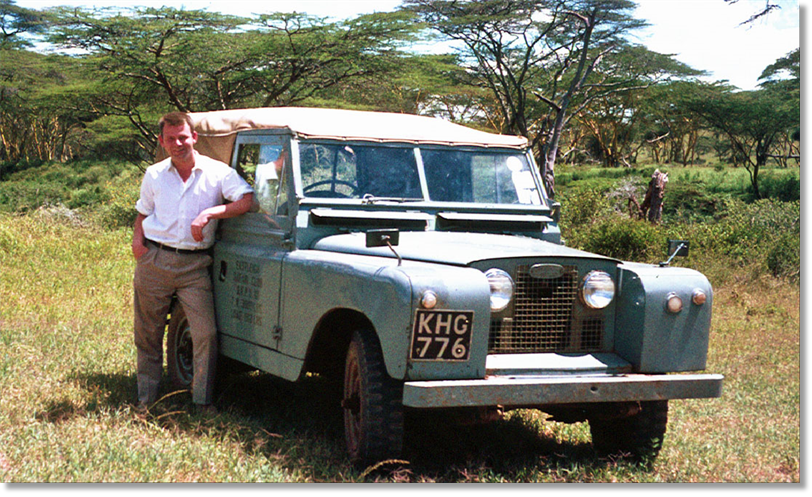
Graham Morgan - one of the original UKMAMS Team Leaders - in the Game Reserve
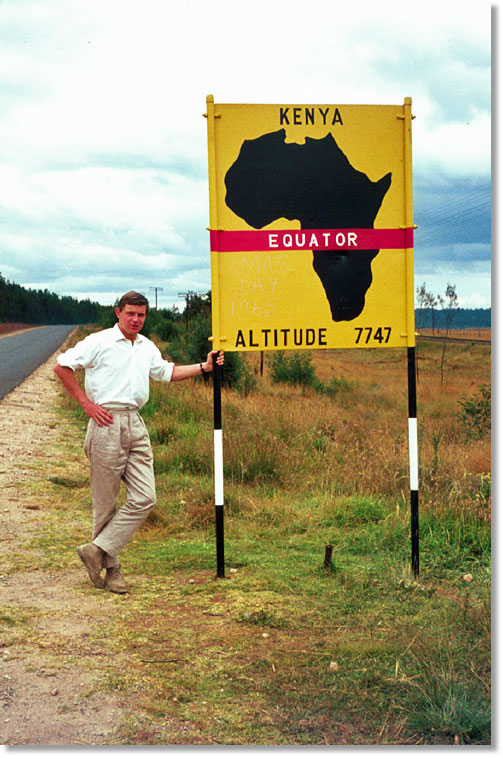
Xmas Day 1965 - Ian Stacey, another original team leader.
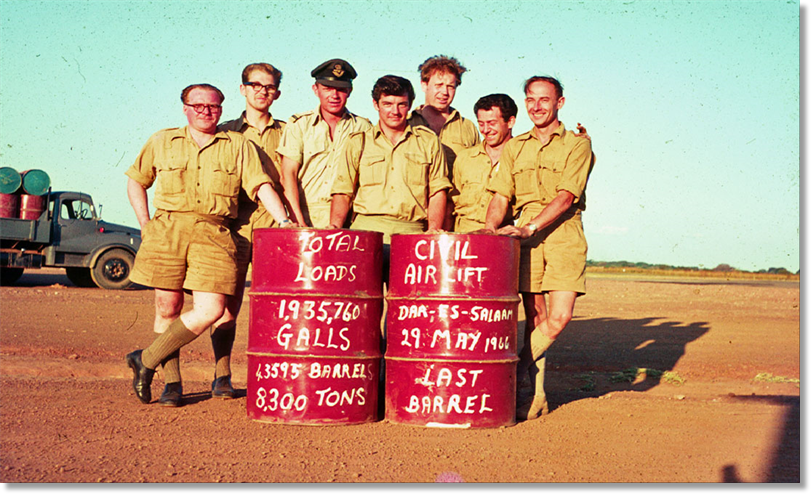
The motley crew of Movers, mostly Delta team UKMAMS: Jim Guthrie, Roger Bullows, Ian Stacey, Charlie Cormack, Brian Dunn, Jimmy Jamieson and Jim Balls.
Algeria
Angola
Benin
Botswana
Burkina Faso
Burundi
Cameroon
Cape Verde
Central African Republic
Chad
Democratic Republic of Congo
Republic of Congo
Cote d'Ivoire
Djibouti
Egypt
Equatorial Guinea
Eritrea
Ethiopia
Gabon
Gambia
Ghana
Guinea
Guinea Bissau
Kenya
Lesotho
Liberia
Libya
Angola
Benin
Botswana
Burkina Faso
Burundi
Cameroon
Cape Verde
Central African Republic
Chad
Democratic Republic of Congo
Republic of Congo
Cote d'Ivoire
Djibouti
Egypt
Equatorial Guinea
Eritrea
Ethiopia
Gabon
Gambia
Ghana
Guinea
Guinea Bissau
Kenya
Lesotho
Liberia
Libya
Madagascar
Malawi
Mali
Mauritania
Mauritius
Morocco
Mozambique
Namibia
Niger
Nigeria
Reunion
Rwanda
Sao Tome and Principe
Senegal
Seychelles
Sierra Leone
Somalia
South Africa
South Sudan
Sudan
Swaziland
Tanzania
Togo
Tunisia
Uganda
Zambia
Zimbabwe
Malawi
Mali
Mauritania
Mauritius
Morocco
Mozambique
Namibia
Niger
Nigeria
Reunion
Rwanda
Sao Tome and Principe
Senegal
Seychelles
Sierra Leone
Somalia
South Africa
South Sudan
Sudan
Swaziland
Tanzania
Togo
Tunisia
Uganda
Zambia
Zimbabwe

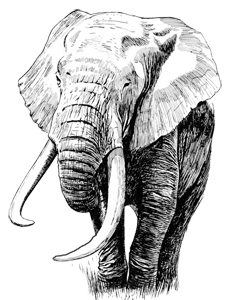
From: Gerry Davis, Bedminster, Somerset
Subject: Africa
My stint on the Oil Lift 1966
Subject: Africa
My stint on the Oil Lift 1966
There is no sound on this video. The last scene shows the Kariba Dam.
When the Oil Lift first got underway in December 1965, UKMAMS operated from an airfield at Dar-es-Salaam in Tanzania, but this caused masses of diplomatic upheaval, so some teams were dispatched to the civil airport at Embakasi in Nairobi, while other teams were sent to both Lusaka and Ndola in Zambia.
Part One - In early January 1966, I was on NEAF MAMS at Akrotiri in Cyprus and was tasked with my team to the Oil Lift. When we arrived in Nairobi, we were accommodated in the Kenyan Air Force billets at RAF Eastleigh until they wanted their billets back because of a large recruitment drive. So from then onwards we dossed down at the Spread Eagle Hotel situated on the outskirts of Nairobi; what a place! All of the small rooms, two beds per, were on the ground floor. Throughout both of my three-month detachments at this place there was a lot of thieving by the African locals taking place.
Part One - In early January 1966, I was on NEAF MAMS at Akrotiri in Cyprus and was tasked with my team to the Oil Lift. When we arrived in Nairobi, we were accommodated in the Kenyan Air Force billets at RAF Eastleigh until they wanted their billets back because of a large recruitment drive. So from then onwards we dossed down at the Spread Eagle Hotel situated on the outskirts of Nairobi; what a place! All of the small rooms, two beds per, were on the ground floor. Throughout both of my three-month detachments at this place there was a lot of thieving by the African locals taking place.
At work we had six RAF Britannia aircraft to play with. Well it eventually settled down to that, as initially all sorts of civilian charter aircraft were commandeered to assist with what we were there for. This was to ferry gasoline to the Zambian airfields of Lusaka and Ndola. The fuel was in 44 gallon drums, 56 of which were loaded into each aircraft which were then chained down to the aircraft floor. It was a lot of heavy work.
The Javelin jet fighters from our base in Cyprus were also dispatched to the Zambian airfields as fighter protection. Before they left Cyprus they all had to be re-painted as they were nearing the end of their shelf life and no two looked alike.
We had 12 African labourers allocated to two 12 hour shifts to help us with all the physical work. Most of them were excellent workers, although one or two did get the chop for various reasons, mostly for not turning up for work. They got paid fortnightly and after getting their hands on the dosh they promptly spent it on booze or paying off loans and were usually skint the following day; their ladies never saw any of it.
The Javelin jet fighters from our base in Cyprus were also dispatched to the Zambian airfields as fighter protection. Before they left Cyprus they all had to be re-painted as they were nearing the end of their shelf life and no two looked alike.
We had 12 African labourers allocated to two 12 hour shifts to help us with all the physical work. Most of them were excellent workers, although one or two did get the chop for various reasons, mostly for not turning up for work. They got paid fortnightly and after getting their hands on the dosh they promptly spent it on booze or paying off loans and were usually skint the following day; their ladies never saw any of it.
I remember one of the African workers telling me that his woman was sick. As I had a packet of Aspirin in my nav bag, I gave them to him. The look on his face was amazing, he was really grateful. Mind you, I don’t know if he ever gave them to her.
The whole detachment of Air Movers and Techies upset the newly appointed Kenyan airport chief security officer. He objected to our apparel, in that we were mostly scruffy as hell and didn’t take any notice of him when he came strutting around. Amongst other things he did not like us doing was eating dressed like this in the airport terminal restaurant or hanging around the arrivals hall oggling all the air hostesses and female passengers. As a result of his intervention from then on we had to dine in the staff canteen.
There was an attempt at using another form of fuel container other than the oil drums on the Britannias. It was a large round rubber ball with a capacity of around 400 gallons and had ‘D’ rings attached on both sides. Following a short trial period they were abandoned as they kept leaking when pressure was applied to the ‘D’ rings from the chains securing them to the aircraft floor. After three months, the other NEAF MAMS team came out to relieve us and do their stint loading all those 44 gallon drums of gasoline. So now we could make our way back to Cyprus.
Part Two - Three months break from the perpetual oil drums passed far too quickly and we took up residence in the Spread Eagle Hotel once more. The six Britannia aircraft were each still doing two sorties a day, loaded with 56 forty-five gallon drums of aviation gasoline flying between 0500 hours and 2200 hours.
On their return flights to Embakasi they often brought back ninety empty drums from Lusaka and Ndola, although the majority of the empty drums were transported overland. The vehicles used were large Fiat lorries with trailers. These vehicles transversed the jungle tracks which often had to be made as they drove along. When it rained they often got stuck in the mud, with African drivers helping each other to get unstuck. On arrival the drums were then checked to see if they were still suitable for air transportation, if they were they were refilled.
Time off was spent exploring the pleasures of the Kenyan capital. Those of us who had a taste for some ale soon developed a liking for the local brew of ‘Tusker’ beer. You honestly had to down gallons of the stuff to dull the effects of those barrels of oil and get rid of the stink of fuel.
One thing worth a mention, on one of our day’s off, three of us decided to partake in a mission to find an Italian nosh house; I really fancied a spaghetti bolognaise. So there we were ambling down Jomo Kenyatta Avenue in Nairobi with our sergeant in the middle, when a young gorgeous English lady hopped right in front of our already red-faced SNCO placing her hand on his chest and in a very sexy voice asking him, “Would you like to come to my flat and listen to music for the afternoon?” The look on his face sort of indicated an imminent heart attack. He spluttered out something to the effect that he was in a hurry and had to get back to work. Well I never, and he was single too! At this time the film “Cowboys in Africa” was being made and we often saw some of the stars relaxing in the Thorn Tree Café of the New Stanley Hotel.
The whole detachment of Air Movers and Techies upset the newly appointed Kenyan airport chief security officer. He objected to our apparel, in that we were mostly scruffy as hell and didn’t take any notice of him when he came strutting around. Amongst other things he did not like us doing was eating dressed like this in the airport terminal restaurant or hanging around the arrivals hall oggling all the air hostesses and female passengers. As a result of his intervention from then on we had to dine in the staff canteen.
There was an attempt at using another form of fuel container other than the oil drums on the Britannias. It was a large round rubber ball with a capacity of around 400 gallons and had ‘D’ rings attached on both sides. Following a short trial period they were abandoned as they kept leaking when pressure was applied to the ‘D’ rings from the chains securing them to the aircraft floor. After three months, the other NEAF MAMS team came out to relieve us and do their stint loading all those 44 gallon drums of gasoline. So now we could make our way back to Cyprus.
Part Two - Three months break from the perpetual oil drums passed far too quickly and we took up residence in the Spread Eagle Hotel once more. The six Britannia aircraft were each still doing two sorties a day, loaded with 56 forty-five gallon drums of aviation gasoline flying between 0500 hours and 2200 hours.
On their return flights to Embakasi they often brought back ninety empty drums from Lusaka and Ndola, although the majority of the empty drums were transported overland. The vehicles used were large Fiat lorries with trailers. These vehicles transversed the jungle tracks which often had to be made as they drove along. When it rained they often got stuck in the mud, with African drivers helping each other to get unstuck. On arrival the drums were then checked to see if they were still suitable for air transportation, if they were they were refilled.
Time off was spent exploring the pleasures of the Kenyan capital. Those of us who had a taste for some ale soon developed a liking for the local brew of ‘Tusker’ beer. You honestly had to down gallons of the stuff to dull the effects of those barrels of oil and get rid of the stink of fuel.
One thing worth a mention, on one of our day’s off, three of us decided to partake in a mission to find an Italian nosh house; I really fancied a spaghetti bolognaise. So there we were ambling down Jomo Kenyatta Avenue in Nairobi with our sergeant in the middle, when a young gorgeous English lady hopped right in front of our already red-faced SNCO placing her hand on his chest and in a very sexy voice asking him, “Would you like to come to my flat and listen to music for the afternoon?” The look on his face sort of indicated an imminent heart attack. He spluttered out something to the effect that he was in a hurry and had to get back to work. Well I never, and he was single too! At this time the film “Cowboys in Africa” was being made and we often saw some of the stars relaxing in the Thorn Tree Café of the New Stanley Hotel.
Another often visited place between shifts was the large market, nearly all the stalls and the shops were owned by the large Indian merchant classes. This is of course before the mass exodus from Kenya, as a result of all the Asians being affected by the new laws brought in 1968 forbidding them to own businesses.
I bought several wooden carvings and some decent books. Back at our Hotel I haggled with one of the African wood carvers for a couple of days for a two foot high carving of a Massai warrior standing on one leg holding a spear and a shield. It was stained to look like ebony, which he professed it was. Anyway he eventually settled for the equivalent of £2. This carving takes pride of place in our living room even today.
As the corporal on the team, I was the only one who had a defined job to carry out. I was responsible for all the paperwork, the driving of the specialist vehicles and trimming the aircraft. On the Oil Lift this also meant driving the 12,000 lb, forklift, operating the lift platform, loading and helping to tie down the barrels of gasoline. There was a standard method of chaining these barrels down to the aircraft floor. The paper work consisted of freight and passenger manifests, six copies of each. There was also a F.Sigs 52 to be sent to the forward airfield and command HQ informing them of the aircraft loads. All the RAF aircraft had a separate trim sheet; all of these documents were very large, consisting of three different coloured copies, with duplicating paper in between. On these forms a graph was drawn, indicating the position, by weight of the loads in marked areas of the freight bay. At the bottom of the forms was a box which the trimming of the aircraft was to fall within, for the aircraft to fly safely. Quite a lot to do within the turn round time, so that the flight schedules could be met.
Another three months passed and it was back to Cyprus.
I bought several wooden carvings and some decent books. Back at our Hotel I haggled with one of the African wood carvers for a couple of days for a two foot high carving of a Massai warrior standing on one leg holding a spear and a shield. It was stained to look like ebony, which he professed it was. Anyway he eventually settled for the equivalent of £2. This carving takes pride of place in our living room even today.
As the corporal on the team, I was the only one who had a defined job to carry out. I was responsible for all the paperwork, the driving of the specialist vehicles and trimming the aircraft. On the Oil Lift this also meant driving the 12,000 lb, forklift, operating the lift platform, loading and helping to tie down the barrels of gasoline. There was a standard method of chaining these barrels down to the aircraft floor. The paper work consisted of freight and passenger manifests, six copies of each. There was also a F.Sigs 52 to be sent to the forward airfield and command HQ informing them of the aircraft loads. All the RAF aircraft had a separate trim sheet; all of these documents were very large, consisting of three different coloured copies, with duplicating paper in between. On these forms a graph was drawn, indicating the position, by weight of the loads in marked areas of the freight bay. At the bottom of the forms was a box which the trimming of the aircraft was to fall within, for the aircraft to fly safely. Quite a lot to do within the turn round time, so that the flight schedules could be met.
Another three months passed and it was back to Cyprus.


From: Tony Street, Buffalo, NY
Subject: Africa
The Number One Bar
Subject: Africa
The Number One Bar
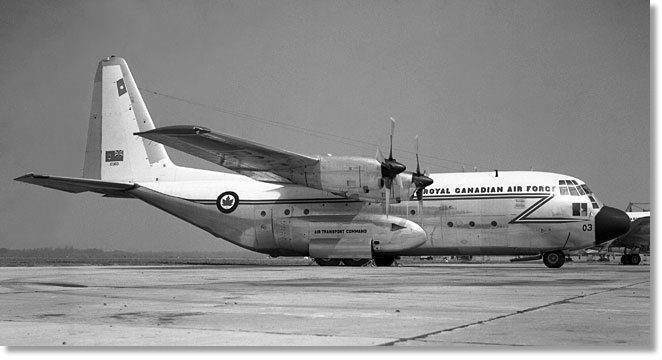
This lighting was augmented when the door of the very old refrigerator was opened and the light came on. A further glow was provided when patrons, either white or black smiled broadly. This effect was enhanced when a joke was told and everybody smiled. Warmly ensconced with a cold beer that came from a funny looking fridge with a coil on its top which sat in a beaded curtained niche, Jim told us the history of Number One Bar:
During WWII many maps were found to be unreliable and useless in planning any type of operations.
Such was the case of maps of Africa. To rectify this, the USAF established the 131,895 1/2 HASAS, LGS, ATG, MA, R/A, WETSU Squadron. Translated: “The One Hundredth and Thirty-One Thousandth Eight Hundred and Ninety Fifth and a Half, High ASA Speed, Low Ground Speed, Medium Altitude Re-photograph Africa, “We Eat This Shit Up!” Squadron.”
The above crack outfit was stationed in Addis Ababa, Ethiopia, during the ‘50s & ‘60s. The Squadron consisted of one air crew, one camera crew and one clapped out C97 aircraft with the photo suit installed in the elevator well. As they had to have less than 10% cloud cover to be able to film, they had a lot of time on their hands. I came upon these guys during a visit to Addis in the 60s.
With their per-diem rate, they couldn’t afford to live in Addis, so they took rooms in an outlying village. African villages are laid out in a hub and spoke fashion with the post office, store, and restaurant and bar occupying the hub building and the cottages radiating along the spokes. The more important you were to the village, the closer you were to the hub.
When these intrepid birdmen flew, they flew for many, many hours to take advantage of the weather. After returning, they faced an hour’s drive to the village and a beer. The beer was warm, of course as there was no refrigeration.
After some thought, they approached the mayor, who being the most important in the village, lived in the hub and ran all the facilities. They suggested, “If we bring in a refrigerator, can we put it behind that little bead curtained niche behind the bar?” They went on, “All we want is the bottom shelf for our beer, and you can have the remaining space for yourself.”
After being told what a refrigerator was and how it worked, the mayor agreed, but pointed out that the village had no electricity.
“Not to worry!” assured the troops.
Prior to the aircraft departing to the Land of The Round Doorknobs for routine maintenance, the replacement aircraft arrived complete with a refrigerator (Surprise!). It was a Westinghouse jobbie with the big old coil on its roof.
The troops assisted the crew with starting the departing bird. When all engines were running, they jumped aboard and stole the auxiliary power unit (APU) that provided power to start the engines, reasoning correctly, that as the engines were running it was no longer required. However, the refrigerator was not running and needed to be started and there were lots more APUs where they were going, so they took the APU and fridge back to the village.
They positioned the fridge in the beaded doorway niche, dug a hole outside behind the bar and installed the APU on a bed of sand. They installed two standpipes, the taller to provide air, the shorter, fuel. They started the APU, plugged in the fridge, boarded over the hole and covered it with dirt. They provided the mayor a jerry can of fuel with the instructions on how to fuel it every day when the sun was at its zenith. There was an instructional fridge filling ceremony held immediately which quickly turned into a full religious ceremony by the Mayor as it gave him much more “Face” in the community.
For many days thereafter, folks came from miles around to witness the daily sacrifice of liquid to the "Gods of The Ground," who were rumbling peacefully below. Some laying on the ground with an ear pressed against the earth as they listened to the otherworldly sounds and felt they were communicating with said Gods and therefor gaining face.
Another amazing part of the whole thing to the villagers was the light going on & off when the door was open/closed. Hmm...does it really go off...or was this more White Wizardry…Hmm?
That is the story of "The Number One Bar" and its arrival into the 20th century. It was the first electrified building in the county.
Such was the case of maps of Africa. To rectify this, the USAF established the 131,895 1/2 HASAS, LGS, ATG, MA, R/A, WETSU Squadron. Translated: “The One Hundredth and Thirty-One Thousandth Eight Hundred and Ninety Fifth and a Half, High ASA Speed, Low Ground Speed, Medium Altitude Re-photograph Africa, “We Eat This Shit Up!” Squadron.”
The above crack outfit was stationed in Addis Ababa, Ethiopia, during the ‘50s & ‘60s. The Squadron consisted of one air crew, one camera crew and one clapped out C97 aircraft with the photo suit installed in the elevator well. As they had to have less than 10% cloud cover to be able to film, they had a lot of time on their hands. I came upon these guys during a visit to Addis in the 60s.
With their per-diem rate, they couldn’t afford to live in Addis, so they took rooms in an outlying village. African villages are laid out in a hub and spoke fashion with the post office, store, and restaurant and bar occupying the hub building and the cottages radiating along the spokes. The more important you were to the village, the closer you were to the hub.
When these intrepid birdmen flew, they flew for many, many hours to take advantage of the weather. After returning, they faced an hour’s drive to the village and a beer. The beer was warm, of course as there was no refrigeration.
After some thought, they approached the mayor, who being the most important in the village, lived in the hub and ran all the facilities. They suggested, “If we bring in a refrigerator, can we put it behind that little bead curtained niche behind the bar?” They went on, “All we want is the bottom shelf for our beer, and you can have the remaining space for yourself.”
After being told what a refrigerator was and how it worked, the mayor agreed, but pointed out that the village had no electricity.
“Not to worry!” assured the troops.
Prior to the aircraft departing to the Land of The Round Doorknobs for routine maintenance, the replacement aircraft arrived complete with a refrigerator (Surprise!). It was a Westinghouse jobbie with the big old coil on its roof.
The troops assisted the crew with starting the departing bird. When all engines were running, they jumped aboard and stole the auxiliary power unit (APU) that provided power to start the engines, reasoning correctly, that as the engines were running it was no longer required. However, the refrigerator was not running and needed to be started and there were lots more APUs where they were going, so they took the APU and fridge back to the village.
They positioned the fridge in the beaded doorway niche, dug a hole outside behind the bar and installed the APU on a bed of sand. They installed two standpipes, the taller to provide air, the shorter, fuel. They started the APU, plugged in the fridge, boarded over the hole and covered it with dirt. They provided the mayor a jerry can of fuel with the instructions on how to fuel it every day when the sun was at its zenith. There was an instructional fridge filling ceremony held immediately which quickly turned into a full religious ceremony by the Mayor as it gave him much more “Face” in the community.
For many days thereafter, folks came from miles around to witness the daily sacrifice of liquid to the "Gods of The Ground," who were rumbling peacefully below. Some laying on the ground with an ear pressed against the earth as they listened to the otherworldly sounds and felt they were communicating with said Gods and therefor gaining face.
Another amazing part of the whole thing to the villagers was the light going on & off when the door was open/closed. Hmm...does it really go off...or was this more White Wizardry…Hmm?
That is the story of "The Number One Bar" and its arrival into the 20th century. It was the first electrified building in the county.


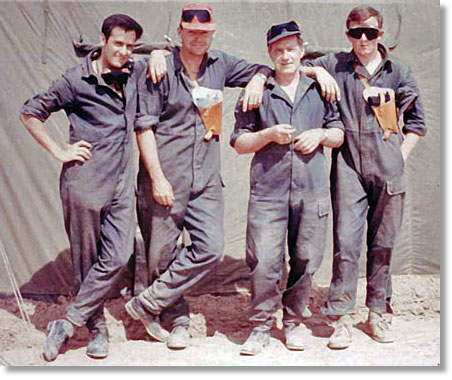
India Team, Got-El-Afraq, Libya, 1968.
Dave Allen, Dave Gillinder, Tommy Benson, Ken Davie.
Dave Allen, Dave Gillinder, Tommy Benson, Ken Davie.
Squadron Leader Bill Jacobs, OC UKMAMS, an HQ element and 4 Teams deployed to Malta, in addition to two teams that were deployed to El Adem, to provide Air Movements facilities for the annual Joint Exercise Crayon (previously named Parula).
On 25th April 1968 India Team and the NEAF Team redeployed to the exercise forward airstrip at Got-El-Afraq to receive Airhead Agencies of 38 Group and the main body of 16 Parachute Brigade, both from the UK via Malta. OC UKMAMS with the remainder of the detachment redeployed from Malta to El Adem on 28th April following completion of transplanement activity.
The recovery of exercise elements by air from Got-El-Afraq to El Adem took place between 3rd and 10th May whilst the tactical phases were still in progress, which provided a severe test of the capability of the 5 teams in El Adem.
The two teams at Got-El-Afrag were required to work at high pressure in difficult conditions. The UKMAMS Teams were rotated from El Adem to gain experience in this type of environment.
On the 7th of May 1968 during a fly-past at the improvised desert strip Got-El-Afraq, Libya, Argosy XR133 flown by John Proctor, flew into the runway, cart wheeled and blew up, according to the official report.
On 25th April 1968 India Team and the NEAF Team redeployed to the exercise forward airstrip at Got-El-Afraq to receive Airhead Agencies of 38 Group and the main body of 16 Parachute Brigade, both from the UK via Malta. OC UKMAMS with the remainder of the detachment redeployed from Malta to El Adem on 28th April following completion of transplanement activity.
The recovery of exercise elements by air from Got-El-Afraq to El Adem took place between 3rd and 10th May whilst the tactical phases were still in progress, which provided a severe test of the capability of the 5 teams in El Adem.
The two teams at Got-El-Afrag were required to work at high pressure in difficult conditions. The UKMAMS Teams were rotated from El Adem to gain experience in this type of environment.
On the 7th of May 1968 during a fly-past at the improvised desert strip Got-El-Afraq, Libya, Argosy XR133 flown by John Proctor, flew into the runway, cart wheeled and blew up, according to the official report.
However, eyewitness reports state that the pilot buzzed the camp, his wing tip clipped a makeshift shower or water tower (50 gallon drum) at the Afraq Hilton (a tent) and they ploughed into the desert with the loss of 11 lives. One wonders how high the shower was.
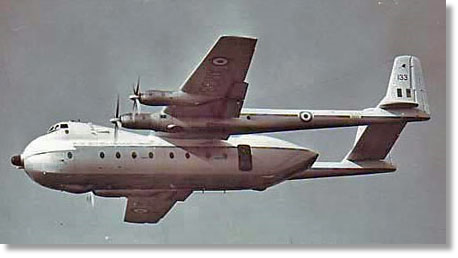
I was able to obtain a crash report from Aviation Safety. The details are very sketchy because of the military need for confidentiality:
Date: 07.05.1968
Type: Armstrong Whitworth AW-650 Argosy C Mk.1
Operator: Royal Air Force - RAF 267 Squadron
Registration: XR133
C/n: 6788
Year built: 1963
Location: Got-El-Afraq (Libya)
Nature: Military
Remarks: Hit obstruction while flying low and crashed.
Date: 07.05.1968
Type: Armstrong Whitworth AW-650 Argosy C Mk.1
Operator: Royal Air Force - RAF 267 Squadron
Registration: XR133
C/n: 6788
Year built: 1963
Location: Got-El-Afraq (Libya)
Nature: Military
Remarks: Hit obstruction while flying low and crashed.
From: Pete Orton, Camberley, Surrey
Subject: Memories of the Dark Continent
Hi Tony,
You are digging up some fantastic memories of my misspent youth. Oh, to be 24 again!
One of the attractions of NEAF MAMS was that Africa was on our patch, and regular army rotations through Nairobi to the BATUK training grounds were fairly regularly fought over between Blue and Red teams. Blue team's arduous Safari through Voi and Tsavo to Mombassa was previously published, along with a classic time capsule foto of 1970s flares, platforms and Sammy's trend-setting droopy tash. Probably worth a reprint: Given custody of an army Landrover, several jerry cans of fuel and water, the odd case of Tusker beer and Coca Cola, Blue Team NEAF MAMS bravely followed in the steps of Stanley and Livingstone. There were some excellent photo opportunities, but in Tsavo National Park, Kenya, we were getting bored with with elephant, giraffe and variations of gazelles; not to mention Dik-Dik and colourful baboons. We wanted lions!
Subject: Memories of the Dark Continent
Hi Tony,
You are digging up some fantastic memories of my misspent youth. Oh, to be 24 again!
One of the attractions of NEAF MAMS was that Africa was on our patch, and regular army rotations through Nairobi to the BATUK training grounds were fairly regularly fought over between Blue and Red teams. Blue team's arduous Safari through Voi and Tsavo to Mombassa was previously published, along with a classic time capsule foto of 1970s flares, platforms and Sammy's trend-setting droopy tash. Probably worth a reprint: Given custody of an army Landrover, several jerry cans of fuel and water, the odd case of Tusker beer and Coca Cola, Blue Team NEAF MAMS bravely followed in the steps of Stanley and Livingstone. There were some excellent photo opportunities, but in Tsavo National Park, Kenya, we were getting bored with with elephant, giraffe and variations of gazelles; not to mention Dik-Dik and colourful baboons. We wanted lions!
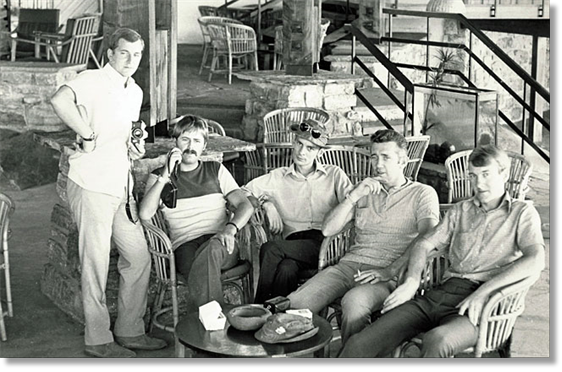
Blue Team NEAF MAMS - Frank Holmes, Colin "Sammy" Allen, Neil Middleton, Pete Cowan, Pete "Kipper" Herring - I was behind the lens.
We had come across some spotty pussy cats having a snooze (we never did work out if they were leopards or cheetah). We craved a little excitement and it was the sighting of a rare white rhino that got our attention. Sammy was driving, and having assessed the surface of the bondu, gently closed in on 4 tons of armour plated hostile mammal. I tried to explain the principal of the telephoto lenses, but the rest of the team convinced me that rhinos were vegan; I just hoped it knew. We got ever closer...
The Rhino is short sighted, relying on sense of smell. As we closed in, the horned beast started to show a mild interest in us. I assume that pheromones of 6 sweaty movers resembled those of a female rhino. The aforementioned 4 tons of horny heavy armour became aroused and started to take an unhealthy interest in Aktotiri's finest. I think he had the honest desire to procreate. Despite a common misconception, a Landrover can outrun a charging rhino. 'Swift to Move' - Sammy proved it! What followed was the finest white-knuckle cross-country ride of a lifetime! The resulting tense silence was potentially toxic.
Now was the time for a good leader to refocus the team. Our attention was directed to the bright blue tail and the fully deployed main gear of a patriarchal male baboon. Frankie's perfectly timed "Look at the stones on that!" became my life-time recovery trigger in future times of tension. Life lessons so hardly won!
The Rhino is short sighted, relying on sense of smell. As we closed in, the horned beast started to show a mild interest in us. I assume that pheromones of 6 sweaty movers resembled those of a female rhino. The aforementioned 4 tons of horny heavy armour became aroused and started to take an unhealthy interest in Aktotiri's finest. I think he had the honest desire to procreate. Despite a common misconception, a Landrover can outrun a charging rhino. 'Swift to Move' - Sammy proved it! What followed was the finest white-knuckle cross-country ride of a lifetime! The resulting tense silence was potentially toxic.
Now was the time for a good leader to refocus the team. Our attention was directed to the bright blue tail and the fully deployed main gear of a patriarchal male baboon. Frankie's perfectly timed "Look at the stones on that!" became my life-time recovery trigger in future times of tension. Life lessons so hardly won!
Several similar opportunities to explore the African bush occurred during the arduous Akrotiri MAMS posting, with the Rift Valley and Lake Naivasha being as familiar to us as Happy Valley Episkopi and the Salt Lake Akrotiri. It was big game watching under brilliant African Skies, and urban wildlife study under Starlight, or shaded by broad rimmed Sombrero hats to get close to the nocturnal omnivore species .
During a Red Team detachment, Pete Cowan and I were diverted on a returning VC10 from Brunei to pick up a cassevac squaddie (injured army chap) who was in a pretty grim state following a bad road traffic accident. I met him 6 months later in Troodos on a skiing course. The real coincidence in this story was that 40 years later I was talking to a British Army paramedic who was with the Anglicans back then and helped load the injured squaddie and handed him over to the aeromed team.
Kenya was a nice little earner as Arthur Daley (aka Frankie Holmes) would have said, due to soft currency and good contacts, nuff said.
Egypt, Sudan, Ethiopia and other bits on the lumpy side of the Indian Ocean were also part of our beat. My boast is that we were flying aid into East Africa decades before Bob Geldorf made it fashionable.
During a Red Team detachment, Pete Cowan and I were diverted on a returning VC10 from Brunei to pick up a cassevac squaddie (injured army chap) who was in a pretty grim state following a bad road traffic accident. I met him 6 months later in Troodos on a skiing course. The real coincidence in this story was that 40 years later I was talking to a British Army paramedic who was with the Anglicans back then and helped load the injured squaddie and handed him over to the aeromed team.
Kenya was a nice little earner as Arthur Daley (aka Frankie Holmes) would have said, due to soft currency and good contacts, nuff said.
Egypt, Sudan, Ethiopia and other bits on the lumpy side of the Indian Ocean were also part of our beat. My boast is that we were flying aid into East Africa decades before Bob Geldorf made it fashionable.
We saw first hand the contrast between the racketeers and corrupt national figures, the grateful smiles of the recipients of relief food, and the hypocrisy of the press. Tear-jerking headlines were composed while sitting around the bar of the Addis Hilton Hotel by Sangria-fuelled journalists on better allowances than us, cajoling their readers to contribute to some despot's Swiss bank account or pension pot.
Two abiding memories from this time are:
1) Seeing aid vehicles still parked on the aircraft pan 6 months after we offloaded and parked them.
2) Midnight skinny-dipping with a Long Island Peace Corps heiress who insisted we did a formation dive before allowing us our budgie smugglers (swimming shorts) back.
It was tough back then, so I have included some more photo's from Blue team's little Bush trip. Africa really does get into your blood!
Two abiding memories from this time are:
1) Seeing aid vehicles still parked on the aircraft pan 6 months after we offloaded and parked them.
2) Midnight skinny-dipping with a Long Island Peace Corps heiress who insisted we did a formation dive before allowing us our budgie smugglers (swimming shorts) back.
It was tough back then, so I have included some more photo's from Blue team's little Bush trip. Africa really does get into your blood!
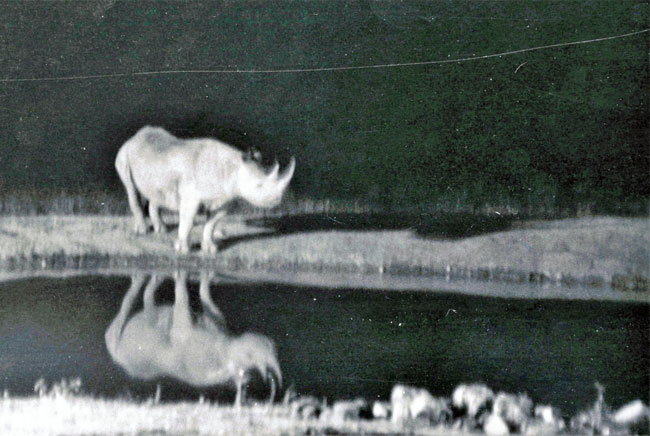

From: Syd Avery, 03140 Guardamar del Segura
Subject: Africa
First visit to Kenya...
Nairobi - Britannia loaded - crew on board - Captain ready to start. We were still waiting for three indulgence pax, a lady and two children. At the very last minute they were rushed across to the aircraft. As she started to go up the steps she tried to explain that the train from Mombasa (the Lunatic Express) had been held up by elephants on the line. Nice story lady, on board please.
Next morning's newspaper - correct - the train had indeed been delayed for several hours by a herd of pachyderms meandering along the track!
On another task, we rolled up in Addis Ababa on a Belfast which struggled to arrive with two 4 tonners (+/- 34,000 lbs) for use in famine relief in the country. Shortly after our arrival, up rolls a CL44 with about 60,000 lbs of tobacco and alcohol products - for the Government! This set me against giving to charities for Africa.
UKMAMS had adopted a children's home a short way outside Nairobi, a place called Kajiado. I had helped collect and pack items to be taken out there by teams, and then one day it was my turn to visit and deliver the boxes. I was completely overwhelmed by the work that the Scottish ladies were doing for the children in particular and the community at large. Calipers and walking sticks and toys which were discarded by children in the UK were gratefully received and the attitude of the children towards these things, and us, was unbelievable.
During my civil flying career, I've been on numerous charity and relief flights to Africa and have seen lots of refugee camps, but I'll never forget those children at Kajiado; seeing all the difference an old football can make.
Does anyone know if Kajiado is still there and supported by the Squadron?
Regards
Syd
Subject: Africa
First visit to Kenya...
Nairobi - Britannia loaded - crew on board - Captain ready to start. We were still waiting for three indulgence pax, a lady and two children. At the very last minute they were rushed across to the aircraft. As she started to go up the steps she tried to explain that the train from Mombasa (the Lunatic Express) had been held up by elephants on the line. Nice story lady, on board please.
Next morning's newspaper - correct - the train had indeed been delayed for several hours by a herd of pachyderms meandering along the track!
On another task, we rolled up in Addis Ababa on a Belfast which struggled to arrive with two 4 tonners (+/- 34,000 lbs) for use in famine relief in the country. Shortly after our arrival, up rolls a CL44 with about 60,000 lbs of tobacco and alcohol products - for the Government! This set me against giving to charities for Africa.
UKMAMS had adopted a children's home a short way outside Nairobi, a place called Kajiado. I had helped collect and pack items to be taken out there by teams, and then one day it was my turn to visit and deliver the boxes. I was completely overwhelmed by the work that the Scottish ladies were doing for the children in particular and the community at large. Calipers and walking sticks and toys which were discarded by children in the UK were gratefully received and the attitude of the children towards these things, and us, was unbelievable.
During my civil flying career, I've been on numerous charity and relief flights to Africa and have seen lots of refugee camps, but I'll never forget those children at Kajiado; seeing all the difference an old football can make.
Does anyone know if Kajiado is still there and supported by the Squadron?
Regards
Syd
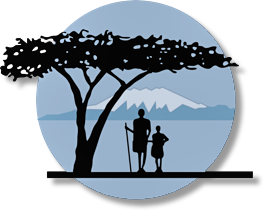
Kajiado is a small town lying about 60 miles south east of Nairobi on the flat plains of Kenya's Maasailand. Nairobi, being quite a popular tourist attraction, has all the trappings of prosperity but unfortunately Kajiado doesn't. Like most of Kenya, wealth and poverty sit side by side separated by a few miles of infertile land. A rough airstrip has enabled the town to attract the attention of the Kenyan Flying Doctor Service and the railway is a primitive but nevertheless effective means of communication. In addition to this, the roads to Kajiado are quite passable during the dry season. Capitalizing on the accessibility of the town, the African Inland Church runs a child care centre in Kajiado.
The centre was built in 1978 by two missionaries; Mrs. Betty Alcock and Mrs. Lorna Egland. A low and not very modern building by Western standards, the centre was built to be a focal point for food distribution to hungry children during the droughts and famines of the late 1970's.
The centre was built in 1978 by two missionaries; Mrs. Betty Alcock and Mrs. Lorna Egland. A low and not very modern building by Western standards, the centre was built to be a focal point for food distribution to hungry children during the droughts and famines of the late 1970's.
The droughts and associated famines are still all too prevalent in the area but the emphasis of the centre has subtly changed. As well as ensuring that he nutritional needs of its' charges are not neglected, the centre also provides medical support for the "local" children suffering from a variety of diseases often aggravated by malnutrition. The children are referred to the centre on the recommendation of the flying doctor who patrols a catchment area of many thousands of square miles. A large number of the children suffer from tuberculosis and trachoma and an appalling number are both crippled and disfigured by polio and skin disorders.
It was against this background that UKMAMS and the Kajiado Centre first met in 1980. Supporting a number of Army exercises in the area, UKMAMS were spending a good deal of time at Jomo Kenyatta Airport and were becoming quite well acquainted with the local area, customs and beverages. It was during this time that UKMAMS adopted the Kajiado Centre as "its charity". For the first few years of the association the UKMAMS contribution was confined to collecting food, bicycles, toys, clothing, garden implements and presents. These were taken by members of UKMAMS to the centre in person during the many visits that were subsequently and are still being made. The centre derived great benefit from these items. A bicycle is a basic yet excellent physiotherapy machine as well as a means of transport to a child who never has and never will walk unaided
Whilst the centre provides medicine and physiotherapy for all those who are sent, not all are cured. Children malnourished and left to squat in their "bomas" (basic Maasai shelters) for long periods of time reach a point beyond which they will never be cured.
The centre itself does not seek to look after its patients until they are fully independent. All children brought into the centre are intended to be returned to their tribe as soon as possible. The return of these aided children to their own has done more than anything else to spread the word to the tribes of Maasai who are indigenous to the area.
It was against this background that UKMAMS and the Kajiado Centre first met in 1980. Supporting a number of Army exercises in the area, UKMAMS were spending a good deal of time at Jomo Kenyatta Airport and were becoming quite well acquainted with the local area, customs and beverages. It was during this time that UKMAMS adopted the Kajiado Centre as "its charity". For the first few years of the association the UKMAMS contribution was confined to collecting food, bicycles, toys, clothing, garden implements and presents. These were taken by members of UKMAMS to the centre in person during the many visits that were subsequently and are still being made. The centre derived great benefit from these items. A bicycle is a basic yet excellent physiotherapy machine as well as a means of transport to a child who never has and never will walk unaided
Whilst the centre provides medicine and physiotherapy for all those who are sent, not all are cured. Children malnourished and left to squat in their "bomas" (basic Maasai shelters) for long periods of time reach a point beyond which they will never be cured.
The centre itself does not seek to look after its patients until they are fully independent. All children brought into the centre are intended to be returned to their tribe as soon as possible. The return of these aided children to their own has done more than anything else to spread the word to the tribes of Maasai who are indigenous to the area.
Kajiado
By Jeremy Porter
By Jeremy Porter
The centre is held in high esteem by the parents of the tribes who think nothing of walking upwards of a hundred miles carrying their child to seek aid. It is a little sad that having been cured, the child will be returned to an uncertain future as no after-care exists in the villages to which they return. The staff at the centre try to maintain contact with the ex-patients but with a country so diverse and rugged it is an uphill task often subjugated to the more immediate needs of the present.
In 1988 Flight Sergeant Tony Dunphy of Delta Team was in the area and had visited the centre with the usual batch of supplies. Here he chanced upon the centre's plans to build a school in the area and a number of smaller school houses in the villages from which their children came. The centre was embarking on an ambitious project of education as well as care, so that the children leaving the centre would possess skills that would aid the tribes to which they were returning. Being a gentleman, Tony enquired if there was anything that UKMAMS might do to assist. Five kilometers from the Kajiado centre is a small village which has a few mud huts and a surround of thorn bushes to keep wild animals out. The village is called Eiti and it was here that UKMAMS accepted the task of building the school hut. The construction was to be 36' by 18' and would be made from concrete blocks with a corrugated tin roof supported by wood. As with most British building firms, UKMAMS had no training in the construction business. Where they did succeed above their commercial counterparts was in the high level of enthusiasm they brought to the task.
There would of course be construction costs and Delta team decided to raise the £1,000 necessary for the project. Walking the length of Hadrian's wall to raise money is a tiring business, but Delta team managed to raise in excess of £2,000. The team then deployed to Kenya under the guise of assisting an Army exercise "Grand Prix". This would give the team two weeks in which to build the school house. Of the two weeks anticipated necessary for the project, four days were lost to work on the exercise and two more to bad weather, cutting the building time in half. A local tradesman by the name of Moses was retained to oversee the enthusiastic, but less than gifted, amateur builders. Moses not only supervised the construction, but also made the "chai" - a hot, sweet smoked milky substance that bore little resemblance to tea as we know it.
At the end of the two weeks construction was unfortunately not finished which was a big disappointment to Flying Office Stu Dainton and his team, missing the "Topping Out" ceremony. The school was officially opened in February of 1990. The abiding memory of the team was one of gratitude to the Kenyans who were the model of hospitality and the cheerful hard working attitude of all of the workers on the project, including the children themselves who became labourers for a fortnight and saw the project to completion.
Today the centre still fulfils its two main aims of nourishment and medical care. The centre also provides a highly regarded programme of education that provides vocational training and allows hundreds of children every year to find a place in secondary education. The centre now also has a nursery for its younger children and looks after youngsters from the age of 18 months to 15 years.
The building projects continue with UKMAMS assistance, still visiting the centre during the ongoing autumn exercises in the area. UKMAMS still raise funds which are used in direct support of the Kajiado centre. Every year the squadron renews a sponsored record attempt to fit the most ever number of people into a Hercules aircraft, all profits of which are allocated to the centre.
In 1988 Flight Sergeant Tony Dunphy of Delta Team was in the area and had visited the centre with the usual batch of supplies. Here he chanced upon the centre's plans to build a school in the area and a number of smaller school houses in the villages from which their children came. The centre was embarking on an ambitious project of education as well as care, so that the children leaving the centre would possess skills that would aid the tribes to which they were returning. Being a gentleman, Tony enquired if there was anything that UKMAMS might do to assist. Five kilometers from the Kajiado centre is a small village which has a few mud huts and a surround of thorn bushes to keep wild animals out. The village is called Eiti and it was here that UKMAMS accepted the task of building the school hut. The construction was to be 36' by 18' and would be made from concrete blocks with a corrugated tin roof supported by wood. As with most British building firms, UKMAMS had no training in the construction business. Where they did succeed above their commercial counterparts was in the high level of enthusiasm they brought to the task.
There would of course be construction costs and Delta team decided to raise the £1,000 necessary for the project. Walking the length of Hadrian's wall to raise money is a tiring business, but Delta team managed to raise in excess of £2,000. The team then deployed to Kenya under the guise of assisting an Army exercise "Grand Prix". This would give the team two weeks in which to build the school house. Of the two weeks anticipated necessary for the project, four days were lost to work on the exercise and two more to bad weather, cutting the building time in half. A local tradesman by the name of Moses was retained to oversee the enthusiastic, but less than gifted, amateur builders. Moses not only supervised the construction, but also made the "chai" - a hot, sweet smoked milky substance that bore little resemblance to tea as we know it.
At the end of the two weeks construction was unfortunately not finished which was a big disappointment to Flying Office Stu Dainton and his team, missing the "Topping Out" ceremony. The school was officially opened in February of 1990. The abiding memory of the team was one of gratitude to the Kenyans who were the model of hospitality and the cheerful hard working attitude of all of the workers on the project, including the children themselves who became labourers for a fortnight and saw the project to completion.
Today the centre still fulfils its two main aims of nourishment and medical care. The centre also provides a highly regarded programme of education that provides vocational training and allows hundreds of children every year to find a place in secondary education. The centre now also has a nursery for its younger children and looks after youngsters from the age of 18 months to 15 years.
The building projects continue with UKMAMS assistance, still visiting the centre during the ongoing autumn exercises in the area. UKMAMS still raise funds which are used in direct support of the Kajiado centre. Every year the squadron renews a sponsored record attempt to fit the most ever number of people into a Hercules aircraft, all profits of which are allocated to the centre.
UKMAMS also has a foreign small change collection scheme which involves passengers returning from abroad depositing their foreign coins into collection boxes where it is aggregated and converted into Sterling. Many civilian organisations send donations to the squadron for Kajiado, and every year RAF Lyneham charities committee donate a substantial sum to the project.
In addition to the funds raised for Kajiado, the squadron also receives medical equipment and welfare goods from a variety of sources which are sent to Kenya on any available airlift travelling to the country. The use of spare RAF capacity in this way is most important to the centre, as without it the resupply of Kajiado would be through highly expensive commercial sources.
UKMAMS are committed to continue their support of the centre and will remain flexible to their requirements as they change. The squadron is proud and gratified to be able to help, and where the suffering of children is involved they are pleased to have the chance to make a difference for the better.
In addition to the funds raised for Kajiado, the squadron also receives medical equipment and welfare goods from a variety of sources which are sent to Kenya on any available airlift travelling to the country. The use of spare RAF capacity in this way is most important to the centre, as without it the resupply of Kajiado would be through highly expensive commercial sources.
UKMAMS are committed to continue their support of the centre and will remain flexible to their requirements as they change. The squadron is proud and gratified to be able to help, and where the suffering of children is involved they are pleased to have the chance to make a difference for the better.

An Interlude - "Africa" by Perpetuum Jazzile
(One of my faves - I get goose bumps every time I watch it...)
(One of my faves - I get goose bumps every time I watch it...)
‘OUT OF AFRICA’ - OPERATION DAMON
BRINGING HOME THE COMMONWEALTH MONITORING FORCE – RHODESIA
(Warning: Some non-PC words are quoted that were then in current use at the time)
BRINGING HOME THE COMMONWEALTH MONITORING FORCE – RHODESIA
(Warning: Some non-PC words are quoted that were then in current use at the time)
From: Len Bowen, Chisholm, ACT
Subject: Memories of Africa
Subject: Memories of Africa
The Lancaster House Agreement, signed on the 21st December 1979, allowed for the creation and recognition of the Republic of Zimbabwe, replacing the unrecognised state of Rhodesia created by Ian Smith's Unilateral Declaration of Independence in 1965. Shortly thereafter military elements from several Commonwealth countries including Australia, New Zealand and Fiji, deployed to establish the Commonwealth Monitoring Force – Rhodesia (CMF-R).
By the end of February 1980 it was agreed that the CMF-R had successfully fulfilled their role, and would be withdrawn with effect from early March.
RAAF Mobile Air Terminal Unit Air Loading Team No1 (MATU ALT1) deployed from Australia by B707 then C130E aircraft to Salisbury/Harare via Johannesburg between 1st and 5th March 1980 to facilitate the withdrawal of the AS, NZ and Fijian elements of the force. The extraction was successfully completed on 5th March, and the Team, together with the New Zealand and Fijian contingents, returned to Australia in three C130 aircraft via Johannesburg, Mauritius, Cocos Island and RAAF Bases Pearce and Edinburgh, finally arriving back at RAAF Base Richmond on 10th March 1980.
By the end of February 1980 it was agreed that the CMF-R had successfully fulfilled their role, and would be withdrawn with effect from early March.
RAAF Mobile Air Terminal Unit Air Loading Team No1 (MATU ALT1) deployed from Australia by B707 then C130E aircraft to Salisbury/Harare via Johannesburg between 1st and 5th March 1980 to facilitate the withdrawal of the AS, NZ and Fijian elements of the force. The extraction was successfully completed on 5th March, and the Team, together with the New Zealand and Fijian contingents, returned to Australia in three C130 aircraft via Johannesburg, Mauritius, Cocos Island and RAAF Bases Pearce and Edinburgh, finally arriving back at RAAF Base Richmond on 10th March 1980.
That is an ‘executive summary’ of my first deployment task as Team Leader of MATU ALT1, and like all executive summaries glosses over the highs and the lows of both the task itself, and my baptism of fire with MATU 1.
I had taken over as Team Leader from FLTLT Barry Hanrahan on 7th January 1980. Barry had been instrumental in setting up the Team, procuring the necessary equipment and generally getting the show on the road from the inception of the MATU concept within the RAAF in 1978/79. I won’t bore our readers with the details of the fine job Barry and his NCOs did, but suffice it to say that he left me with a great bunch of blokes, most of the gear we needed, and a whole world ahead of us to ‘move’ in.
My two years with FEAF MAMS in 1966-68 notwithstanding, I still needed to establish myself as the team boss, and it would take a couple of months or so until Sergeant Lloyd Bradsaw, the Team SNCO, and I worked out the pecking order. That is another story for another place, but suffice it to say that Lloyd and I eventually became both firm friends and highly professional workmates, but as always with a small self-contained team such things take time.
From my ‘new’ office in the old Richmond Base Gatehouse I was still getting my head around the job and to know my blokes when CO MOVCORC (RAAF Movements Coordination Centre), WGCDR Butch Foley called me up. “Len. You and your lads ready to go to Rhodesia?” or words to that effect. Rhodesia? Hell, apart from a one-day recce flight to Barradine in NW NSW in preparation for ‘PELICAN’S PROGRESS 80’, a future working-up exercise for all deployable Richmond-based units, I hadn’t done a single MATU Task since taking over the Team.
I had taken over as Team Leader from FLTLT Barry Hanrahan on 7th January 1980. Barry had been instrumental in setting up the Team, procuring the necessary equipment and generally getting the show on the road from the inception of the MATU concept within the RAAF in 1978/79. I won’t bore our readers with the details of the fine job Barry and his NCOs did, but suffice it to say that he left me with a great bunch of blokes, most of the gear we needed, and a whole world ahead of us to ‘move’ in.
My two years with FEAF MAMS in 1966-68 notwithstanding, I still needed to establish myself as the team boss, and it would take a couple of months or so until Sergeant Lloyd Bradsaw, the Team SNCO, and I worked out the pecking order. That is another story for another place, but suffice it to say that Lloyd and I eventually became both firm friends and highly professional workmates, but as always with a small self-contained team such things take time.
From my ‘new’ office in the old Richmond Base Gatehouse I was still getting my head around the job and to know my blokes when CO MOVCORC (RAAF Movements Coordination Centre), WGCDR Butch Foley called me up. “Len. You and your lads ready to go to Rhodesia?” or words to that effect. Rhodesia? Hell, apart from a one-day recce flight to Barradine in NW NSW in preparation for ‘PELICAN’S PROGRESS 80’, a future working-up exercise for all deployable Richmond-based units, I hadn’t done a single MATU Task since taking over the Team.
A mild panic (on my part anyway) ensued, but after a last minute dash to Canberra to get our Green Australian Diplomatic Passports, with appropriate visas, we were outbound from Richmond on 1st March in B707 A20-629 ‘Windsor Town’ with FLTLT Chenery as skipper. (As an aside, I was still such a ‘new chum’ in Australia in 1980 that I hadn’t yet qualified for Australian citizenship, and accordingly my Diplomatic Passport had ‘Australian Citizen’ crossed out and ‘United Kingdom Citizen’ written in in long hand. Hoped for not too much scrutiny of this down route as it really looked like a ‘do-it-yourself’ forgery!)
Now in March 1980 we’d only had the B707s in service with the RAAF for less than a year, and our first night stop, in Western Australia, was not at RAAF Base Pearce, but at Perth International Airport, as Pearce still had no ground support equipment, not even passenger steps capable of reaching to ‘Seven-Oh’ door height. Damn what a shame, as instead of being in the Pearce transit facilities, we were accommodated with the aircrew in the then-brand new Perth Parmilia Hilton Hotel. Hardships, but we all agreed that we could probably suffer it for one night.
As it transpired, we were actually there for two nights, as the following day when we were supposed to fly on to Mauritius, the skipper told us that the island had been hit by a cyclone and the airport was unusable. This raised one issue. SQNLDR Graham ‘Crumbles’ Crombie, the overall OIC of all three RAAF MATU Teams was already in Mauritius, preparing the ground work for our onward moves to South Africa. Sorry Crumbles, but not our fault you got stuck on a cyclone-swept island while we slummed it round the Parmelia Hilton pool for an extra 24 hours. You can catch up with us later.
We were finally airborne out of Perth at 09:10 on the morning of 3rd March, and arrived at Johannesburg International eleven and a half hours later. This long haul was made less onerous by the fact that we were rationed out of Perth by QANTAS, with silver service meals served to us by the 33SQN cabin staff who were still ‘playing themselves in’ on the Boeings. The hardship was further alleviated by the fact that the night before we left, the skipper had tipped Lloyd and I the wink that as long as we didn’t make a song and dance about it ‘Eric the Eski’ could travel with us as cabin baggage, and if Eric happened to contain a couple or three bottles of choice Margaret River wine, as long as said bottles were empty before we hit the South African Customs there were no problems. QANTAS First Class meals and a glass or two of Western Australia’s best – or at least the best we could afford – was better than a bullet to bite on during the transit. Rough, but somebody had to act as guinea pigs for the cabin crew’s continuation training in preparation for their role when the B707s became the RAAF’s VIP aircraft.
We had a day to kill at Jo’burg while the three 37SQN Hercs caught up with us on the 4th, via a wind-swept Mauritius, but also bearing an equally wind-swept SQNLDR Crombie. He had had to ride out the storm in the Island Airport Hotel, the old Royal Navy Beach Club, and had a few tales to tell over a glass or two in the hotel before we prepared for the deployment forward to Salisbury.
Things got serious in the early hours of the following morning, 5th March, however, when Lloyd, the rest of the team and I boarded C130E A97-176, with SQNLDR Holt, one of the 37SQN Flight Commanders, in the left hand seat. The plan was for the first three C130 sorties to lift out the larger Australian contingent back to Johannesburg, where Graham Crombie would embark them on the B707 for a direct flight back to Perth and then to their home locations, while the Hercs then came back for the Kiwi and Fijian contingents, both comprising about 55 personnel each. These passengers and my team would then travel to Jo’burg overnight, and fly on to Australia via Mauritius, Cocos Island, RAAF Pearce, RAAF Edinburgh and RAAF Richmond, where the MATU Team would leave the PAX for their respective forward journeys on to New Zealand and Fiji. All in all a sound plan, and, ‘spoiler alert’, pretty much as it happened. HOWEVER all was not so smooth sailing in the actual implementation of the airlift.
Now in March 1980 we’d only had the B707s in service with the RAAF for less than a year, and our first night stop, in Western Australia, was not at RAAF Base Pearce, but at Perth International Airport, as Pearce still had no ground support equipment, not even passenger steps capable of reaching to ‘Seven-Oh’ door height. Damn what a shame, as instead of being in the Pearce transit facilities, we were accommodated with the aircrew in the then-brand new Perth Parmilia Hilton Hotel. Hardships, but we all agreed that we could probably suffer it for one night.
As it transpired, we were actually there for two nights, as the following day when we were supposed to fly on to Mauritius, the skipper told us that the island had been hit by a cyclone and the airport was unusable. This raised one issue. SQNLDR Graham ‘Crumbles’ Crombie, the overall OIC of all three RAAF MATU Teams was already in Mauritius, preparing the ground work for our onward moves to South Africa. Sorry Crumbles, but not our fault you got stuck on a cyclone-swept island while we slummed it round the Parmelia Hilton pool for an extra 24 hours. You can catch up with us later.
We were finally airborne out of Perth at 09:10 on the morning of 3rd March, and arrived at Johannesburg International eleven and a half hours later. This long haul was made less onerous by the fact that we were rationed out of Perth by QANTAS, with silver service meals served to us by the 33SQN cabin staff who were still ‘playing themselves in’ on the Boeings. The hardship was further alleviated by the fact that the night before we left, the skipper had tipped Lloyd and I the wink that as long as we didn’t make a song and dance about it ‘Eric the Eski’ could travel with us as cabin baggage, and if Eric happened to contain a couple or three bottles of choice Margaret River wine, as long as said bottles were empty before we hit the South African Customs there were no problems. QANTAS First Class meals and a glass or two of Western Australia’s best – or at least the best we could afford – was better than a bullet to bite on during the transit. Rough, but somebody had to act as guinea pigs for the cabin crew’s continuation training in preparation for their role when the B707s became the RAAF’s VIP aircraft.
We had a day to kill at Jo’burg while the three 37SQN Hercs caught up with us on the 4th, via a wind-swept Mauritius, but also bearing an equally wind-swept SQNLDR Crombie. He had had to ride out the storm in the Island Airport Hotel, the old Royal Navy Beach Club, and had a few tales to tell over a glass or two in the hotel before we prepared for the deployment forward to Salisbury.
Things got serious in the early hours of the following morning, 5th March, however, when Lloyd, the rest of the team and I boarded C130E A97-176, with SQNLDR Holt, one of the 37SQN Flight Commanders, in the left hand seat. The plan was for the first three C130 sorties to lift out the larger Australian contingent back to Johannesburg, where Graham Crombie would embark them on the B707 for a direct flight back to Perth and then to their home locations, while the Hercs then came back for the Kiwi and Fijian contingents, both comprising about 55 personnel each. These passengers and my team would then travel to Jo’burg overnight, and fly on to Australia via Mauritius, Cocos Island, RAAF Pearce, RAAF Edinburgh and RAAF Richmond, where the MATU Team would leave the PAX for their respective forward journeys on to New Zealand and Fiji. All in all a sound plan, and, ‘spoiler alert’, pretty much as it happened. HOWEVER all was not so smooth sailing in the actual implementation of the airlift.
Firstly, shortly after we got airborne out of Johannesburg, the crews were advised that they could not land at the other end, as the Flight Plans were to ‘Salisbury’. Though the formal ceremony was not for another month, independence had been declared at midnight and the capital was now ‘Harare’, and the Air Traffic Control was no longer run by Rhodesians but by Zimbabwean personnel, who were standing on their new-found dignity. Fortunately some rapid exchange of messages, some diplomatic smoothing in the wee small hours, and a formally-agreed change of name on the Flight Plan saw us land safely at Salisbury/Harare at first light.
We were met by a very happy and relieved bunch of Aussie Diggers on the tarmac and we began to prepare individual manifests for the three Hercs and sort out the mountain of baggage that the boys were bringing home. Here the second snag arose. We had been told that there would be a Rhodesian Air Force (RhAF) 10,000 lb fork lift made available for us to handle the baggage pallets once we had built them up and netted them down. Unfortunately unbeknownst to us, shortly before the formal declaration of independence at midnight three Rhodesian Air Force Alouette III helicopter gunships had been stolen by their white Rhodesian crews and flown out of the country to destinations unknown. This had caused a flurry of anger and activity by the new Zimbabwean Army, who had locked down the former RhAF Base under armed guard, 5 miles on the far side of the airfield from the civilian terminal where we were operating. Accordingly no military fork lift of 10,000 lb capacity or any other ex-RhAF capability was now available.
Fortunately after some good liaison work by some members of the Australian Army contingent who had been on the ground for some months we were able to borrow a smaller and rather older fork lift of 5,000 lb capacity (we hoped) from a civilian air freight operation. With Macca McLaren, our ace Team fork lift driver at the wheel and a whole bunch of us hanging off the back to counter-balance the well-over 5K lb weight we were able to get the three baggage pallets onto the respective Herc ramps. The Diggers then emplaned and after a not-so-fond farewell to Rhodesia/Zimbabwe they were on their way to Jo’burg and the tender clutches of Crumbles and the B707 crew.
Meanwhile the New Zealanders and the Fijians had arrived, and we made ourselves known to them, as they would be our travelling companions for the next five days. Both contingents were commanded by a Major from their respective Armies. To my shame I cannot recall the Kiwi Major’s name, but the Fiji CO was Major Arthur Squo-Squo, a Prince of the Royal Fijian blood, a highly professional soldier and a really nice bloke, too. While we waited for the Hercs to complete their five or so hour round trip to Johannesburg and back to Harare we prep’d the next three baggage pallets, making sure that the Kiwis and the Fijians had sufficient loose overnight kit with them so that we didn’t have to de-rig the pallets at each stop along the route.
Also while we waited we watched the British CMF-R contingent and their vehicles being loaded onto several USAF C5s prior to departure to UK. I’m not sure if there were any RAF MAMS personnel involved with the redeployment, certainly I only saw USAF Aerial Port staff handling the loads. Did try to say hello a couple of times, but they were flat strap getting the gear aboard, and by then we had problems of our own. As the day went on more and more local spectators wandered onto the tarmac. Most were of little concern until we noticed that sprinkled among the onlookers were a number of raggedly dressed but well-armed ‘boy soldiers’. These were kids of between, I guess, 10 and 15 years of age, but all carrying AK47s and the odd RPG7 slung over their shoulders. I talked to MAJ Squo-Squo and his Kiwi opposite number about security. Arthur: “We may have a problem here Len. Up to last night these jungle bunnies were terrorists; today they are loyal and honored freedom fighters. They have been told by the new government that the whole damned country is now theirs and that they can do what they bloody well like – and if we’re not exceedingly careful, ‘bloody’ could be the operative word!” “Some of these kids – if you can call them that”, added the NZ Major, “have been in the bush since they were big enough to hold a jungle knife, and though none of them can read or write, they are so indoctrinated by the bloody Zanu or Zapu leaders that they now just know that they own the whole damned place. We are going to have to tread very carefully over the next few hours”…..and such was the case.
We were met by a very happy and relieved bunch of Aussie Diggers on the tarmac and we began to prepare individual manifests for the three Hercs and sort out the mountain of baggage that the boys were bringing home. Here the second snag arose. We had been told that there would be a Rhodesian Air Force (RhAF) 10,000 lb fork lift made available for us to handle the baggage pallets once we had built them up and netted them down. Unfortunately unbeknownst to us, shortly before the formal declaration of independence at midnight three Rhodesian Air Force Alouette III helicopter gunships had been stolen by their white Rhodesian crews and flown out of the country to destinations unknown. This had caused a flurry of anger and activity by the new Zimbabwean Army, who had locked down the former RhAF Base under armed guard, 5 miles on the far side of the airfield from the civilian terminal where we were operating. Accordingly no military fork lift of 10,000 lb capacity or any other ex-RhAF capability was now available.
Fortunately after some good liaison work by some members of the Australian Army contingent who had been on the ground for some months we were able to borrow a smaller and rather older fork lift of 5,000 lb capacity (we hoped) from a civilian air freight operation. With Macca McLaren, our ace Team fork lift driver at the wheel and a whole bunch of us hanging off the back to counter-balance the well-over 5K lb weight we were able to get the three baggage pallets onto the respective Herc ramps. The Diggers then emplaned and after a not-so-fond farewell to Rhodesia/Zimbabwe they were on their way to Jo’burg and the tender clutches of Crumbles and the B707 crew.
Meanwhile the New Zealanders and the Fijians had arrived, and we made ourselves known to them, as they would be our travelling companions for the next five days. Both contingents were commanded by a Major from their respective Armies. To my shame I cannot recall the Kiwi Major’s name, but the Fiji CO was Major Arthur Squo-Squo, a Prince of the Royal Fijian blood, a highly professional soldier and a really nice bloke, too. While we waited for the Hercs to complete their five or so hour round trip to Johannesburg and back to Harare we prep’d the next three baggage pallets, making sure that the Kiwis and the Fijians had sufficient loose overnight kit with them so that we didn’t have to de-rig the pallets at each stop along the route.
Also while we waited we watched the British CMF-R contingent and their vehicles being loaded onto several USAF C5s prior to departure to UK. I’m not sure if there were any RAF MAMS personnel involved with the redeployment, certainly I only saw USAF Aerial Port staff handling the loads. Did try to say hello a couple of times, but they were flat strap getting the gear aboard, and by then we had problems of our own. As the day went on more and more local spectators wandered onto the tarmac. Most were of little concern until we noticed that sprinkled among the onlookers were a number of raggedly dressed but well-armed ‘boy soldiers’. These were kids of between, I guess, 10 and 15 years of age, but all carrying AK47s and the odd RPG7 slung over their shoulders. I talked to MAJ Squo-Squo and his Kiwi opposite number about security. Arthur: “We may have a problem here Len. Up to last night these jungle bunnies were terrorists; today they are loyal and honored freedom fighters. They have been told by the new government that the whole damned country is now theirs and that they can do what they bloody well like – and if we’re not exceedingly careful, ‘bloody’ could be the operative word!” “Some of these kids – if you can call them that”, added the NZ Major, “have been in the bush since they were big enough to hold a jungle knife, and though none of them can read or write, they are so indoctrinated by the bloody Zanu or Zapu leaders that they now just know that they own the whole damned place. We are going to have to tread very carefully over the next few hours”…..and such was the case.
We found that by careful negotiation with the youngsters and a few older ‘freedom fighters’ who arrived later in the day, that we could stop them actually walking in front of the three Hercs as they taxied back in, and from climbing on board as we were doing the loading. The Fijian and the NZ Maori troops played a blinder in diplomatic and peaceful negotiation, aided by bars of compo ration chocolate and cold drinks from Eric and Ernie our two MATU eskis. They also managed to ensure that the safety catches on (most) of the AKs were actually on ‘safe’, and all of the RPGs and other explosives were stacked to the side of the tarmac and away from the aircraft. It must be said that colour was of great importance here, as the young freedom fighters looked on us whites, whether my MATU team or the few white New Zealanders in their contingent, with absolute hatred and disgust, but the Fijians and the Maoris had the right pigmentation to elicit at least some grudging cooperation.
After a somewhat fraught few hours, and another session as trainee America’s Cup yacht crew hanging out off the back to balance the forklift to get the pallets on board, we were on our way just on dusk, and arrived in the Johannesburg International Airport Hotel well into the evening. My team and I were all tired, then having been on the go for some eighteen hours. We were dusty, sweaty and hungry too, after given away most of our ‘spare’ food to the jungle bunnies to keep them out of our way. We were also gasping for a beer. SQNLDR Crombie had done a great job of getting room arranged for the 100+ Kiwis and Fijians, but there was still, to use a Goon Show term, a certain amount of ‘high-powered military milling about’ in the hotel foyer while we got things straight.
I did not therefor appreciate it when a very large white South African came up to me and said in a strong Boer accent “Eh man, who are all these Boys?” Now some of you will know that ‘Boy’ is a derogatory South African term of Coloureds just one up from ‘Kaffir’. That was it! I drew myself up to all of my sweaty smelly 5’ 10” and retorted: “These, sir, are not ‘Boys’! These are the New Zealand and Fijian members of the Commonwealth Peace Keeping Force from Rhodesia!” OK I got the name wrong in the heat of the moment but the effect was still amazing. “What? These boys are just back from Rhodesia? OK! Top Floor Bar! Thirty minutes!” - and turning on his heal he swept out of the foyer.
Still not quite sure what had just happened I passed the word to Crumbles and the two Majors. After several months ‘dry’ in the bush, the blokes didn’t need to be told twice that there was a top floor bar to the hotel, and less than 45 minutes later, after a shower and a change into civvies we all assembled in said bar. There we were greeted by the big Boer and several of his mates, who proceeded announce an “Open bar for the all the Commonwealth boys” (Small ‘b’ in ‘boys’ here, you’ll note). Now I may be being unfair but I would respectively suggest that he and most of his mates had never before spoken to a coloured or truly black man in their lives apart from ordering them around or telling them to “F*** off Kaffir!” That evening none of our 100 or so passengers, my MATU Team or the dozen 37SQN aircrew who were also present were allowed to put their hands in their pockets for one single drink. Every time I tried to put at least some of the Task Imprest money that I was carrying for the whole trip (now dried out after an impromptu swim in the Hilton pool in Perth but that’s another story for another time) on the bar I was told “Hey man. Your money’s no good here. These boys have been in Rhodesia!” I suppose we must also have eaten something for dinner somewhere during that time, but I don’t actually remember!
I eventually went to bed about 2 a.m., having then been on the go for over 24 hours, and with an 06:00 call for an 07:00 bus to the aircraft. I left quite a few of the NZs and Fijians still in full song; quite literally. The house band had wanted to pack up at midnight, but Arthur Squo-Squo had prevailed on me for a couple of hundred Rand from the Imprest – which I hadn’t spent on food – to ‘buy’ at least some of the band instruments for the night, and when I finally went back to my room, some of the Kiwis and Fijians were vying with each other as to who played the best guitar and drums.
After a somewhat fraught few hours, and another session as trainee America’s Cup yacht crew hanging out off the back to balance the forklift to get the pallets on board, we were on our way just on dusk, and arrived in the Johannesburg International Airport Hotel well into the evening. My team and I were all tired, then having been on the go for some eighteen hours. We were dusty, sweaty and hungry too, after given away most of our ‘spare’ food to the jungle bunnies to keep them out of our way. We were also gasping for a beer. SQNLDR Crombie had done a great job of getting room arranged for the 100+ Kiwis and Fijians, but there was still, to use a Goon Show term, a certain amount of ‘high-powered military milling about’ in the hotel foyer while we got things straight.
I did not therefor appreciate it when a very large white South African came up to me and said in a strong Boer accent “Eh man, who are all these Boys?” Now some of you will know that ‘Boy’ is a derogatory South African term of Coloureds just one up from ‘Kaffir’. That was it! I drew myself up to all of my sweaty smelly 5’ 10” and retorted: “These, sir, are not ‘Boys’! These are the New Zealand and Fijian members of the Commonwealth Peace Keeping Force from Rhodesia!” OK I got the name wrong in the heat of the moment but the effect was still amazing. “What? These boys are just back from Rhodesia? OK! Top Floor Bar! Thirty minutes!” - and turning on his heal he swept out of the foyer.
Still not quite sure what had just happened I passed the word to Crumbles and the two Majors. After several months ‘dry’ in the bush, the blokes didn’t need to be told twice that there was a top floor bar to the hotel, and less than 45 minutes later, after a shower and a change into civvies we all assembled in said bar. There we were greeted by the big Boer and several of his mates, who proceeded announce an “Open bar for the all the Commonwealth boys” (Small ‘b’ in ‘boys’ here, you’ll note). Now I may be being unfair but I would respectively suggest that he and most of his mates had never before spoken to a coloured or truly black man in their lives apart from ordering them around or telling them to “F*** off Kaffir!” That evening none of our 100 or so passengers, my MATU Team or the dozen 37SQN aircrew who were also present were allowed to put their hands in their pockets for one single drink. Every time I tried to put at least some of the Task Imprest money that I was carrying for the whole trip (now dried out after an impromptu swim in the Hilton pool in Perth but that’s another story for another time) on the bar I was told “Hey man. Your money’s no good here. These boys have been in Rhodesia!” I suppose we must also have eaten something for dinner somewhere during that time, but I don’t actually remember!
I eventually went to bed about 2 a.m., having then been on the go for over 24 hours, and with an 06:00 call for an 07:00 bus to the aircraft. I left quite a few of the NZs and Fijians still in full song; quite literally. The house band had wanted to pack up at midnight, but Arthur Squo-Squo had prevailed on me for a couple of hundred Rand from the Imprest – which I hadn’t spent on food – to ‘buy’ at least some of the band instruments for the night, and when I finally went back to my room, some of the Kiwis and Fijians were vying with each other as to who played the best guitar and drums.
Amazingly enough everyone made their bleary way onto the busses to the aircraft by 07:15 or thereabouts, and my Log Book records that at 08:30 we were airborne in A67-172 with FLTLT Martin at the helm, with a seven hour fifty minute flight to Mauritius ahead of us. The ‘evening’ in the Top Bar at Jo’burg set the pattern for the rest of the trip back to Oz, with an alcoholic Crew Rest Day at Mauritius, an boozy over night at Cocos, an evening lost in the haze at RAAF Pearce, and so to Richmond. At least the evening's carousing made the long days down the back of the Herc almost bearable as we slept most of the time – though I did read Colleen McCollough’s ‘The Thorn Birds’ in one sitting in the eight hours twenty between Mauritius and Cocos. Gawd that is a depressing book – or it may just have been a raging hangover after 24 hours on Mauritius rum the day before.
Someday the full story of the rest of the return home may be told, but in the meantime ‘what happens down route stays down route’. Suffice it to say that by the time we arrived back at Richmond, MATU ALT1 was a cohesive, if somewhat exhausted group. They had found that their new Pommy boss wasn’t too bad, and at least (a) he knew something about air movements and (b) he liked a drink or three with the blokes (which, indecently, he knew where to find locally and very cheaply on Mauritius from his previous FEAF MAMS days). My team and I were to go on to do a further twenty seven tasks together before I was promoted and kicked upstairs to take over as SMOVO RIC in May 1981, but few as taxing and none as personally stressful – but also as satisfying - as my introduction to MATU 1 life on OP DAMON.
Someday the full story of the rest of the return home may be told, but in the meantime ‘what happens down route stays down route’. Suffice it to say that by the time we arrived back at Richmond, MATU ALT1 was a cohesive, if somewhat exhausted group. They had found that their new Pommy boss wasn’t too bad, and at least (a) he knew something about air movements and (b) he liked a drink or three with the blokes (which, indecently, he knew where to find locally and very cheaply on Mauritius from his previous FEAF MAMS days). My team and I were to go on to do a further twenty seven tasks together before I was promoted and kicked upstairs to take over as SMOVO RIC in May 1981, but few as taxing and none as personally stressful – but also as satisfying - as my introduction to MATU 1 life on OP DAMON.
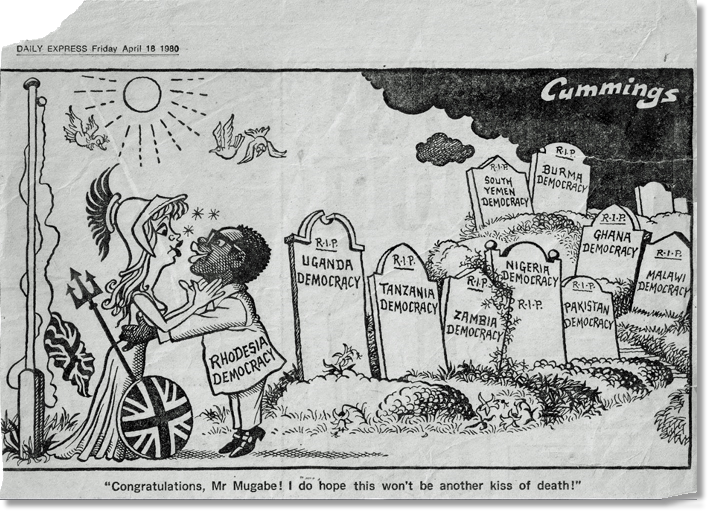
Operation Agila - From Rhodesia to Zimbabwe
By Jeremy Porter
By Jeremy Porter
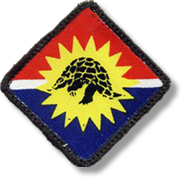
Christmas was coming, the goose was on a diet and on 19th December 1979 UKMAMS was on its way to Rhodesia. The first activation elements of UKMAMS departed in the air conditioned comfort of a VC10 from Brize Norton to Salisbury.
The task was to receive a UK monitoring force in Rhodesia to oversee the handover from the current white Rhodesian government to a more democratic system. In the process the country would be renamed Zimbabwe.
For six weeks prior to the operation, two teams of UKMAMS personnel were put onto standby waiting the outcome of the political wrangling before they could get started. During this time they were unable to take leave or be allocated to other tasks, effectively confining them to the MAMS crewroom at RAF Lyneham. When the call finally came to go ahead the initial elements of UKMAMS departed by VC10, whilst the remainder followed on in the C130 Hercules aircraft allocated to the task.
The task was to receive a UK monitoring force in Rhodesia to oversee the handover from the current white Rhodesian government to a more democratic system. In the process the country would be renamed Zimbabwe.
For six weeks prior to the operation, two teams of UKMAMS personnel were put onto standby waiting the outcome of the political wrangling before they could get started. During this time they were unable to take leave or be allocated to other tasks, effectively confining them to the MAMS crewroom at RAF Lyneham. When the call finally came to go ahead the initial elements of UKMAMS departed by VC10, whilst the remainder followed on in the C130 Hercules aircraft allocated to the task.
In Rhodesia the departing government's decision to abrogate power did not enjoy the unanimous support of the entire population. There were also elements in the country that were not entirely charitable to the nominal role of the proposed government. The Rhodesians were confidently predicting trouble, and it was thought prudent to warn the British military that their aircraft ran the risk of being shot at. This meant that the normal straight in approach favoured by the passengers and all but the most gung-ho of crew flying transport aircraft had to be abandoned in favour of a more tactical approach. This manoeuvre involved turning up over the airfield at almost cruising height, and then rapidly descending in a spiral dive, before levelling out and hitting the ground, hopefully in the vicinity of the airfield.
It was because of these aggressively inclined individuals that it was deemed prudent to invite a police force to monitor the handover of power and discourage disruptive elements from becoming over vociferous during the transition. UKMAMS was tasked to outload and receive this force into Zimbabwe, and lend tone to what could otherwise become a rather vulgar episode in British military history. Despite the best efforts of our military high command there was to be no advance party pre-positioned in Rhodesia to organize the reception of the UKMAMS detachment and so it seemed that the advance party would need to be rather self sufficient. The Royal Corps of Transport did however manage to get one Major and a Warrant Officer to Rhodesia in time to organize the accommodation for the team, which couldn't have been worse. Those people familiar with the interaction between UKMAMS and the RCT will be aware that a rivalry exists which from time to time manifests itself in strongly held beliefs being expressed in a not un-physical fashion in certain Wiltshire public establish-ments.
The RCT made the most of this God sent opportunity, and booked the incoming MAMS team into what could only be described as a hotel by someone with an extremely generous nature. Whilst the contract and costs seemed to indicate that full board was appropriate the proprietor insisted that meal times were to be rigidly adhered to. The flying programme had not been drafted with this in mind, and the command staff taskers were strangely unwilling to delay the onset of a nations democracy to suit the wishes of a seedy hotel owner.
It was because of these aggressively inclined individuals that it was deemed prudent to invite a police force to monitor the handover of power and discourage disruptive elements from becoming over vociferous during the transition. UKMAMS was tasked to outload and receive this force into Zimbabwe, and lend tone to what could otherwise become a rather vulgar episode in British military history. Despite the best efforts of our military high command there was to be no advance party pre-positioned in Rhodesia to organize the reception of the UKMAMS detachment and so it seemed that the advance party would need to be rather self sufficient. The Royal Corps of Transport did however manage to get one Major and a Warrant Officer to Rhodesia in time to organize the accommodation for the team, which couldn't have been worse. Those people familiar with the interaction between UKMAMS and the RCT will be aware that a rivalry exists which from time to time manifests itself in strongly held beliefs being expressed in a not un-physical fashion in certain Wiltshire public establish-ments.
The RCT made the most of this God sent opportunity, and booked the incoming MAMS team into what could only be described as a hotel by someone with an extremely generous nature. Whilst the contract and costs seemed to indicate that full board was appropriate the proprietor insisted that meal times were to be rigidly adhered to. The flying programme had not been drafted with this in mind, and the command staff taskers were strangely unwilling to delay the onset of a nations democracy to suit the wishes of a seedy hotel owner.
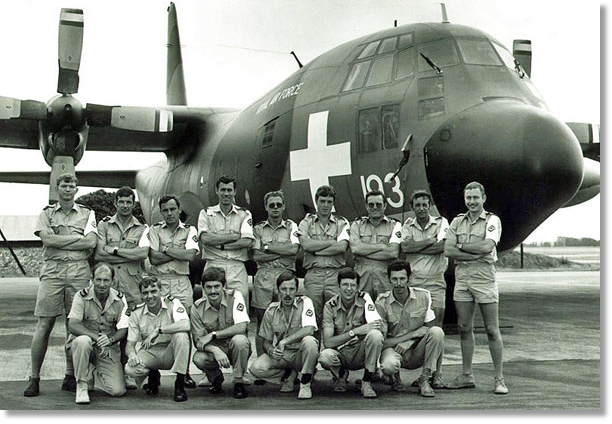
At the time this was considered to be a deliberate manifestation of a new country's first democratic policy. Its intended goal seemed to hinge on making the whole population the same colour, removing once and for all the last hint of colour prejudice. The hotel also boasted a laundry service that could return half of your washing within forty eight hours. No one found out exactly what had happened to the teams other 50%, but no doubt it found its way into the local economy.
Alerted to the fact that his troops were getting thin, (as well as dirty) and were in danger of panicking locals into thinking that widespread famine was imminent, the boss despatched a reconnaissance team into town to seek out a more advanced civilization. As the old maxim states that "time spent in reconnaissance is seldom time wasted" and the team were gratified to find a much better prospect. The new hotel had single rooms, provided a round the clock catering service, had a free to residents disco, and a swimming pool. All this and for only half the price of the original Stalag. Being on an imprest (which is a large sum of money freely given to cover expenses) the team enjoyed a certain independence and payment would not be a problem. MAMS duly went up-market.
The airlift commenced using our own VC10 and Hercules aircraft. As capable as these aircraft were they could not quite cope with the armoured land rovers and larger helicopters that needed to be airlifted into theatre. To assist in this the USAF came to our rescue with their C5 and C141 aircraft with the greater carrying capacity that they offered
Alerted to the fact that his troops were getting thin, (as well as dirty) and were in danger of panicking locals into thinking that widespread famine was imminent, the boss despatched a reconnaissance team into town to seek out a more advanced civilization. As the old maxim states that "time spent in reconnaissance is seldom time wasted" and the team were gratified to find a much better prospect. The new hotel had single rooms, provided a round the clock catering service, had a free to residents disco, and a swimming pool. All this and for only half the price of the original Stalag. Being on an imprest (which is a large sum of money freely given to cover expenses) the team enjoyed a certain independence and payment would not be a problem. MAMS duly went up-market.
The airlift commenced using our own VC10 and Hercules aircraft. As capable as these aircraft were they could not quite cope with the armoured land rovers and larger helicopters that needed to be airlifted into theatre. To assist in this the USAF came to our rescue with their C5 and C141 aircraft with the greater carrying capacity that they offered
Clearly over excited at the onset of a "one man one vote" system the proprietor put the meal issue to the vote. It was just bad luck that in this the first of Zimbabwe's democratic elections only one man cast one vote, and meals were off. The rooms although shared between four men did however boast a wide selection of en-suite facilities. The bath was an unplumbed-in metal tank that would only be filled once a day by order of the management. However this cunningly built contrivance was multi purpose. The tub without modification also doubled as a toilet, a bidet, and by waiting for someone to breath in and holding his head underwater you could relax in a quite passable Jacuzzi. It soon dawned upon the team that something had to be done about the accommodation. When taking a bath it was preferable to be first as the water would be cleanest, and if fortunate, might well be slightly above ambient room temperature. By the same token it was imperative to lay claim to this facility before those wishing to relieve themselves as although the water would be slightly warmer, washing was a more hazardous exercise. Of course the later down the bathing list you were the more filthy the water became.
The RCT movers were also in theatre, as a liaison between the Army and the RAF. This is quite natural as the Army don't understand airplanes, and the RAF find it difficult to understand the grunts that the Army make in place of normal speech. The RCT do not understand even the simplest of concepts, and are therefore used as interpreters between blue and brown. Since arriving the RCT had not been idle (a novel state of affairs) and had erected a charming blue and white "stripy" tent which was to become the reception area for incoming loads. Once you have put up a tent it is human nature for its owners to feel duty bound to loiter within its confines as if to justify its existence. The RCT are no exception to this rule and, after a memorable communiqué to the corridors of power back in the UK the phrase "loitering with intent" passed into common usage.
Once the RCT had settled in and realized that contrary to all expectations they were neither mentally or physically exhausted by the tent erection, they became quite adventurous. It soon became evident that they thought they should have control of the aircraft handling-area at Salisbury airport. Only after prolonged arguments did they concede that their territory began at the edge of the aircraft handling area. This blue/brown demarcation philosophy was rigorously enforced by the RAF movers by the simple expedient of driving the MAMS vehicles at high speed towards any RCT personnel who deliberately or inadvertently transgressed the divide. And so it was in the spirit of co-operation so characteristic of joint operations that a larger potential territorial dispute was to be averted by troops bitterly engaged in a more minor one of their own.
Salisbury airport is divided into halves. One half was allocated to the civil air transport world, whilst the other, called New Sarum, was given over to the Rhodesian Air Force. The former of the two was running alive with charming stewardesses and luxurious facilities, we of course got the latter. Many of the arriving troops were due to be flown up country shortly after arriving in Zimbabwe, and whilst we loaded the freight in the military side the passengers were processed through the civil side. Often the mighty Hercules would, once loaded, have to taxi across the airfield to the main terminal to collect its passengers relegating the pilots to the role of a taxi driver (confirming a suspicion that we had entertained for some time).
During the lift we were handling our aircraft and the American monstrosities as well as civilian charter flights hired to the airlift At times we had more aircraft than MAMS personnel - a situation that I feel will never change... it's called planning.
Not only were we responsible for loading the aircraft at Salisbury, but we were also responsible for accompanying the flights "up country" to complete the off- loads at the unit being moved's designated location. To accomplish this we split the team into two halves, and then further subdivided one half into two man teams who were to deliver and de-plane the loads. We handled the airland side of the operation whilst 47 Air Despatch RCT managed the airdrop sorties. Air land operations on the sort of strips found up country are very taxing on the aircraft, and recurrent unserviceabilities were not uncommon.
This meant that the aircraft configured for airdrop fared far better than those used for airland. It was therefore inevitable that to achieve the task we had to hijack the odd aircraft and indulge in some very imaginative aircraft reroling which unfortunately took a heavy toll on the nerves of the Air Load Master fraternity. It is prudent to mention at this stage that the role of the ALM centres around the production of coffee for the rest of the crew, a job that occupies the bulk of their time and intellectual capacity. Not noted for their in depth knowledge of aircraft loading, they tend to stick to the rules.
Once the RCT had settled in and realized that contrary to all expectations they were neither mentally or physically exhausted by the tent erection, they became quite adventurous. It soon became evident that they thought they should have control of the aircraft handling-area at Salisbury airport. Only after prolonged arguments did they concede that their territory began at the edge of the aircraft handling area. This blue/brown demarcation philosophy was rigorously enforced by the RAF movers by the simple expedient of driving the MAMS vehicles at high speed towards any RCT personnel who deliberately or inadvertently transgressed the divide. And so it was in the spirit of co-operation so characteristic of joint operations that a larger potential territorial dispute was to be averted by troops bitterly engaged in a more minor one of their own.
Salisbury airport is divided into halves. One half was allocated to the civil air transport world, whilst the other, called New Sarum, was given over to the Rhodesian Air Force. The former of the two was running alive with charming stewardesses and luxurious facilities, we of course got the latter. Many of the arriving troops were due to be flown up country shortly after arriving in Zimbabwe, and whilst we loaded the freight in the military side the passengers were processed through the civil side. Often the mighty Hercules would, once loaded, have to taxi across the airfield to the main terminal to collect its passengers relegating the pilots to the role of a taxi driver (confirming a suspicion that we had entertained for some time).
During the lift we were handling our aircraft and the American monstrosities as well as civilian charter flights hired to the airlift At times we had more aircraft than MAMS personnel - a situation that I feel will never change... it's called planning.
Not only were we responsible for loading the aircraft at Salisbury, but we were also responsible for accompanying the flights "up country" to complete the off- loads at the unit being moved's designated location. To accomplish this we split the team into two halves, and then further subdivided one half into two man teams who were to deliver and de-plane the loads. We handled the airland side of the operation whilst 47 Air Despatch RCT managed the airdrop sorties. Air land operations on the sort of strips found up country are very taxing on the aircraft, and recurrent unserviceabilities were not uncommon.
This meant that the aircraft configured for airdrop fared far better than those used for airland. It was therefore inevitable that to achieve the task we had to hijack the odd aircraft and indulge in some very imaginative aircraft reroling which unfortunately took a heavy toll on the nerves of the Air Load Master fraternity. It is prudent to mention at this stage that the role of the ALM centres around the production of coffee for the rest of the crew, a job that occupies the bulk of their time and intellectual capacity. Not noted for their in depth knowledge of aircraft loading, they tend to stick to the rules.
Roles to the aircraft that do not appear in the many publications available to them on the aircraft are guaranteed to bring them to a state of near panic. The flying profiles of the Hercs were adopted to reduce the risk of damage to the aircraft and danger to those on it This involved flying at very high altitude to out distance any ground fire directed upwards, or at very low level to conceal the approach of the aircraft from any unfriendly intent on the ground. When flying at altitude any depressurisation of the aircraft (commonly caused by the Air Engineer falling into a caffeine induced coma onto the switch concerned with such things) generates the requirement for oxygen. On the Hercules oxygen is carried in its liquid state (LOX) to save space, and apart from being cold enough to freeze the balls off a brass loadmaster it is extremely volatile when brought into contact with grease or oil. Now by quirk of fate the average transport aircraft is liberally coated in both substances.
Therefore it is in every ones best interests to keep the LOX firmly enclosed in its specially degreased container. It was therefore understandably the cause of some consternation to find on return from one sortie that Hercules XV 176 had acquired a bullet hole in the nose wheel bay perilously close to the LOX tank. This bullet hole was attributed to Mozambique rebels (although who could be certain) who were one of the groups objecting to the hand over of power. XV 176 was thereafter nicknamed "Flack Alice", and working on the assumption that it is better to suffocate than be blown to bits LOX was no longer carried. This local decision pleased the air staff who were of the opinion that it would be disastrous to lose an aircraft to enemy action and the inevitable disgrace and questioning of our military capabilities that this would cause. Far better to announce if we did lose one of our Hercs, that the crew, absorbed with flying the aircraft had simply forgotten to breathe. The defence of our aircraft flying over what could often be hostile territory was a subject taken very seriously.
In response to a perceived threat from the heat seeking anti aircraft SAM 7 missile believed to be in the hands of the rebels the RAF came up with a high-tech counter measure solution. On nights regarded as "at risk" the MAMS personnel accompanying the load were required to sit on the open ramp at the back of the aircraft. Armed with the distress flare pistol standard on our aircraft, the unfortunate mover was further instructed to watch out for in coming missiles, and on discovery fire the flare pistol at it The flare it was hoped would distract the missile by confusing it into believing it to be not a flare but an aircraft engine. The rebels didn't stand a chance.
MAMS suffered a keenly felt loss on Christmas day, when their ingeniously purloined Christmas tree complete with makeshift decorations, had been stolen from outside their office. The Americans entered into the spirit of the season by observing a national holiday over Christmas, possibly believing that they were still in Vietnam.
Once the initial rush to get everything in position was over the emphasis switched to the much less demanding regime of resupplying the forces already out there. Things settled down and as innovative thinking overcame shortages and inadequate facilities the remainder of the operation became routine. During this period a severe shortage of food was encountered in the holding area. UKMAMS were tasked with the out load of food from Lingerie and Jan Smuts, both near Johannesburg, South Africa, direct to the holding areas such as Beltway, Fort Victoria, Lemma, Grand Reef and Keota. In some of the hardest work of the entire operation UKMAMS teams flew many sorties carrying freshly butchered and frozen meat. Other sorties included peanuts and stinking dried fish direct from Salisbury itself. However, much to the gratitude of the local populace the task was completed quickly and efficiently, and another potentially destabilising situation was avoided. Shortly after the MAMS team were relieved of their impress (a state of affairs viewed with the same feelings as the loss of a close relative) with contract catering and accommodation becoming the order of the day.
Therefore it is in every ones best interests to keep the LOX firmly enclosed in its specially degreased container. It was therefore understandably the cause of some consternation to find on return from one sortie that Hercules XV 176 had acquired a bullet hole in the nose wheel bay perilously close to the LOX tank. This bullet hole was attributed to Mozambique rebels (although who could be certain) who were one of the groups objecting to the hand over of power. XV 176 was thereafter nicknamed "Flack Alice", and working on the assumption that it is better to suffocate than be blown to bits LOX was no longer carried. This local decision pleased the air staff who were of the opinion that it would be disastrous to lose an aircraft to enemy action and the inevitable disgrace and questioning of our military capabilities that this would cause. Far better to announce if we did lose one of our Hercs, that the crew, absorbed with flying the aircraft had simply forgotten to breathe. The defence of our aircraft flying over what could often be hostile territory was a subject taken very seriously.
In response to a perceived threat from the heat seeking anti aircraft SAM 7 missile believed to be in the hands of the rebels the RAF came up with a high-tech counter measure solution. On nights regarded as "at risk" the MAMS personnel accompanying the load were required to sit on the open ramp at the back of the aircraft. Armed with the distress flare pistol standard on our aircraft, the unfortunate mover was further instructed to watch out for in coming missiles, and on discovery fire the flare pistol at it The flare it was hoped would distract the missile by confusing it into believing it to be not a flare but an aircraft engine. The rebels didn't stand a chance.
MAMS suffered a keenly felt loss on Christmas day, when their ingeniously purloined Christmas tree complete with makeshift decorations, had been stolen from outside their office. The Americans entered into the spirit of the season by observing a national holiday over Christmas, possibly believing that they were still in Vietnam.
Once the initial rush to get everything in position was over the emphasis switched to the much less demanding regime of resupplying the forces already out there. Things settled down and as innovative thinking overcame shortages and inadequate facilities the remainder of the operation became routine. During this period a severe shortage of food was encountered in the holding area. UKMAMS were tasked with the out load of food from Lingerie and Jan Smuts, both near Johannesburg, South Africa, direct to the holding areas such as Beltway, Fort Victoria, Lemma, Grand Reef and Keota. In some of the hardest work of the entire operation UKMAMS teams flew many sorties carrying freshly butchered and frozen meat. Other sorties included peanuts and stinking dried fish direct from Salisbury itself. However, much to the gratitude of the local populace the task was completed quickly and efficiently, and another potentially destabilising situation was avoided. Shortly after the MAMS team were relieved of their impress (a state of affairs viewed with the same feelings as the loss of a close relative) with contract catering and accommodation becoming the order of the day.
On the positive side the MAMS team were welcomed as temporary members of the Royal Salisbury golf club. Life continued in this relatively relaxed vein until the country came to the actual handover of power. With this came the necessity of repatriating the Mozambique rebels whose presence was not wholly welcome or politically significant. In the interests of the British tax payer the government decided to save fuel and accomplish this in the least possible number of lifts. With the proud Hercs looking like the inside of a Thompson sunshine holiday charter special, rebels were given new tee-shirts before being packed to the gunwales and flown home. The new shirts was an idea that the British had to avoid the rebels displaying any heroic or inflammatory clothing and thus inspiring further rebellion.
One final moment of media fame came to UKMAMS when they were seen by the viewing public receiving and moving up country British policemen who were sent to Zimbabwe to police the elections. The West Midlands serious crime squad were heavily involved, although an impartial observer might consider that many ballot papers were little improved by the signed confessions that had mysteriously appeared on each one.
And so with the water slowly ebbing from another tide of British military history, UKMAMS were once again at the forefront of another significant chapter in the world’s political history. Whilst armed only with nine inches of polished pine the British police marshalled Zimbabwe's first elections. Their steadying influence is of course a matter of historical record.
Less well known to the British public is the vast number of air sickness bags that were used flying the "thin blue line" at low level to the polling stations. UKMAMS were eventually brought home and apart from the memories of a most unusual task, they brought with them an umbrella stand, and a large "Sunshine City" sign that now reposes in the UKMAMS crew room at RAF Lyneham.
One final moment of media fame came to UKMAMS when they were seen by the viewing public receiving and moving up country British policemen who were sent to Zimbabwe to police the elections. The West Midlands serious crime squad were heavily involved, although an impartial observer might consider that many ballot papers were little improved by the signed confessions that had mysteriously appeared on each one.
And so with the water slowly ebbing from another tide of British military history, UKMAMS were once again at the forefront of another significant chapter in the world’s political history. Whilst armed only with nine inches of polished pine the British police marshalled Zimbabwe's first elections. Their steadying influence is of course a matter of historical record.
Less well known to the British public is the vast number of air sickness bags that were used flying the "thin blue line" at low level to the polling stations. UKMAMS were eventually brought home and apart from the memories of a most unusual task, they brought with them an umbrella stand, and a large "Sunshine City" sign that now reposes in the UKMAMS crew room at RAF Lyneham.


Operation Bushel - a slideshow by "Big Blue Chevy"
Operation Bushel
by Chris Goss
by Chris Goss
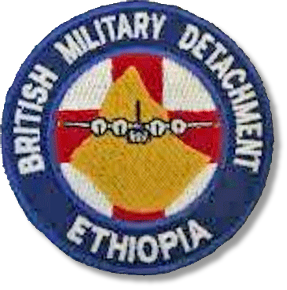
On October 23 1984, BBC journalist Michael Buerk reported of the "biblical famine" and the humanitarian crisis in Ethiopia. Pictures of emaciated, starving and dying men, women and children resulted in a number of countries, including Britain, carrying out a humanitarian aid mission. For Britain, this was called Operation Bushel and Chris Goss tells its story and the part he played in it.
In 1984 the authoritarian Ethiopian regime of Mengistu Haile Mariam was fighting a civil war against Tigrayan and Eritrean insurgents. People in these areas were starving because the government based in the capital Addis Ababa was deliberately bombing markets and trade convoys to disrupt food supply chains. With a starving population, it is amazing that defence spending accounted for half of Ethiopia’s Gross Domestic Product and the Soviet-backed army was the largest in sub-Saharan Africa.
After some political wrangling at governmental level, six C-130s and the first personnel arrived in country on November 3 1984 and 24 hours after arrival, the first relief flight was flown.
In 1984 the authoritarian Ethiopian regime of Mengistu Haile Mariam was fighting a civil war against Tigrayan and Eritrean insurgents. People in these areas were starving because the government based in the capital Addis Ababa was deliberately bombing markets and trade convoys to disrupt food supply chains. With a starving population, it is amazing that defence spending accounted for half of Ethiopia’s Gross Domestic Product and the Soviet-backed army was the largest in sub-Saharan Africa.
After some political wrangling at governmental level, six C-130s and the first personnel arrived in country on November 3 1984 and 24 hours after arrival, the first relief flight was flown.
Loading and unloading of Air Land aircraft operating out of Addis Ababa's Bole airport would be done by personnel from the United Kingdom Mobile Air Movements Sqn (UKMAMS) which was based at RAF Lyneham in Wiltshire together with the C-130 Hercules which would do most of the work. Air Drop operations would be handled by 47 Air Despatch Sqn (47 AD) Royal Corps of Transport which too was based at Lyneham but they did not start such operations until early 1985.
Due to the rush to get into Ethiopia, accommodation was hard to find so personnel lived in tents in the British Embassy compound whilst at Bole Airport, working accommodation was also tented. When the Author arrived on September 28 1985, the detachment was accommodated in a hotel (but even that was not ideal with beds having bed bugs which necessitated a nightly spraying with fly spray) but the working accommodation was exactly the same.
The daily routine was take off early morning for an hour's flight to Assab on the Red Sea coast, load up with grain which had been brought in by ships helped by local labourers, fly another hour to where the grain was needed such as Mekele (480 miles north of the capital), offload using local labourers, then fly back to Assab and repeat at least once before flying back to Bole usually with passengers.
Days were long with UKMAMS personnel initially working 18 hours a day, day on day off. Working at altitude (Addis Ababa has an elevation of 7,200 feet whilst Mekele was at 7,395 feet) and in the dry dusty heat was tiring to aircrew and ground crew alike. An added hazard was that sooner or later, nearly all personnel would come down with a debilitating stomach bug which necessitated sufferers never being too far from toilets. The risk of bird strikes was also high and the Author remembers just before returning to the UK that the Air Drop C-130 was hit by a vulture which penetrated the wing leading edge and its remains lodged there to be removed on returning to Bole, the remains taking five people to hold wing tip to wing tip.
Due to the rush to get into Ethiopia, accommodation was hard to find so personnel lived in tents in the British Embassy compound whilst at Bole Airport, working accommodation was also tented. When the Author arrived on September 28 1985, the detachment was accommodated in a hotel (but even that was not ideal with beds having bed bugs which necessitated a nightly spraying with fly spray) but the working accommodation was exactly the same.
The daily routine was take off early morning for an hour's flight to Assab on the Red Sea coast, load up with grain which had been brought in by ships helped by local labourers, fly another hour to where the grain was needed such as Mekele (480 miles north of the capital), offload using local labourers, then fly back to Assab and repeat at least once before flying back to Bole usually with passengers.
Days were long with UKMAMS personnel initially working 18 hours a day, day on day off. Working at altitude (Addis Ababa has an elevation of 7,200 feet whilst Mekele was at 7,395 feet) and in the dry dusty heat was tiring to aircrew and ground crew alike. An added hazard was that sooner or later, nearly all personnel would come down with a debilitating stomach bug which necessitated sufferers never being too far from toilets. The risk of bird strikes was also high and the Author remembers just before returning to the UK that the Air Drop C-130 was hit by a vulture which penetrated the wing leading edge and its remains lodged there to be removed on returning to Bole, the remains taking five people to hold wing tip to wing tip.
Those nations carrying out relief operations worked for the Ethiopian Relief and Rehabilitation Committee (RRC) and it was the RRC that tasked who went where and what the loads would be. Loading and unloading was done by local labour supervised (and helped) by the RAF team. It was sad to see that the locals always liked to receive sweets as a thank you, sweets apparently being like a delicacy to them. They all worked hard usually singing as they did it and could unload a full Hercules load of around 42,000 lbs made up of stacks of 110 lb bags of grain in 20 minutes, each bag containing enough grain to feed a family of five for a month.
It soon became clear that Air Drop missions to the more remote areas were needed so of the two aircraft now permanently based at Bole, one would be air land and one air drop. This allowed the UKMAMS detachment to reduce from 18 to 12. The Author flew on one such mission to air drop Sekota on October 2 1985-a sortie lasting just under two hours and the image of flying low-level, pushing off pallets of grain and the dust flying up and into the aircraft's freight compartment is still vivid after nearly 33 years
The international famine relief operation began to increase as more countries were involved with such aircraft as VC10s, TriStars, DC10s, Trans America and Belgian C-130s, Luftwaffe C-160s, Belfasts and Boeing 707s. In addition to grain such equipment as graders and road rollers, rice, high protein foodstuffs, tents and blankets were moved as well as a plethora of donated items such as clothing and biscuits.
As stated earlier, I arrived with my team on September 28 1985 having left Lyneham three days before only for the C-130 to go unserviceable in RAF Akrotiri. My first air land mission was to Assab, then Mekele and back to Bole on October 3. The following day, I flew to Asmara, then to Assab, Mekele, Assab, Melele and back to the capital. In all, I flew 31 times before returning to the UK via Akrotiri on October 24. Memories of the flights are vivid. Flying low-level over the edge of the East African Rift Valley, the heat and dust and hard manual work irrespective of rank. One memory that sticks in my memory is after a long days' work, dozing on the C-130 only to feel something on my head. I brushed it off, then off my face and on looking down at my chest saw that it was a Camel Spider. If you do not know what this is, search on line and you will understand why six RAF men then chased and caught said spider, much to the amusement of the Ethiopian passengers.
It soon became clear that Air Drop missions to the more remote areas were needed so of the two aircraft now permanently based at Bole, one would be air land and one air drop. This allowed the UKMAMS detachment to reduce from 18 to 12. The Author flew on one such mission to air drop Sekota on October 2 1985-a sortie lasting just under two hours and the image of flying low-level, pushing off pallets of grain and the dust flying up and into the aircraft's freight compartment is still vivid after nearly 33 years
The international famine relief operation began to increase as more countries were involved with such aircraft as VC10s, TriStars, DC10s, Trans America and Belgian C-130s, Luftwaffe C-160s, Belfasts and Boeing 707s. In addition to grain such equipment as graders and road rollers, rice, high protein foodstuffs, tents and blankets were moved as well as a plethora of donated items such as clothing and biscuits.
As stated earlier, I arrived with my team on September 28 1985 having left Lyneham three days before only for the C-130 to go unserviceable in RAF Akrotiri. My first air land mission was to Assab, then Mekele and back to Bole on October 3. The following day, I flew to Asmara, then to Assab, Mekele, Assab, Melele and back to the capital. In all, I flew 31 times before returning to the UK via Akrotiri on October 24. Memories of the flights are vivid. Flying low-level over the edge of the East African Rift Valley, the heat and dust and hard manual work irrespective of rank. One memory that sticks in my memory is after a long days' work, dozing on the C-130 only to feel something on my head. I brushed it off, then off my face and on looking down at my chest saw that it was a Camel Spider. If you do not know what this is, search on line and you will understand why six RAF men then chased and caught said spider, much to the amusement of the Ethiopian passengers.
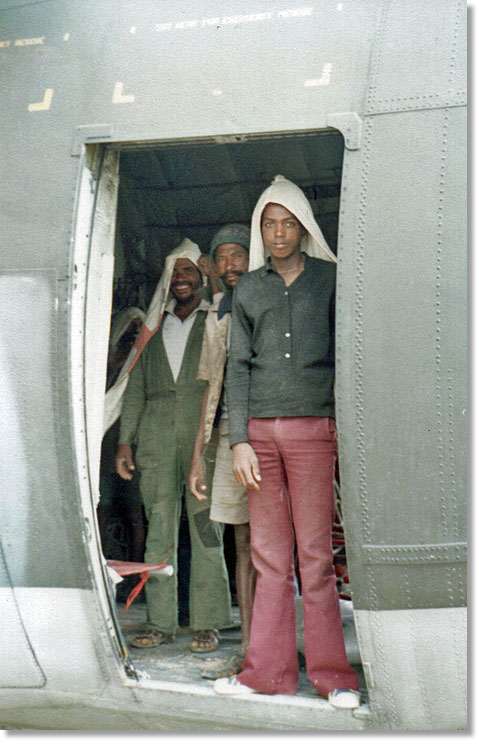
Another memory was I was fortunate to fly from the Polish helicopter base at Leditia on the outskirts of Addis Ababa (and don't forget this was when Poland was still Communist) in a MI-8 Hip helicopter to Lemi to be on the ground to help call in an air drop sortie. Being on the ground with those who needed the grain and seeing the C-130 dropping its load pass after pass is still vivid and was quite humbling..
The end of Operation Bushell came in December 1985 and the final loads were dedicated to the movement of a prefabricated hospital clinic donated by the Italian Government. The total weight was 165 tonnes and it took 17 sorties to move it, using both airframes. The move was completed on December 16 1985 all that was now needed was to recover the detachment and its equipment back to the UK. By using resupply aircraft and full use of carrying capacity, all was returned to UK with no extra additional airlift being needed.
By the end of the Operation, the RAF had flown 2,152 sorties and between November 3 1984 and December 19 1985, had moved 38,676,301 lbs. (17,580 tonnes) of freight and flown 983 passengers. The final word goes to the Fg Off who not only set up the UKMAMS detachment but in addition to a second detachment, was then responsible for not only moving the Italian hospital but recovering the detachment:
"We just managed to get the Italian hospital moved when we had to recover everything back to Lyneham. They were fantastic times, very hard work doing a massive amount of good but also a lot of fun at the more formal events but Sunday nights at the Buffet de la Gare and on the back of a Hercules with the ramp down low level across the Ethiopian Plain. There are so many memories and I feel very privileged to have worked in Ethiopia doing what we did and very proud of the achievement and the difference we made."
The end of Operation Bushell came in December 1985 and the final loads were dedicated to the movement of a prefabricated hospital clinic donated by the Italian Government. The total weight was 165 tonnes and it took 17 sorties to move it, using both airframes. The move was completed on December 16 1985 all that was now needed was to recover the detachment and its equipment back to the UK. By using resupply aircraft and full use of carrying capacity, all was returned to UK with no extra additional airlift being needed.
By the end of the Operation, the RAF had flown 2,152 sorties and between November 3 1984 and December 19 1985, had moved 38,676,301 lbs. (17,580 tonnes) of freight and flown 983 passengers. The final word goes to the Fg Off who not only set up the UKMAMS detachment but in addition to a second detachment, was then responsible for not only moving the Italian hospital but recovering the detachment:
"We just managed to get the Italian hospital moved when we had to recover everything back to Lyneham. They were fantastic times, very hard work doing a massive amount of good but also a lot of fun at the more formal events but Sunday nights at the Buffet de la Gare and on the back of a Hercules with the ramp down low level across the Ethiopian Plain. There are so many memories and I feel very privileged to have worked in Ethiopia doing what we did and very proud of the achievement and the difference we made."
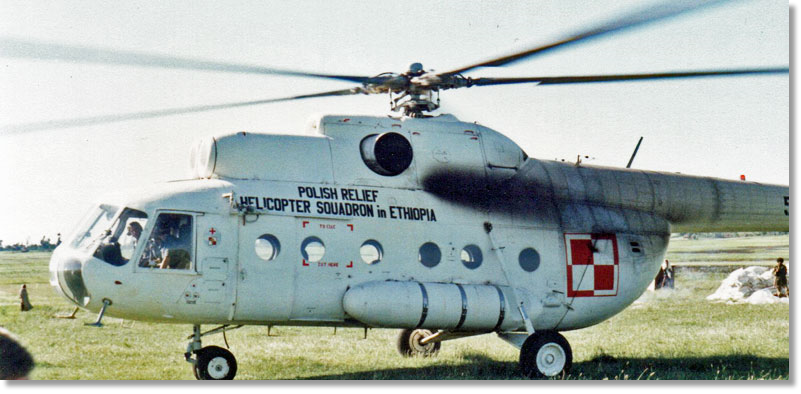
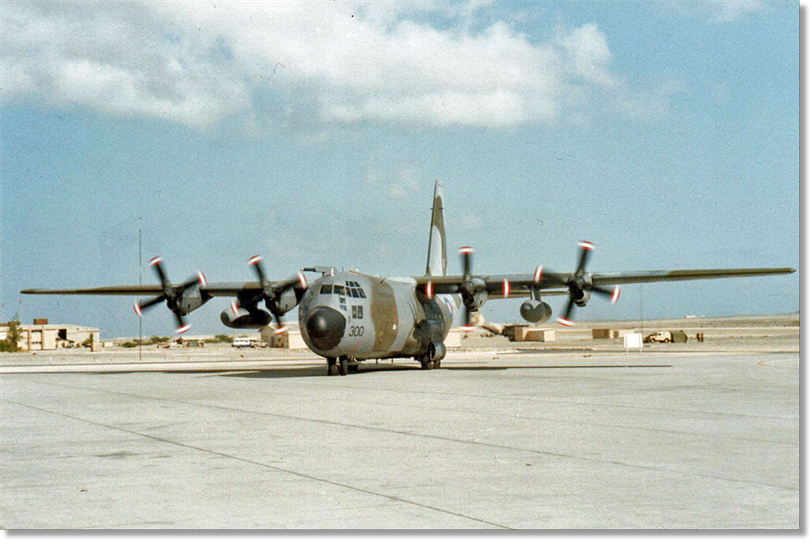
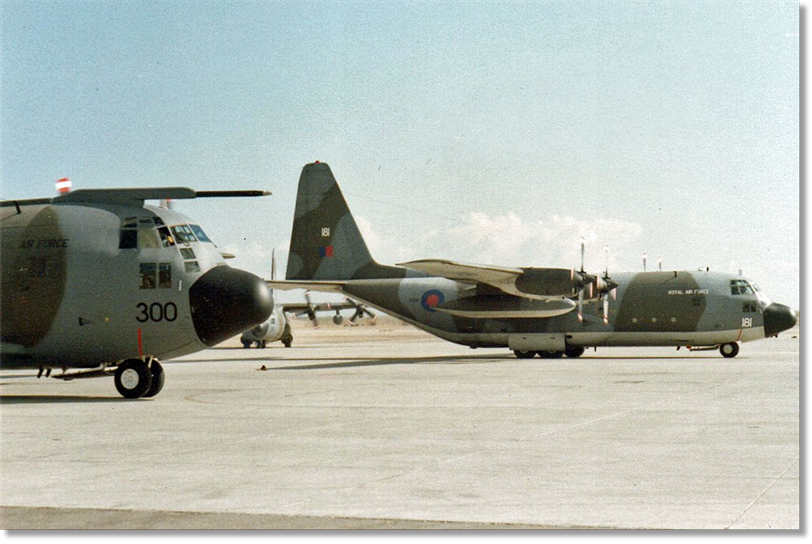
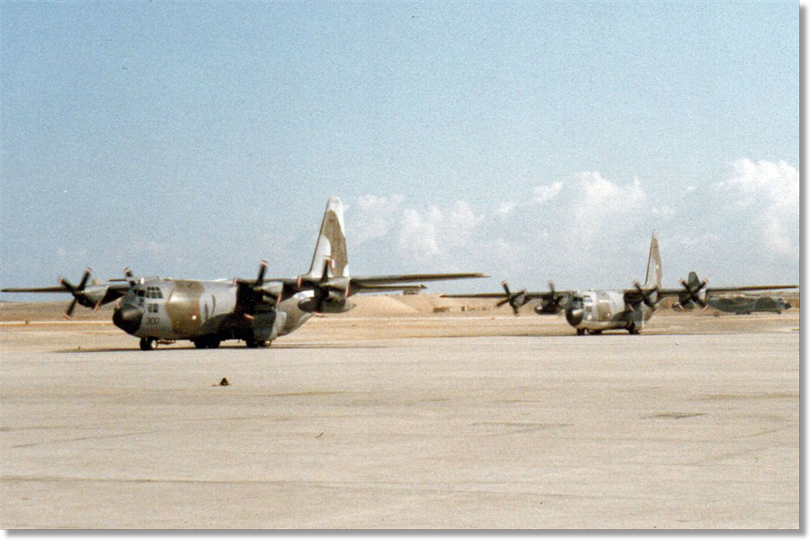
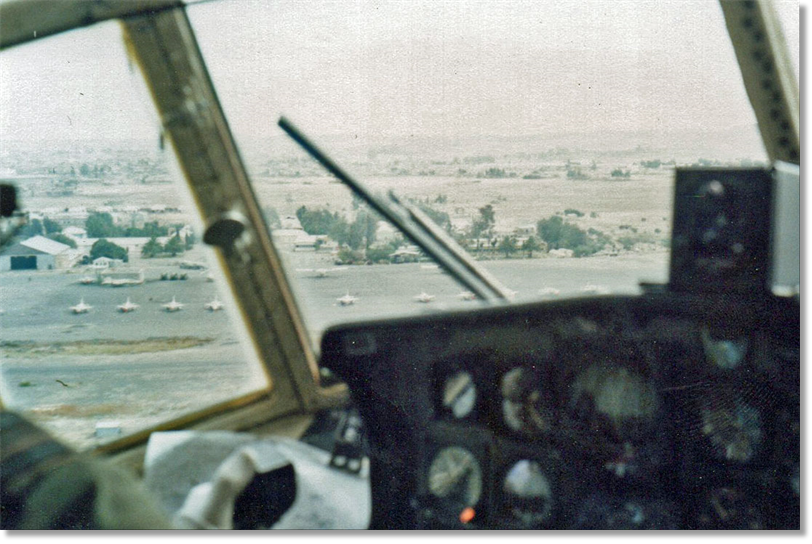
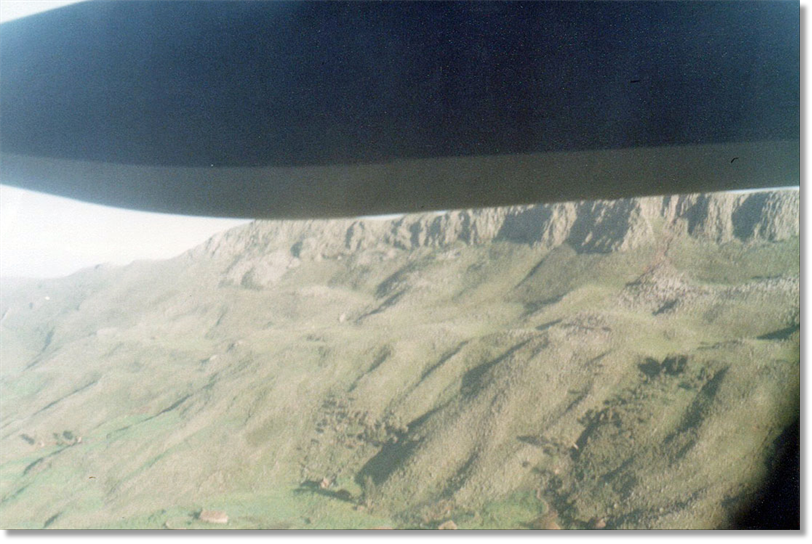
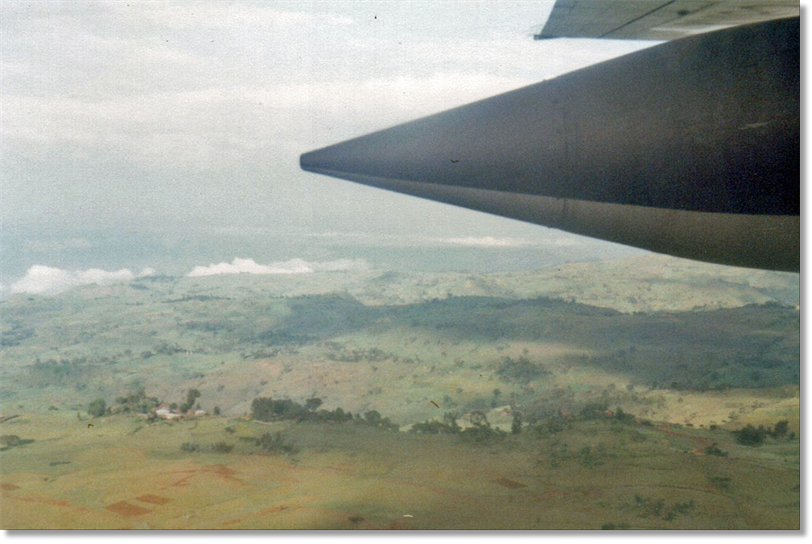
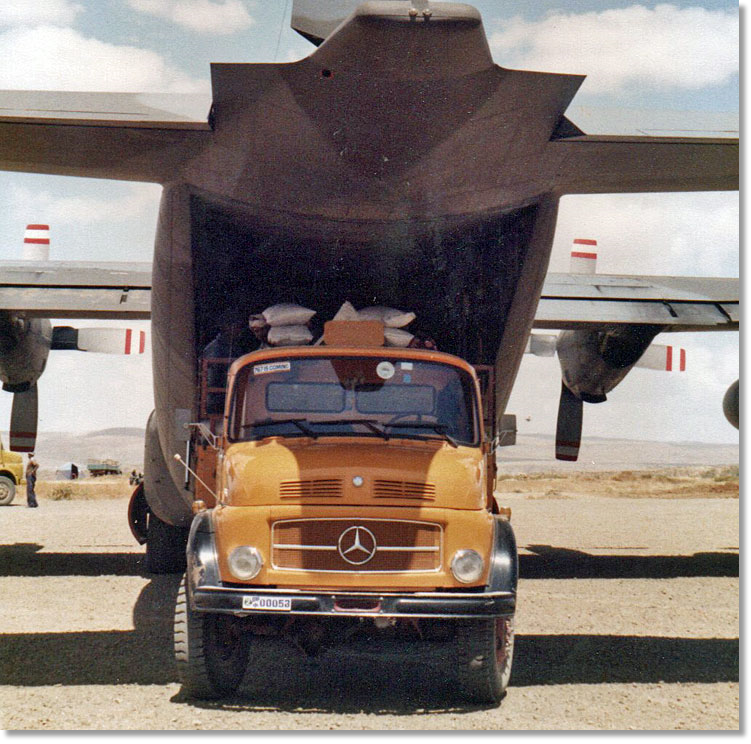
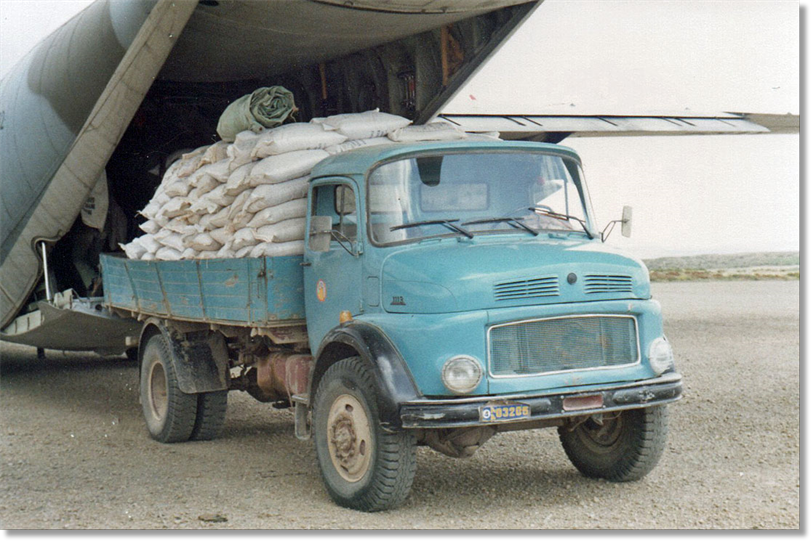
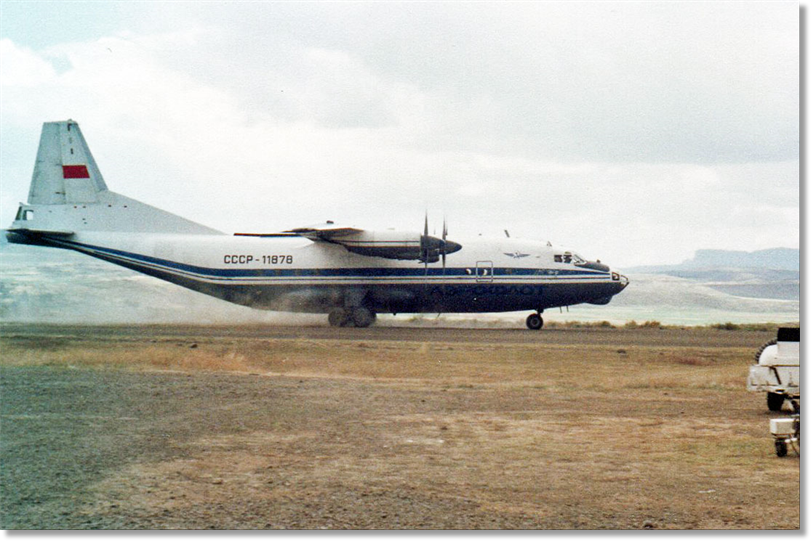
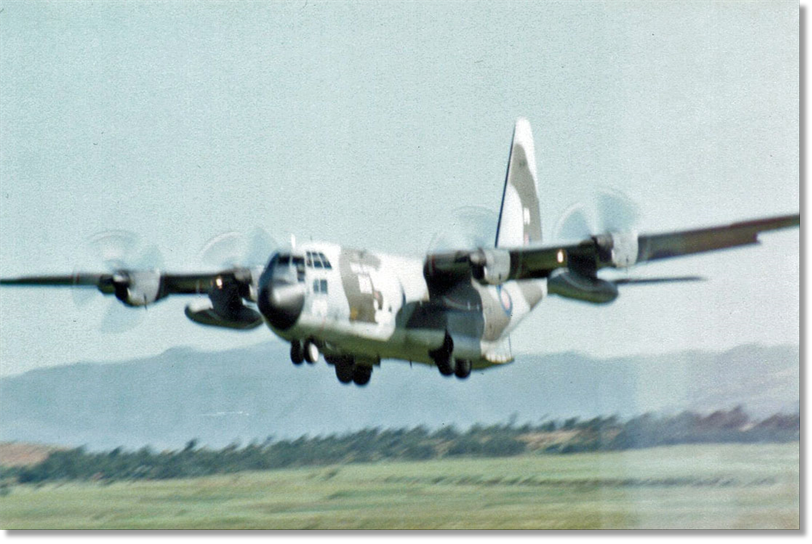
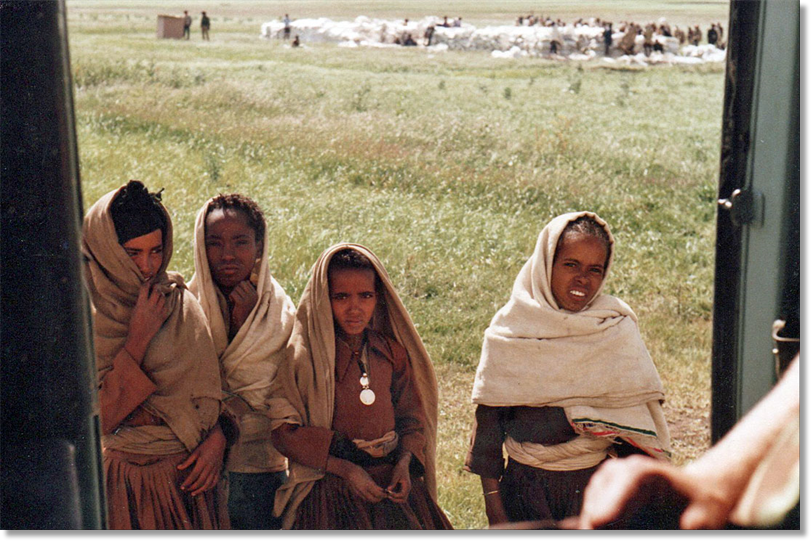
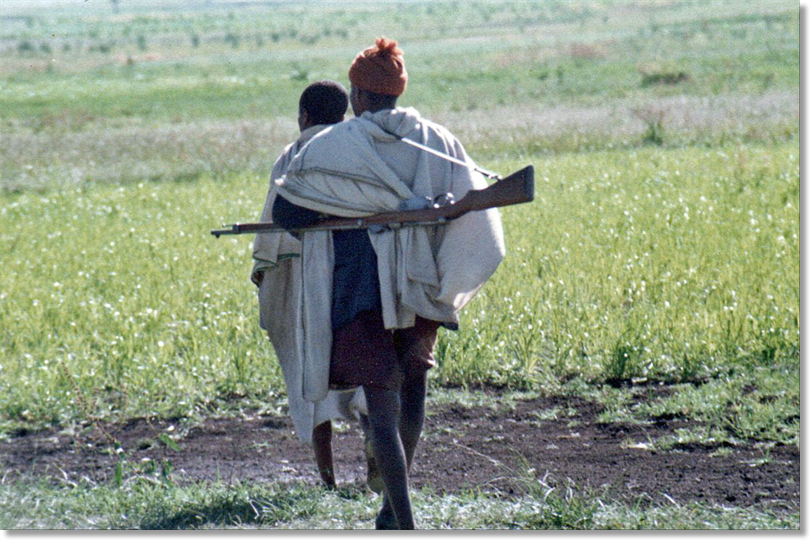

From: Sam Mold, Brighton and Hove
Subject: Memories of Africa
Hi Tony, I have two brief memories of Africa summed up in a nutshell:
Flying from Aden to Kenya in a Douglas DC3 Dakota of Aden Airways, to spend two weeks respite at an RAF Leave Centre, called 'Silver Sands', based at Nyali Beach, not far from Mombasa.
Spending a seven-week detachment to Libya on an Air Movements exercise: Operation 'Triplex West', held close by to Tobruk, to establish that the RAF could support an Army unit serving in the desert.
Sam Mold
Subject: Memories of Africa
Hi Tony, I have two brief memories of Africa summed up in a nutshell:
Flying from Aden to Kenya in a Douglas DC3 Dakota of Aden Airways, to spend two weeks respite at an RAF Leave Centre, called 'Silver Sands', based at Nyali Beach, not far from Mombasa.
Spending a seven-week detachment to Libya on an Air Movements exercise: Operation 'Triplex West', held close by to Tobruk, to establish that the RAF could support an Army unit serving in the desert.
Sam Mold
From: Keri Eynon, Thatcham Berks
Subject: Memories of Africa
Hi Tony,
As promised, here are some memories of Africa. Obviously the most long lasting in my case was of the famine relief in Ethiopia in 1985. I have attached a few general shots of some of the places we flew in to to deliver aid. However I am sure many people have siimilar memories of that time and much will have been written about it.
One other place we visited on a more regular basis was Kenya and fond memories of drinks at the "Thorn Tree" in Nairobi. However there were two other visits to Africa that I will never forget: Firstly in 1971 we delivered a Marine Engine to Cape Town. As Aparthied was still in place it took some time to get used to the segregated areas within the city, in particular the public amenities.
However, the one lasting highlight of the trip was the cable car ride up Table Mountain. The black and white photo - taken by Fred Kitts is of the rest of the team on our way up to catch the cable car. The view from the top was breathtaking but unfortunately by the time we came to come back down and to hopefully get some more shots the "Table Cloth" had come down still it was something I will never forget. I have scanned the certificate I got to commemorate the fact of reaching the top of Table Mountain.
My other unforgettable experience in Africa was a trip to Egypt, delivering a helicopter for the Egyptian Air Force to try out. During our time in Cairo we were lucky enough to experience a "Son-Et Lumiere" staged in front of the Pyramids and Sphinx. We were fortunate as this was done in English (they rotate it through various languages). The other memory was of going inside the Pyramid, right into the heart of it, and marvelling at how they managed to have fresh air circulating in the structure all those years ago again something I will never forget.
Regards,
Keri
Subject: Memories of Africa
Hi Tony,
As promised, here are some memories of Africa. Obviously the most long lasting in my case was of the famine relief in Ethiopia in 1985. I have attached a few general shots of some of the places we flew in to to deliver aid. However I am sure many people have siimilar memories of that time and much will have been written about it.
One other place we visited on a more regular basis was Kenya and fond memories of drinks at the "Thorn Tree" in Nairobi. However there were two other visits to Africa that I will never forget: Firstly in 1971 we delivered a Marine Engine to Cape Town. As Aparthied was still in place it took some time to get used to the segregated areas within the city, in particular the public amenities.
However, the one lasting highlight of the trip was the cable car ride up Table Mountain. The black and white photo - taken by Fred Kitts is of the rest of the team on our way up to catch the cable car. The view from the top was breathtaking but unfortunately by the time we came to come back down and to hopefully get some more shots the "Table Cloth" had come down still it was something I will never forget. I have scanned the certificate I got to commemorate the fact of reaching the top of Table Mountain.
My other unforgettable experience in Africa was a trip to Egypt, delivering a helicopter for the Egyptian Air Force to try out. During our time in Cairo we were lucky enough to experience a "Son-Et Lumiere" staged in front of the Pyramids and Sphinx. We were fortunate as this was done in English (they rotate it through various languages). The other memory was of going inside the Pyramid, right into the heart of it, and marvelling at how they managed to have fresh air circulating in the structure all those years ago again something I will never forget.
Regards,
Keri
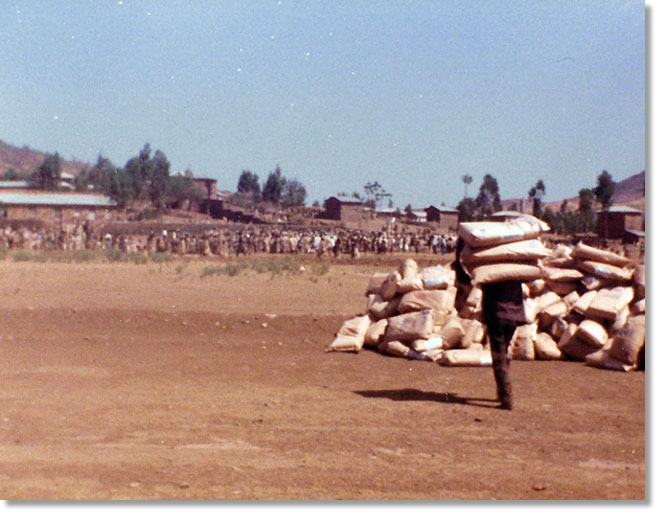
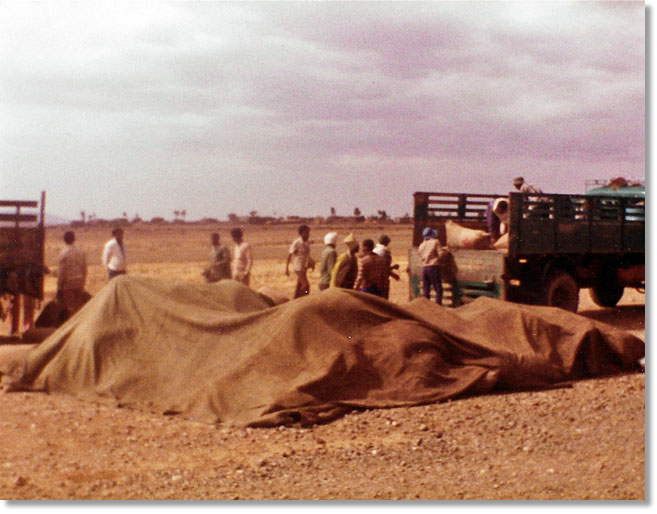
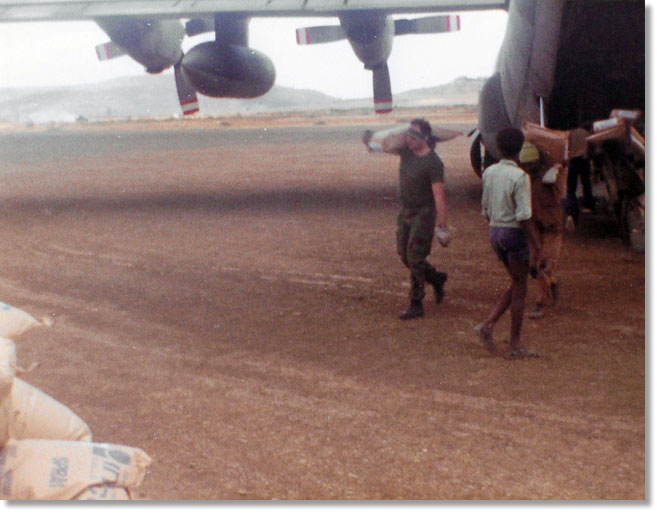
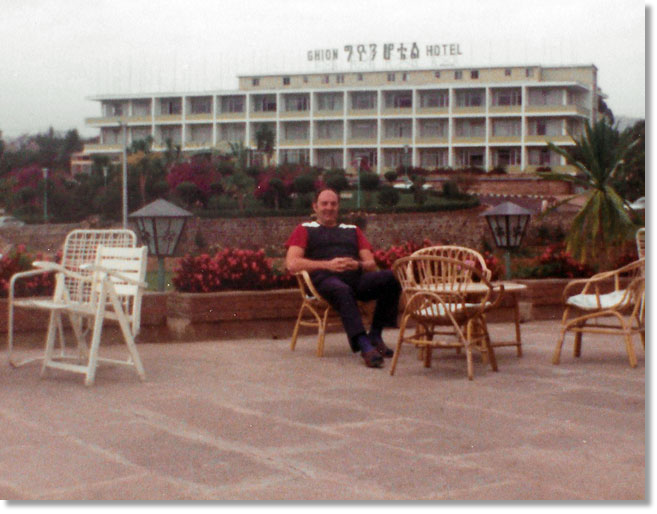
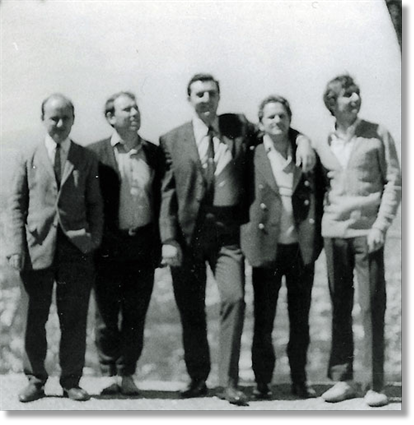
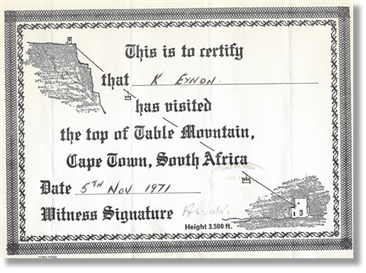
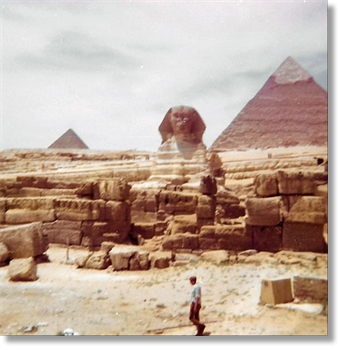
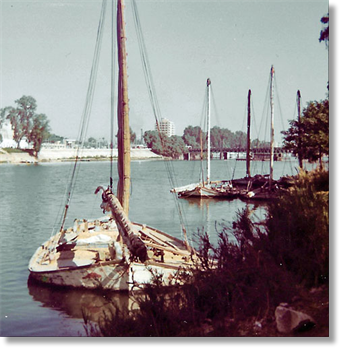
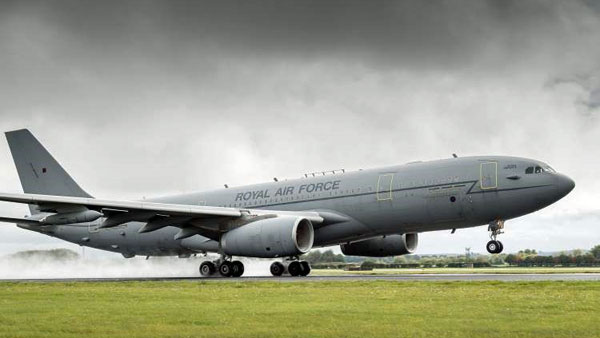
Boris Johnson has said he would like to have a 'Brexit jet', after complaining the Prime Minister's RAF plane 'never seems to be available'.
The Foreign Secretary revealed its multiple users mean it is difficult for senior ministers to book when they need it, saying: "What I will say about the Voyager, I think it's great, but it seems to be very difficult to get hold of...
"It never seems to be available. I don't know who uses it, but it never seems to be available." And he added: "Also, why does it have to be grey?"
Mr Johnson, who is on a five-day tour of Latin America, acknowledged that taxpayers would balk at the cost of buying a jet for ministers, but said he thought the spending would be justified if it was not "exorbitant".
The Foreign Secretary revealed its multiple users mean it is difficult for senior ministers to book when they need it, saying: "What I will say about the Voyager, I think it's great, but it seems to be very difficult to get hold of...
"It never seems to be available. I don't know who uses it, but it never seems to be available." And he added: "Also, why does it have to be grey?"
Mr Johnson, who is on a five-day tour of Latin America, acknowledged that taxpayers would balk at the cost of buying a jet for ministers, but said he thought the spending would be justified if it was not "exorbitant".
The Foreign Office currently has use of the Queen's Flight fleet of BAE 146 jets, one of which Mr Johnson used to fly to Moscow before Christmas and he described the 26-seater planes as "superb... masterpieces of engineering", but said they were coming up to 40 years old.
Tony Blair's plans for a prime ministerial jet - branded "Blair Force One" for its similarity to the US President's private airliner - were dumped by Gordon Brown as a cost saving measure. The Voyager began its work transporting VIPs in 2016, after a £10 million refit under David Cameron, but he took only one flight on it before handing over to Theresa May, whose travels have earned it the nickname of the "ThereasyJet".
In order to keep costs down, it was announced the 58-seater plane would continue conducting air-to-air refuelling missions for the RAF when not in VIP use, and retained its military livery. Mr Johnson has also been a prominent supporter of the campaign for a replacement for the Royal Yacht Britannia.
Forces.net/news
Tony Blair's plans for a prime ministerial jet - branded "Blair Force One" for its similarity to the US President's private airliner - were dumped by Gordon Brown as a cost saving measure. The Voyager began its work transporting VIPs in 2016, after a £10 million refit under David Cameron, but he took only one flight on it before handing over to Theresa May, whose travels have earned it the nickname of the "ThereasyJet".
In order to keep costs down, it was announced the 58-seater plane would continue conducting air-to-air refuelling missions for the RAF when not in VIP use, and retained its military livery. Mr Johnson has also been a prominent supporter of the campaign for a replacement for the Royal Yacht Britannia.
Forces.net/news
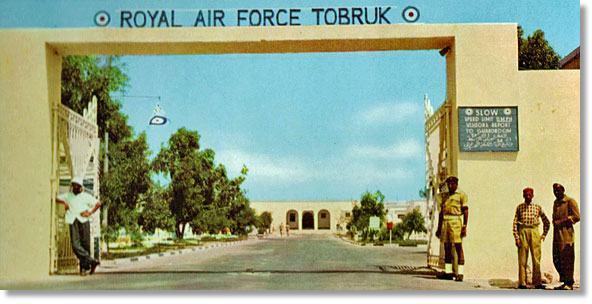

A new member who joined us recently is:
Bruce Gill, Newton Abbott, Devon
Welcome to the OBA!


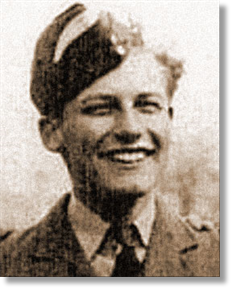
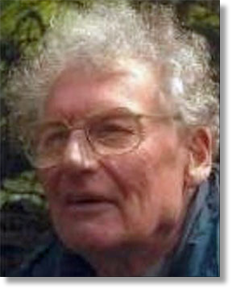
MY TIME IN THE R.A.F., 1943-1947
An Air Mover's Story in Eight Parts
Norman Victor Quinnell, 1925-2008
An Air Mover's Story in Eight Parts
Norman Victor Quinnell, 1925-2008
Part Seven - RAF Changi, Singapore (c) - Jan 1946 - Apr 1947
RAF Changi was a well disciplined station; the only parades were those for pay, and the relationship between Officers and Other Ranks was friendly and easy going but respectful. There were never any inspections of rooms or of kit, such as happened in other places once or twice a year, and was probably instituted to check that clothing was in good order. There was a six monthly dental inspection, undertaken by a young but very efficient RAF dentist. He did only one filling in the side of a molar, but years later a dentist marvelled at its minute size. We wondered how he got on with his fellow Officers since off duty he was a little eccentric, and on two occasions he turned up at our Mess, a normally unheard of action, and left after two hours thoroughly inebriated.
May 28th 1946 was my 21st birthday, and hearing this our shift Officers, F/Lt. Lloyd and F/O. Elphick arranged a special meal at a restaurant in town, to include a half dozen staff from Passenger and Freight Sections, and Ruby our usual WVS person. They were given a time to turn up at the restaurant, while beforehand Lloyd and Elphick took me to the holy of holies, Raffles Hotel, for a couple of drinks.
Entry was forbidden to Other Ranks, unless signed in and accompanied by an Officer, and even then only they could purchase drinks etc. Thinking back, the impression was of a very smart early 1930’s decor, rather as I had expected, so I can’t recall any details. (When I returned in 1990 it was closed, and the interior was to be rebuilt). Having had a whiskey or two we repaired to the restaurant for a super meal and drinks, the only item I was allowed to buy, and two hours or so later we all took the next gharry back to Changi. Of course birthday cards, and probably small presents, had arrived from home, but the meal in town and entry to “Raffles” really rounded off the occasion.
May 28th 1946 was my 21st birthday, and hearing this our shift Officers, F/Lt. Lloyd and F/O. Elphick arranged a special meal at a restaurant in town, to include a half dozen staff from Passenger and Freight Sections, and Ruby our usual WVS person. They were given a time to turn up at the restaurant, while beforehand Lloyd and Elphick took me to the holy of holies, Raffles Hotel, for a couple of drinks.
Entry was forbidden to Other Ranks, unless signed in and accompanied by an Officer, and even then only they could purchase drinks etc. Thinking back, the impression was of a very smart early 1930’s decor, rather as I had expected, so I can’t recall any details. (When I returned in 1990 it was closed, and the interior was to be rebuilt). Having had a whiskey or two we repaired to the restaurant for a super meal and drinks, the only item I was allowed to buy, and two hours or so later we all took the next gharry back to Changi. Of course birthday cards, and probably small presents, had arrived from home, but the meal in town and entry to “Raffles” really rounded off the occasion.
Three days later reality returned with the announcement that I would be part of the parade which would celebrate the King’s Birthday on June 6th. The salute would be taken by the Supreme Commander, S.E. Asia, Lord Mountbatten, at the front of the Supreme Court or City Hall, along St. Andrew’s Road, beside Padang Park. Contingents and bands from all the Services would create a procession to take an hour or more to pass the stand.
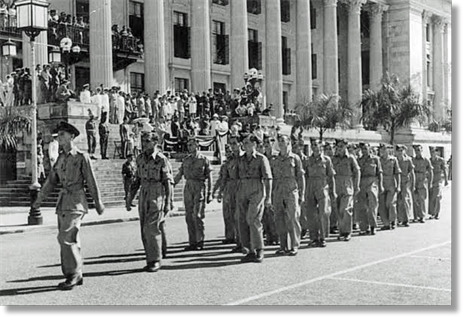
Changi was to contribute a couple of sections, each of about 30 men, who would be headed by one Officer and one NCO, which was where I came in. Since nobody had marched for months there had to be some practice, which was undertaken the day before. Someone was detailed to take over my normal duties for the two days. I knew the Officer who would head our squad and we were soon reasonably presentable, and learned how and where we slotted into the parade.
On the morning of the 6th. transport took us to a road and park about 300 yards east of the parade road, and there we formed up in our allotted position with hundreds of others and awaited the signal. Once started it was less than a half mile to the saluting base, and in our freshly pressed uniforms I think we were a very creditable bunch. Crowds lined the route, but you sensed them rather than saw them, concentrating on the group in front that we would maintain a constant distance, and trusting that all behind were in step. Days later, in town, I purchased a photo taken by a Chinese photographer, and it shows us all in step!
On the morning of the 6th. transport took us to a road and park about 300 yards east of the parade road, and there we formed up in our allotted position with hundreds of others and awaited the signal. Once started it was less than a half mile to the saluting base, and in our freshly pressed uniforms I think we were a very creditable bunch. Crowds lined the route, but you sensed them rather than saw them, concentrating on the group in front that we would maintain a constant distance, and trusting that all behind were in step. Days later, in town, I purchased a photo taken by a Chinese photographer, and it shows us all in step!
It may have been through the Parade that I was asked if I would care to be involved in a more solemn matter, and respectfully avoided it, though I’ve always had a conscience about it. In the room above me four fellows lived in a rather contrived luxury. I didn’t know them well, but passed the time of day when going to the showers. Their room was extraordinary; the walls were covered with personal photos, pin-ups, and other pictures from magazines. Each bed had its bedside light, one or two had a radio, and there were other electrical appliances strewn about. Wires went round the edges of the room from one or at most two sockets. The only mechanical thing was a wind-up gramaphone with a collection of popular classics, including Handel’s organ music, and, of course the current dance tunes. Unusually, one of these was of local origin, sung in English by a Chinese girl, and called either “Rose of Malaya” or “Rose, Rose, I Love You”. Its popularity extended to the UK, where returned troops demanded it so often on record request programmes that the BBC eventually blacklisted it. Although I could hear the room above playing music it was never loud enough to be a nuisance.
One evening I returned from duty to hear that one of the occupants had been electrocuted, and in spite of attempts at resuscitation, when taken to the camp hospital was pronounced dead. It seems he had returned to his bedside from a shower and, standing on the concrete floor, had fiddled with some equipment and then collapsed. I recall him as a quiet person, Peter someone, who had been a trainee sound engineer at Pinewood Film Studios before joining the RAF and becoming a navigator. After the inquest established “accidental death” a funeral took place at the military cemetery at Kranji, and I was asked to be one of the bearers. I had never even attended a funeral, and to suddenly find myself a prominent part of one really scared me into thinking I might do something incorrect and consequently I turned down the request.
One evening I returned from duty to hear that one of the occupants had been electrocuted, and in spite of attempts at resuscitation, when taken to the camp hospital was pronounced dead. It seems he had returned to his bedside from a shower and, standing on the concrete floor, had fiddled with some equipment and then collapsed. I recall him as a quiet person, Peter someone, who had been a trainee sound engineer at Pinewood Film Studios before joining the RAF and becoming a navigator. After the inquest established “accidental death” a funeral took place at the military cemetery at Kranji, and I was asked to be one of the bearers. I had never even attended a funeral, and to suddenly find myself a prominent part of one really scared me into thinking I might do something incorrect and consequently I turned down the request.
There was a fair amount of free time but none of us explored Singapore to a great degree, though rumours of robbery if one went from the well trodden routes were never substantiated. It was probably relatively free from violent crime, but because it was foreign it was widely held that it must be dangerous, a view that was sustained by officialdom to avoid any problems of troops versus locals. And the wholesale demolition of most of the old city apart from the former Government buildings and a handful of historical ones and some mosques and temples, means that it is now impossible to relate memories to the modern maps.
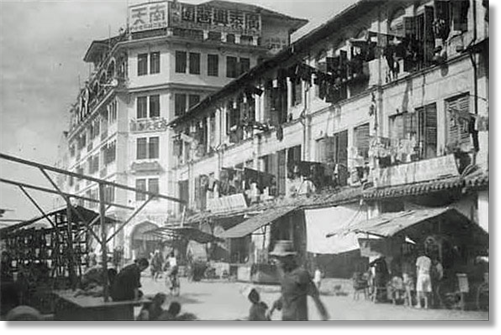
However industrious, the great majority of the population lived in poverty, extended families crammed into the rooms of two or sometimes three story blocks, properties that may have been owned but more likely rented. Oil lamps and cooking stoves were normal in some areas while others had electricity, but all must have had mains water and sewerage. Often the ground floor front room was a shop/workshop with shutters to close the frontage at night. Saleable goods such as baskets were piled high on the pavements, and the owners of these enterprises were probably relatively prosperous.
There were miles of streets with these blocks, built of stone and limewashed. They had been constructed, I guess, from the mid 19th century, when the massive increase in trade necessitated a corresponding amount of labour, largely supplied from China. Almost all have now been demolished, the streets altered, and people live in municipal tower blocks and, where possible, businesses have been transferred to modern shops. After protests a pair of short streets in the Chinatown area were kept, but completely renovated, retaining the old type open ground floor shops but are primarily tourist attractions.
There were miles of streets with these blocks, built of stone and limewashed. They had been constructed, I guess, from the mid 19th century, when the massive increase in trade necessitated a corresponding amount of labour, largely supplied from China. Almost all have now been demolished, the streets altered, and people live in municipal tower blocks and, where possible, businesses have been transferred to modern shops. After protests a pair of short streets in the Chinatown area were kept, but completely renovated, retaining the old type open ground floor shops but are primarily tourist attractions.
There were two other items that, fortunately, no longer exist in their original form. Firstly, the “Death Houses”, which fronted roads alongside the dwelling house blocks, and at a glance looked somewhat similar, each death house served a particular area. For a family living in very cramped conditions it might be possible to deal with temporary sickness but not for a person whose prolonged and extreme illness would lead to death. Infectious diseases necessitated hospitalisation but in other cases a person would be taken to the death house where there was a degree of attendance, though relatives were expected to do most of the caring and to supply food. There was a charge of sorts, and maybe the patient had to bring his or her own bed.
There was segregation into male and female “wards”, probably on the ground and first floors, and beds had some form of screening, but whether the day and night attendants lived on the premises or came in daily I don’t know, and equally have no idea how they dealt with the dead. It may be that the coffin was taken to the death house and then to the deceased home before the funeral. At the time one preferred not to know about such things. It is interesting that death houses still survive in Singapore’s modern Chinatown, but with personal cubicles in what are more like hospitals than the crude conditions of the past.
Secondly the Singapore River, which ran through the southern part of the city, was crammed with houseboats in its upper mile or more. Families walked across other boats to get to the riverside, and all sewage and rubbish was thrown into the river. They were not allowed into the lower reaches towards the bay, but needed far more control. Now only a few licenced boats remain.
There was segregation into male and female “wards”, probably on the ground and first floors, and beds had some form of screening, but whether the day and night attendants lived on the premises or came in daily I don’t know, and equally have no idea how they dealt with the dead. It may be that the coffin was taken to the death house and then to the deceased home before the funeral. At the time one preferred not to know about such things. It is interesting that death houses still survive in Singapore’s modern Chinatown, but with personal cubicles in what are more like hospitals than the crude conditions of the past.
Secondly the Singapore River, which ran through the southern part of the city, was crammed with houseboats in its upper mile or more. Families walked across other boats to get to the riverside, and all sewage and rubbish was thrown into the river. They were not allowed into the lower reaches towards the bay, but needed far more control. Now only a few licenced boats remain.
Fishing was an industry manifested around different parts of the island but larger vessels landed catches at a dock somewhere near Collyer Quay, I think. Most prominent were the vast piles of sharks fins heaped on the quayside, and their overpowering smell. Fishing boats tied up in one area while merchant vessels, troopships etc. were elsewhere, and it all seemed to mesh in without problems.
Entertainment in town was fairly limited. At weekends Singapore Cricket Club played matches on the Padang, (where they still have their large clubhouse) and there was no charge for watching. It was possible to play football, rugby, and no doubt tennis if you knew the right people. There were a couple of cinemas, several parks, and of course numerous cafes and drinking places. I don’t recall any libraries or swimming baths, but they may have been restricted to the local population.
I heard there were some weird “public” gardens and a deserted house called Haw Par Villa three miles East of the town centre, so one afternoon I set out to find them. They had been constructed in the 30’s by the Aw Boon brothers as a surreal and grotesque exhibition of Chinese mythology.
Entertainment in town was fairly limited. At weekends Singapore Cricket Club played matches on the Padang, (where they still have their large clubhouse) and there was no charge for watching. It was possible to play football, rugby, and no doubt tennis if you knew the right people. There were a couple of cinemas, several parks, and of course numerous cafes and drinking places. I don’t recall any libraries or swimming baths, but they may have been restricted to the local population.
I heard there were some weird “public” gardens and a deserted house called Haw Par Villa three miles East of the town centre, so one afternoon I set out to find them. They had been constructed in the 30’s by the Aw Boon brothers as a surreal and grotesque exhibition of Chinese mythology.
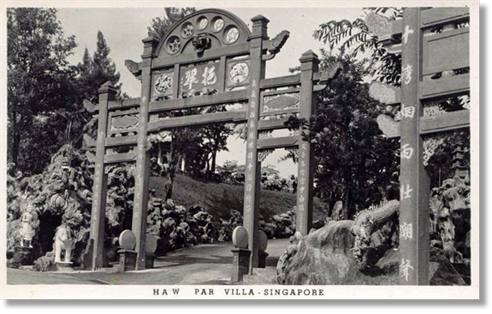
Information on the brothers was sparse; they had made a vast fortune from the manufacture of “Tiger Balm”, an ointment alleged to cure anything, from coughs to wounds to head-aches, and is still marketed. They had now “gone away”, and I suspected it was due to collaboration with the Japanese. (There is a very similar thing in Hong Kong, where an enclosed area of a few acres are devoted to the more unpleasant items of Chinese history, interspersed with pagodas, waterfalls etc., and this is also linked to “Tiger Balm” ).
Here I found an exceptionally tall archway above an open entrance drive to a remarkable, almost futuristic, house. It was like a bungalow, raised on a plinth as if it had cellars, and most rooms had domed ceilings each of which required a cupola in the roof. Many of the doors in the house had gone but most rooms contained fine ceiling decorations of flowers and leaves which looked as if they were painted porcelain, quite beautiful and arresting in an odd way.
Here I found an exceptionally tall archway above an open entrance drive to a remarkable, almost futuristic, house. It was like a bungalow, raised on a plinth as if it had cellars, and most rooms had domed ceilings each of which required a cupola in the roof. Many of the doors in the house had gone but most rooms contained fine ceiling decorations of flowers and leaves which looked as if they were painted porcelain, quite beautiful and arresting in an odd way.
The house, with an empty swimming pool beside it, was set on a knoll. Beyond were acres of well kept extraordinary gardens. An archway was over a wide paved way which curved downhill with views across the sea. Elsewhere there were narrow paths leading to tallish pagodas, small pagodas set in stone lined pits, pottery images and stone carvings of demons and historical figures, alongside paths and among trees. Three or four youngsters were leaving when I arrived at the main entrance but nobody else was in the place, and although the interior of the house was a mess the grounds were obviously being brought into some order.
I suspected that I was trespassing, as well as being on my own in a “foreign” part of town, so having taken a few photographs it seemed wise to retreat from a most remarkable place and experience. I would have liked to make a return visit in the company of someone but relating my views of the fascinating place at Changi evoked no interest whatever, save surmises on my fate had I been arrested (I believe Haw Paw Gardens are now a visitor attraction).
Further exploration led me to a Muslim graveyard in the countryside not far from Changi, but generally I went into town and stayed near the centre visiting Buddhist and Indian temples. I don’t recall seeing any museum so perhaps it had not then reopened.
I suspected that I was trespassing, as well as being on my own in a “foreign” part of town, so having taken a few photographs it seemed wise to retreat from a most remarkable place and experience. I would have liked to make a return visit in the company of someone but relating my views of the fascinating place at Changi evoked no interest whatever, save surmises on my fate had I been arrested (I believe Haw Paw Gardens are now a visitor attraction).
Further exploration led me to a Muslim graveyard in the countryside not far from Changi, but generally I went into town and stayed near the centre visiting Buddhist and Indian temples. I don’t recall seeing any museum so perhaps it had not then reopened.
At night the biggest form of entertainment were the two enormous dance halls, the “Great World” and the “Happy World”, situated near the centre of town and quite close together. The larger “Great World”, was in or beside Fort Canning Park, but both could accommodate hundreds of dancers. The system employed went by the name of “Taxi Dances” whereby to enter one bought a single ticket or a strip of them, all for a few cents each. Then, for a dance, you presented a ticket to the girl chosen from the two or three hundred standing or sitting round the wide edge of the dance floor. Virtually all the girls were Chinese, and they collected their tickets throughout the evening and, on leaving, presumably handed them in to the hall owners for cash, less a percentage. They earned some money in a respectable fashion, though obviously the less attractive ones fared poorly, save on very busy nights. It would be most unlikely that any used the venue as an adjunct to prostitution. That was confined to the unadvertised but well known multicultural brothels that, it was said, were always run by Chinese madams.
Music was provided by small local bands, always proficient, and capable of varieties of dance music. It worked well, and although snacks and soft drinks were available there was rarely any trouble with the numbers of Army, Navy, and Air Force for whom the two.”Worlds” were magnets. Indeed, when Maurice Smith was in Singapore for a night we would go to one of them, although our awful dancing must have been a torment for the girls.
Cinemas were obviously well attended. There was one in the Cathay Building complex, I think, and another, perhaps a “Regal”, on the Changi Road at the edge of a built-up area about two or three miles from the camp. An Edinburgh Scot, “Jock” Taylor, and I used to go there at least once a month. We had a few things in common though he was in the Freight Section and we never worked together. He, like me, had managed to get a single room; we had both married early, but he was already having problems with his wife going out with someone and occasionally wished to talk about the situation. He was a sensible hard-headed individual with no time for fripperies.
One night we went to a late performance of a Disney film “The Three Cabilleros” which, because of its late finish, was only lightly attended and it was too late for any transport back to camp. Not worried about the moonless darkness, since there was no traffic, we started walking back along the well-built tarmac road with its 5ft deep concrete monsoon ditches to each side. Main roads had no barriers at the sides; if you drove off the tarmac you fell into a ditch!
We had barely gone a mile and were walking near the centre of the road when, around some 50 or more yards distant, we saw a person walking towards us dressed in white. As it came nearer the size suggested a 9 to 11 year old child (an unlikely occurrence at night) but its path was deliberate and undeviating. When it was quite close we automatically separated by a couple of yards to allow it to go between us. It was then we noticed that the figure was not so much walking as gliding about 6 inches above the road surface. Thoroughly startled, we both turned round to see it move towards the side of the road and, without hesitation, sweep across the monsoon ditch and go into the trees beyond, where it disappeared. For 10 seconds or so we stared into the woodland in utter shock, then gathered our wits and each described what he had seen. It tallied completely, and, being non religious individuals, for the first time in our lives we had to seriously consider that we had witnessed something supernatural. That part of the road was straight, there were no vehicle lights or mist that might diffuse light, and in any circumstances to devise a light that moved in such a confined manner would seem impossible.
Neither of us was willing to disclose our experience to our compatriots, but wondered if the phenomenon was not entirely unknown in the area. Shrouds would be white, and white was the colour used for mourning. Perhaps there had been a tragedy in the vicinity, a road accident, or even some horror during the occupation. A few days later I went back to the cinema area and made tentative enquiries of the mere handful of people I could find who had any English, without referring to what we had seen. Unsurprisingly I drew a complete blank, but still think I may have been enquiring of the wrong people or in the wrong place.
Music was provided by small local bands, always proficient, and capable of varieties of dance music. It worked well, and although snacks and soft drinks were available there was rarely any trouble with the numbers of Army, Navy, and Air Force for whom the two.”Worlds” were magnets. Indeed, when Maurice Smith was in Singapore for a night we would go to one of them, although our awful dancing must have been a torment for the girls.
Cinemas were obviously well attended. There was one in the Cathay Building complex, I think, and another, perhaps a “Regal”, on the Changi Road at the edge of a built-up area about two or three miles from the camp. An Edinburgh Scot, “Jock” Taylor, and I used to go there at least once a month. We had a few things in common though he was in the Freight Section and we never worked together. He, like me, had managed to get a single room; we had both married early, but he was already having problems with his wife going out with someone and occasionally wished to talk about the situation. He was a sensible hard-headed individual with no time for fripperies.
One night we went to a late performance of a Disney film “The Three Cabilleros” which, because of its late finish, was only lightly attended and it was too late for any transport back to camp. Not worried about the moonless darkness, since there was no traffic, we started walking back along the well-built tarmac road with its 5ft deep concrete monsoon ditches to each side. Main roads had no barriers at the sides; if you drove off the tarmac you fell into a ditch!
We had barely gone a mile and were walking near the centre of the road when, around some 50 or more yards distant, we saw a person walking towards us dressed in white. As it came nearer the size suggested a 9 to 11 year old child (an unlikely occurrence at night) but its path was deliberate and undeviating. When it was quite close we automatically separated by a couple of yards to allow it to go between us. It was then we noticed that the figure was not so much walking as gliding about 6 inches above the road surface. Thoroughly startled, we both turned round to see it move towards the side of the road and, without hesitation, sweep across the monsoon ditch and go into the trees beyond, where it disappeared. For 10 seconds or so we stared into the woodland in utter shock, then gathered our wits and each described what he had seen. It tallied completely, and, being non religious individuals, for the first time in our lives we had to seriously consider that we had witnessed something supernatural. That part of the road was straight, there were no vehicle lights or mist that might diffuse light, and in any circumstances to devise a light that moved in such a confined manner would seem impossible.
Neither of us was willing to disclose our experience to our compatriots, but wondered if the phenomenon was not entirely unknown in the area. Shrouds would be white, and white was the colour used for mourning. Perhaps there had been a tragedy in the vicinity, a road accident, or even some horror during the occupation. A few days later I went back to the cinema area and made tentative enquiries of the mere handful of people I could find who had any English, without referring to what we had seen. Unsurprisingly I drew a complete blank, but still think I may have been enquiring of the wrong people or in the wrong place.
A major event in my life in 1946 was the birth of son Paul in August. There had been much correspondence over the previous three months as to where Rosemary would go before the birth and after, and she obviously had to leave her London employment. My Father made some rather ineffectual attempts at finding somewhere, but it was Rosemary’s mother, at the time acting as a Companion to an elderly lady in Fordingbridge, Hants, who provided the solution. Rosemary could stay in Fordingbridge before and immediately after the birth (in the local hospital ), although she would have to move elsewhere later. So from around late June to October her life was centred upon Fordingbridge, a pleasant but at the time rather backward small town, favoured by the retired. An element of the 19th century was a very early daily collection of nightsoil by way of a horse and wagon. However, the place served Rosemary and Paul well enough for a week or two until they moved to Worthing, and six months later to “The Shoe”, at Mere.
For some reason the Christmas of 1946 has left no special memories. No doubt there were messages from home, though I’m uncertain if Christmas cards had come back. Everyone gathered in the Mess for the traditional Christmas midday dinner for which all the ingredients had been found somewhere. As was customary it was served by Officers (who I suspect drew lots to find which ones had to perform the duty), and accompanied by a plentiful supply of beer and spirits. An odd thing about the latter was the rejection of Naval rum.
For some reason the Christmas of 1946 has left no special memories. No doubt there were messages from home, though I’m uncertain if Christmas cards had come back. Everyone gathered in the Mess for the traditional Christmas midday dinner for which all the ingredients had been found somewhere. As was customary it was served by Officers (who I suspect drew lots to find which ones had to perform the duty), and accompanied by a plentiful supply of beer and spirits. An odd thing about the latter was the rejection of Naval rum.
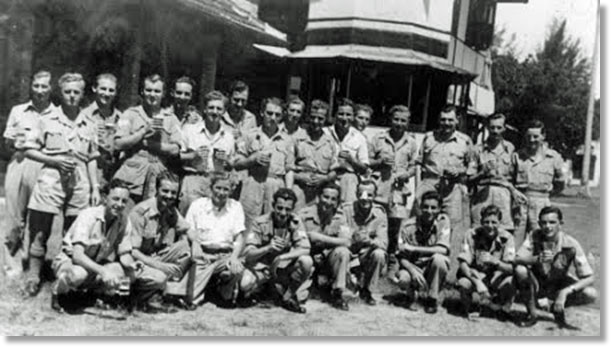
This was the only spirit, indeed the only alcohol that was free. At some time the Navy had magnanimously presented a four gallon barrel of rum - yet almost everyone disliked it. It was certainly strong, but just remained in a glass carboy with a tap, alone and ignored, unless someone was penniless and desperate.
An invitation to visit the Officer’s Mess later in the afternoon was taken up by most of us. The senior Officers had departed, leaving the junior ones to entertain us - probably a wise move, since they were more of our age and we could talk on the same terms. Their Mess was less spartan than ours, perhaps an older building, but did boast a few paper chains (see photo, above). Before breaking up we went outside for a photo (below), a group of about twenty-five, including a handful of Officers, among whom I now only recognise the dentist and an engineer. Maybe I arrived late for I am the only one peering through the back row.
An invitation to visit the Officer’s Mess later in the afternoon was taken up by most of us. The senior Officers had departed, leaving the junior ones to entertain us - probably a wise move, since they were more of our age and we could talk on the same terms. Their Mess was less spartan than ours, perhaps an older building, but did boast a few paper chains (see photo, above). Before breaking up we went outside for a photo (below), a group of about twenty-five, including a handful of Officers, among whom I now only recognise the dentist and an engineer. Maybe I arrived late for I am the only one peering through the back row.
At some point in the early part of 1947, maybe in a letter from Mother, I heard that my schoolfellow, Desmond Burton, now a Sub Lieutenant Met. Officer, was at a Royal Naval Air Station on Singapore. Now I can only suggest it was Seletar, towards the northern part of the island, but the Navy had considerable presence in the mile wide Johore Strait where there were docks and berthing facilities for the Fleet. There was also a seaplane base where the RAF had Sunderland flying boats, but such places were beyond our visiting range. I made contact with Desmond and went to see him two or three times, or we met in town. (I don’t recall him coming out to Changi).
There were the inevitable discussions on the old days and the weekends when I stayed with him in Bodmin. His father owned an outfitters in Fore Street with a very big sitting room above. Here, among various instruments of musical parents, Desmond would play the piano while I attempted the saxaphone - several bars of “The Blue Danube” were accomplished on one afternoon! Another diversion was using an air gun to shoot at the telephone wires that crossed the back garden; a shiver of the wire denoted a hit. How distant it seemed. Now his piano playing was restricted by an accident involving glass whereby two tendons of one hand had been cut and shortened.
There were the inevitable discussions on the old days and the weekends when I stayed with him in Bodmin. His father owned an outfitters in Fore Street with a very big sitting room above. Here, among various instruments of musical parents, Desmond would play the piano while I attempted the saxaphone - several bars of “The Blue Danube” were accomplished on one afternoon! Another diversion was using an air gun to shoot at the telephone wires that crossed the back garden; a shiver of the wire denoted a hit. How distant it seemed. Now his piano playing was restricted by an accident involving glass whereby two tendons of one hand had been cut and shortened.
One particularly unusual get together might have had catastrophic consequences for both of us, but through it I witnessed the power that could be exerted simply by holding the lowest Commission in the Royal Navy, and found out how, under certain circumstances, one can quickly lose any obvious signs of inebriation.
On a Sunday afternoon I visited Desmond at his base. There was no difficulty regarding entry, and I was soon settled in his quarters, drinking gin, I think. How much was in the bottle might be arguable but it had gone in under three hours, when we found the only other drink available in his rooms was a bottle of sherry, so we consumed that as well, with some biscuits or snacks. At about 7pm I decided it was time to return to Changi and I would get to the Air Booking Centre by any bus or gharry available from Seletar. Desmond would have none of this and said he would drive me there himself by borrowing one of the Station’s cars (unlike me, he held a driving licence).
At a parking lot near the camp entrance there was a variety of vehicles ranging from a smallish Austin 10 saloon to Bedford trucks. From these he decided that a large military type Humber saloon would be most suitable and went off to the guard room to get the keys. Goodness knows how he got them but the Navy seemed pretty slack as to who drove their vehicles. I imagine some reason had to be presented, most probably that he had to collect some Naval person from central Singapore, 10 miles away.
We set off quite well, although Desmond admitted he had not driven the Humber before. There were no problems with gears, lights etc. and very little traffic at that time of the evening. But as we got into the busy market streets a couple of miles from the centre fortune changed. Firstly, the car clipped the support for an awning of a market stall causing it to semi-collapse but luckily not the corner from which an oil lamp was hung. It seemed that people scattered in all directions as the car veered to the centre of the road and trundled on with me looking back and realising that Desmond’s control of the vehicle was somewhat tenuous. The experience worsened as the crowds thickened and the car had to weave among them. I doubt if we were doing much more than 10 miles an hour but fully expected that someone would not move quickly enough to avoid being it.
I would have been happy to get out and walk yet could hardly abandon Desmond and somehow he would need to find a place to turn the car round. Then, to miss a handcart stall coming towards us he steered into a gap to the left, there was a lurch and a massive bang, and the car stopped abruptly with one wheel in a concrete monsoon ditch. We got out to inspect, accompanied by numerous locals for whom it was interesting entertainment. It was clear we couldn’t get the car free, although there was no obvious damage. Both of us were suddenly remarkably sobered, and the only solution appeared to be a request for assistance from a military Recovery Vehicle from whatever barracks that could supply one. It maybe that a telephone number was in the car but Desmond went off to telephone for help while I remained on guard amid a throng of bystanders who thought the incident hilarious.
Within ten minutes he was back to say the Army would get a Recovery Vehicle to us in half an hour. When it arrived it was a massive 6 wheeled truck with a crew of three. I had been told to keep in the background and act as if I had fortuitously been in the vicinity when the accident occurred, but nevertheless was party to the ensuing conversation. Apparently the Humber was being driven by a Commander Barton when, to avoid a pedestrian, the car’s front wheel had slipped into the ditch. The urgency of Commander Barton’s appointment meant he had taken a taxi and left his accompanying junior Officer to deal with the problem.
This extraordinary patter was accepted by the soldiers who hauled the car out, checked that there was no damage, and at Desmond’s request turned it round, since I could easily walk to the centre and it was best for him to get the car back to base as soon as possible in case any news filtered through. He scribbled some probably illegible signature on a pad for the crew and off they went. Telling Desmond to go back slowly and with extra care we went our separate ways.
On a Sunday afternoon I visited Desmond at his base. There was no difficulty regarding entry, and I was soon settled in his quarters, drinking gin, I think. How much was in the bottle might be arguable but it had gone in under three hours, when we found the only other drink available in his rooms was a bottle of sherry, so we consumed that as well, with some biscuits or snacks. At about 7pm I decided it was time to return to Changi and I would get to the Air Booking Centre by any bus or gharry available from Seletar. Desmond would have none of this and said he would drive me there himself by borrowing one of the Station’s cars (unlike me, he held a driving licence).
At a parking lot near the camp entrance there was a variety of vehicles ranging from a smallish Austin 10 saloon to Bedford trucks. From these he decided that a large military type Humber saloon would be most suitable and went off to the guard room to get the keys. Goodness knows how he got them but the Navy seemed pretty slack as to who drove their vehicles. I imagine some reason had to be presented, most probably that he had to collect some Naval person from central Singapore, 10 miles away.
We set off quite well, although Desmond admitted he had not driven the Humber before. There were no problems with gears, lights etc. and very little traffic at that time of the evening. But as we got into the busy market streets a couple of miles from the centre fortune changed. Firstly, the car clipped the support for an awning of a market stall causing it to semi-collapse but luckily not the corner from which an oil lamp was hung. It seemed that people scattered in all directions as the car veered to the centre of the road and trundled on with me looking back and realising that Desmond’s control of the vehicle was somewhat tenuous. The experience worsened as the crowds thickened and the car had to weave among them. I doubt if we were doing much more than 10 miles an hour but fully expected that someone would not move quickly enough to avoid being it.
I would have been happy to get out and walk yet could hardly abandon Desmond and somehow he would need to find a place to turn the car round. Then, to miss a handcart stall coming towards us he steered into a gap to the left, there was a lurch and a massive bang, and the car stopped abruptly with one wheel in a concrete monsoon ditch. We got out to inspect, accompanied by numerous locals for whom it was interesting entertainment. It was clear we couldn’t get the car free, although there was no obvious damage. Both of us were suddenly remarkably sobered, and the only solution appeared to be a request for assistance from a military Recovery Vehicle from whatever barracks that could supply one. It maybe that a telephone number was in the car but Desmond went off to telephone for help while I remained on guard amid a throng of bystanders who thought the incident hilarious.
Within ten minutes he was back to say the Army would get a Recovery Vehicle to us in half an hour. When it arrived it was a massive 6 wheeled truck with a crew of three. I had been told to keep in the background and act as if I had fortuitously been in the vicinity when the accident occurred, but nevertheless was party to the ensuing conversation. Apparently the Humber was being driven by a Commander Barton when, to avoid a pedestrian, the car’s front wheel had slipped into the ditch. The urgency of Commander Barton’s appointment meant he had taken a taxi and left his accompanying junior Officer to deal with the problem.
This extraordinary patter was accepted by the soldiers who hauled the car out, checked that there was no damage, and at Desmond’s request turned it round, since I could easily walk to the centre and it was best for him to get the car back to base as soon as possible in case any news filtered through. He scribbled some probably illegible signature on a pad for the crew and off they went. Telling Desmond to go back slowly and with extra care we went our separate ways.
I managed to secure a pleasure flight with Roly Lawson, an ex-pilot who was a Passenger Section colleague who one day had the audacity to go to the office of the airfield’s second in command, and asked the Wing Commander if, to keep his hand in, he could make a flight in the WingCo’s personal aircraft, a small two/three seater Auster. Perhaps the man was completely startled at the impudence, but agreed to the request and that I could accompany Roly. All our colleagues were amazed at his cheek, and especially the outcome.
On the day and time arranged we walked beyond the freight sheds to where the plane was parked to find not only the expected mechanic on hand but the unexpected presence of the Wing Commander, and, unlike our previous meeting, this time there were no remarks on the length of my hair. He gave Roly some hints and tips, said we had about half an hour and walked away. The plane was pushed onto the runway and we got in.
Small aircraft are very snug, and the Auster was delightful, and the first time in two years I’d flown in a light aircraft. It was over a year since Roly had piloted a plane, I’m not sure what, but this was a completely new type and unlike the old Tiger Moth had a self starter - no swinging the propeller by hand! We taxied to the centre of the runway, got the all clear from the control tower, and off we went. There were restrictions that kept us to coastal areas but I managed to get some photos of warships, our airfield, the accommodation blocks, and the road leading into Changi village, though palm trees camouflage the houses. Flying at about 6000 feet and keeping a watchful eye for other planes it was soon time to return. Kept away until another aircraft had landed, Roly made an approach that was rather too high for us to finish near the parking place, so completed another circuit and down we came, unfortunately with a three foot bounce that was noted by all. It was remarked upon by the WingCo., who came up to us when we got out but otherwise appeared satisfied. We thanked him for his remarkable generosity, with the realisation that it had been a “one off” occasion.
On the day and time arranged we walked beyond the freight sheds to where the plane was parked to find not only the expected mechanic on hand but the unexpected presence of the Wing Commander, and, unlike our previous meeting, this time there were no remarks on the length of my hair. He gave Roly some hints and tips, said we had about half an hour and walked away. The plane was pushed onto the runway and we got in.
Small aircraft are very snug, and the Auster was delightful, and the first time in two years I’d flown in a light aircraft. It was over a year since Roly had piloted a plane, I’m not sure what, but this was a completely new type and unlike the old Tiger Moth had a self starter - no swinging the propeller by hand! We taxied to the centre of the runway, got the all clear from the control tower, and off we went. There were restrictions that kept us to coastal areas but I managed to get some photos of warships, our airfield, the accommodation blocks, and the road leading into Changi village, though palm trees camouflage the houses. Flying at about 6000 feet and keeping a watchful eye for other planes it was soon time to return. Kept away until another aircraft had landed, Roly made an approach that was rather too high for us to finish near the parking place, so completed another circuit and down we came, unfortunately with a three foot bounce that was noted by all. It was remarked upon by the WingCo., who came up to us when we got out but otherwise appeared satisfied. We thanked him for his remarkable generosity, with the realisation that it had been a “one off” occasion.
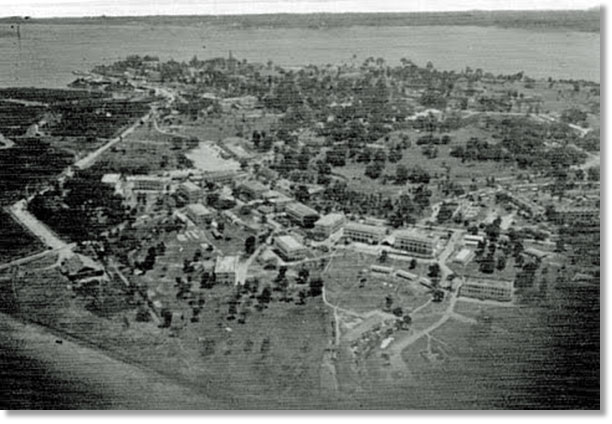
Next month will see the conclusion of NVQ's adventures - Return to the UK

From: Syd Avery, 03140 Guardamar del Segura
Subject: More Memories of Africa
Hi, Tony,
Many thanks for the work you do on our behalf. Don’t normally sit on a sandbag and swing the lantern, but look forward to your missives.
A couple or three memories (allowable) of Africa, one civil if I may. There are many, many more, as with MK, most of our work was to the Dark (beautiful and sometimes enchanting) Continent.
One: Colin Allen’s description of a primate with large powder blue testicles (That’s the biggest pair of blue b0770c45 I’ve seen in my life!) in Nairobi National Park and the reaction of a lady in another truck, classic!
Two: VC10, full of British Royal Army, again, Nairobi, Jomo, which as we all know is high, hot and has a looong runway. Fortunately, using less of the TODA, but considerably more than the calculated TOD.
Captain, most irate, came down the back and asked who was responsible for loading the bags. He insisted that the aeroplane had been wrongly loaded and there was no baggage in the ventral and rear belly, and everything had been loaded in the forward holds. Evidently the aeroplane was extremely nose heavy which resulted in the long take off run. (Remember one of the design parameters of the 10 was that it was designed to cope with hot and high.) With threats of decapitation, disembowelling etc., hanging over Sydney’s head, said Captain returned to his office. My Boss backed me 100%. Later on, the Sqdn. Ldr., (or was he a VC10 Captain?), returned and it transpired that the Flight Engineer had not transferred fuel to the tail tanks… I believe an interview with important senior officer, less tea and biccies, was undertaken.
Three:
Subject: More Memories of Africa
Hi, Tony,
Many thanks for the work you do on our behalf. Don’t normally sit on a sandbag and swing the lantern, but look forward to your missives.
A couple or three memories (allowable) of Africa, one civil if I may. There are many, many more, as with MK, most of our work was to the Dark (beautiful and sometimes enchanting) Continent.
One: Colin Allen’s description of a primate with large powder blue testicles (That’s the biggest pair of blue b0770c45 I’ve seen in my life!) in Nairobi National Park and the reaction of a lady in another truck, classic!
Two: VC10, full of British Royal Army, again, Nairobi, Jomo, which as we all know is high, hot and has a looong runway. Fortunately, using less of the TODA, but considerably more than the calculated TOD.
Captain, most irate, came down the back and asked who was responsible for loading the bags. He insisted that the aeroplane had been wrongly loaded and there was no baggage in the ventral and rear belly, and everything had been loaded in the forward holds. Evidently the aeroplane was extremely nose heavy which resulted in the long take off run. (Remember one of the design parameters of the 10 was that it was designed to cope with hot and high.) With threats of decapitation, disembowelling etc., hanging over Sydney’s head, said Captain returned to his office. My Boss backed me 100%. Later on, the Sqdn. Ldr., (or was he a VC10 Captain?), returned and it transpired that the Flight Engineer had not transferred fuel to the tail tanks… I believe an interview with important senior officer, less tea and biccies, was undertaken.
Three:
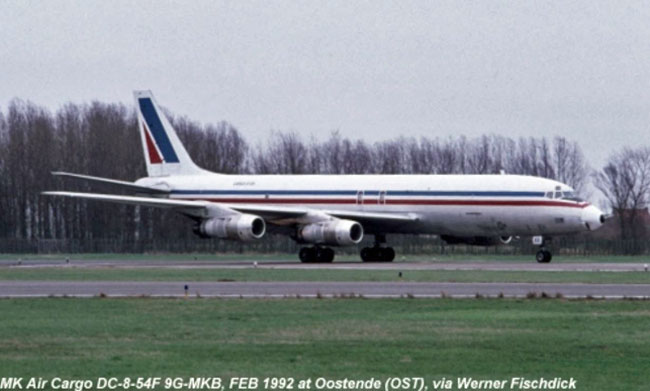
Coming in for a landing at Kano and hit a tree. All five of us (four crew and one pax) managed to get out in one piece, each with just minor cuts and bruises. Best landing the Captain had done all sectors! Love him to pieces.
There are those of who have.
There are those of us who haven’t.
And those of us who have,
Hope that those of us who haven’t,
Don’t.
Regards, go well and keep safe,
Syd.
There are those of who have.
There are those of us who haven’t.
And those of us who have,
Hope that those of us who haven’t,
Don’t.
Regards, go well and keep safe,
Syd.
William Andrew (RAF) with elder sibling Natalie
at Buckingham Palace Garden Party last week
at Buckingham Palace Garden Party last week
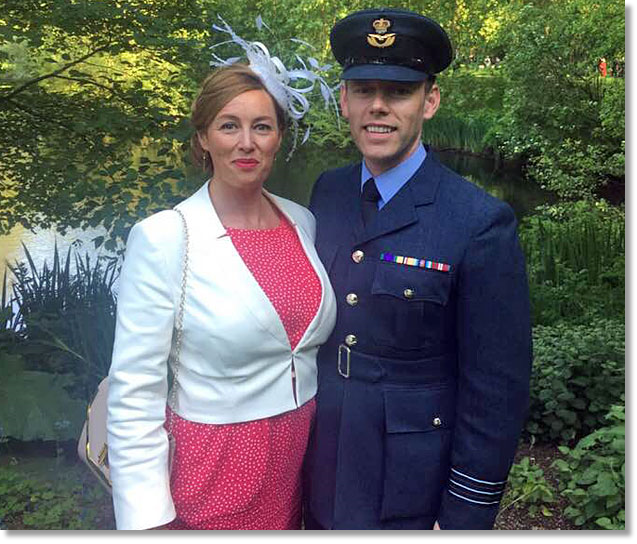
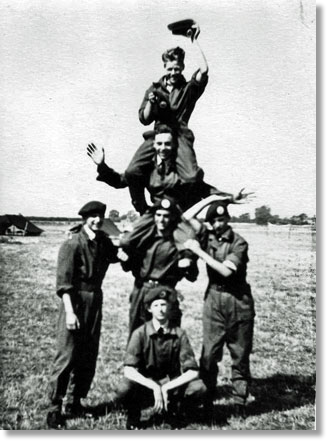
Terry Bell (RAF)
1946 - 2018
1946 - 2018
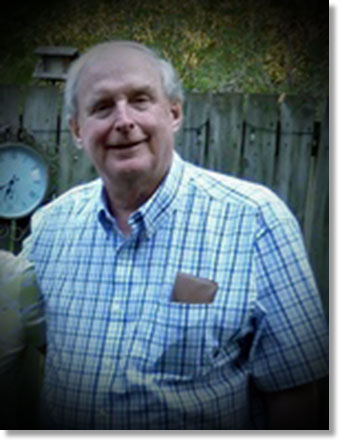
Terry, who lived in Trenton, Ontario, died on !6th May following a year of battling with poor health.
To see Terry's obituary and leave a message of condolence for Wendy and the family, please go here: Terry Bell Obituary
The picture at left was, in all probability, taken at RAF Hereford in the early 1960's. The chaps can be recognized as Boy Entrants by the circular plastic discs behind their hat badges.
Terry is kneeling down in front of the pyramid.
To see Terry's obituary and leave a message of condolence for Wendy and the family, please go here: Terry Bell Obituary
The picture at left was, in all probability, taken at RAF Hereford in the early 1960's. The chaps can be recognized as Boy Entrants by the circular plastic discs behind their hat badges.
Terry is kneeling down in front of the pyramid.
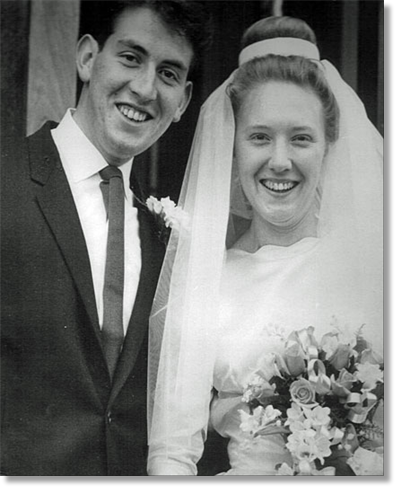
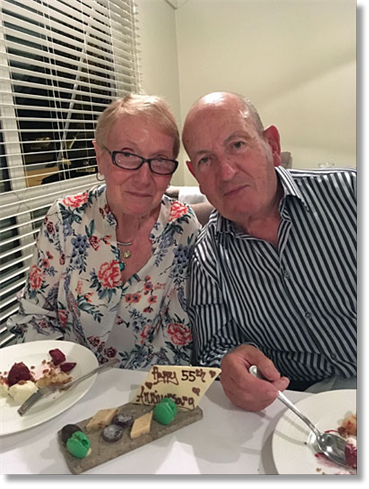
James and Jo Cunningham (RAF) celebrated their 55th last month
and they send their best wishes to Movers wherever you are!
and they send their best wishes to Movers wherever you are!
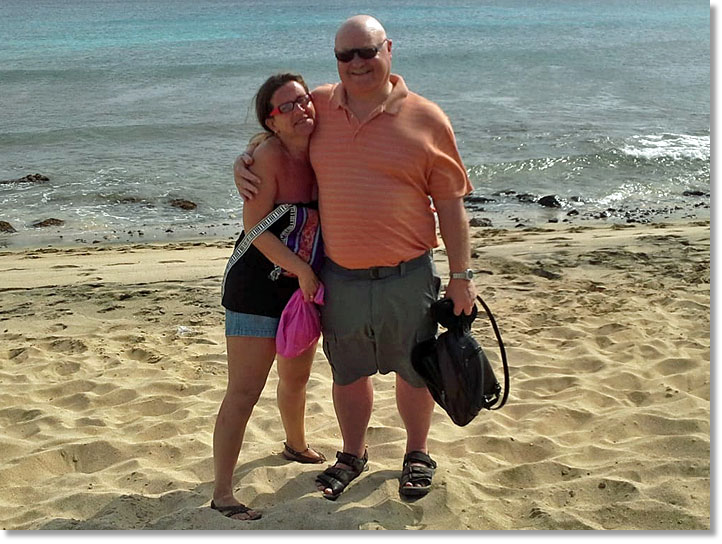
Steve Perry (RAF) : Just remembered, it's our 21st wedding anniversary today, 23 April. Fortunately Carol never remembers either!
Rick Hinks (RCAF): Walked into the Legion in Osoyoos and saw this guy. Mr. Brian (Buck) Lobb (RCAF). Had a great time, could have talked for hours.
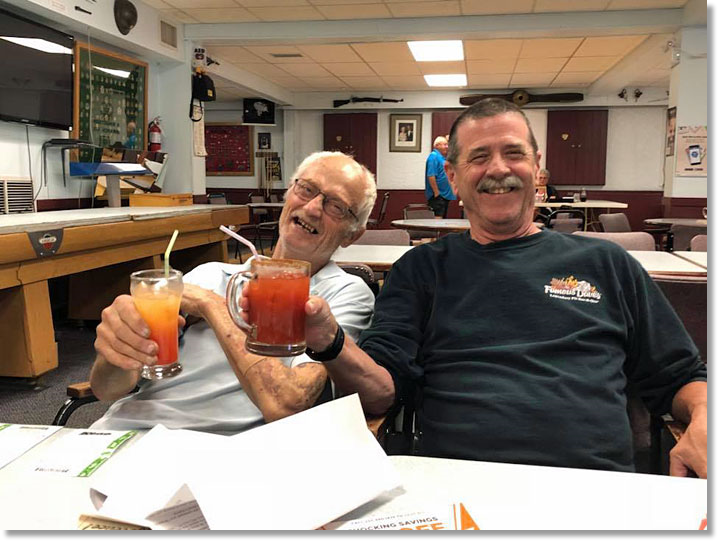
RAF Centenary £2 Coin Collection - Aircraft Edition
Spitfire - Designed by Reginald Mitchell, the Spitfire first flew in 1936, its sleek, streamlined fuselage, beautiful elliptical wing shape and the incomparable Rolls Royce Merlin engine making it perhaps the most graceful fighter aircraft ever designed. The coin is available now.
Vulcan - With it’s instantly recognisable delta wing, the Vulcan combined awesome capability with grace and beauty unmatched by another bomber from the jet-age. In flight, the aircraft was the epitome of power, with superb range and load-carrying capacity. The coin is available now.
Sea King - The Sea King entered service with the Royal Air Force in 1978, exclusively in a search and rescue role, and the last Sea King mission took place on October 4th 2015 when a man found unconscious on Ilfracombe beach was picked up and flown to hospital. The coin will be available in August 2018.
Lightning II - The RAF’s newest aircraft, the F-35 Lightning II. As a fifth-generation aircraft, the complementary air superiority capabilities of Lightning will make a potent mix with the Typhoon. The coin will be available in September 2018
Vulcan - With it’s instantly recognisable delta wing, the Vulcan combined awesome capability with grace and beauty unmatched by another bomber from the jet-age. In flight, the aircraft was the epitome of power, with superb range and load-carrying capacity. The coin is available now.
Sea King - The Sea King entered service with the Royal Air Force in 1978, exclusively in a search and rescue role, and the last Sea King mission took place on October 4th 2015 when a man found unconscious on Ilfracombe beach was picked up and flown to hospital. The coin will be available in August 2018.
Lightning II - The RAF’s newest aircraft, the F-35 Lightning II. As a fifth-generation aircraft, the complementary air superiority capabilities of Lightning will make a potent mix with the Typhoon. The coin will be available in September 2018
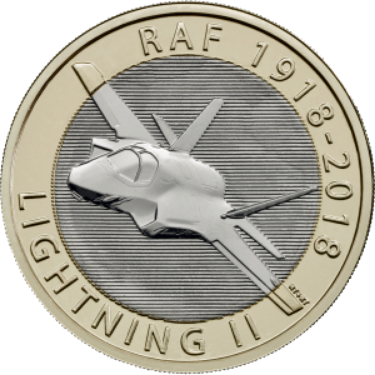
The coins may be ordered from the Royal Mint: http://www.royalmint.com

NZ Herald 15 May 1991
The Royal New Zealand Air Force provided a rare aerial sight over Auckland yesterday when 9 of its 10 Andover Transport aircraft took to the air.
It was the first time in 15 years that so many were together and serviceable.
The 10th is on the ground at Whenuapai Air Base without propellers.
The Air Force bought the second hand 10-year-old aircraft from the RAF in 1976
The Royal New Zealand Air Force provided a rare aerial sight over Auckland yesterday when 9 of its 10 Andover Transport aircraft took to the air.
It was the first time in 15 years that so many were together and serviceable.
The 10th is on the ground at Whenuapai Air Base without propellers.
The Air Force bought the second hand 10-year-old aircraft from the RAF in 1976
More Relevant Stuff
This Newsletter is Dedicated
to the Memories of:
Terry Bell (RAF)
Tony Pyne (RAF)
Mike Hagarty (RCAF)
to the Memories of:
Terry Bell (RAF)
Tony Pyne (RAF)
Mike Hagarty (RCAF)
In the 60's I was on a 10-day trip through Africa as a C130 loadie. We had a 3-day stop in Addis where I was introduced to Jim, a British U.N. chappie, over a beer in the hotel bar. He invited the two of us to go with him on a visit to "The Number One Bar," for a few beers that evening. We asked about the name, were told "Patience, all shall be revealed."
Jim picked us up at 2000 hrs and off we went. Soon, leaving the lights of Addis fading into darkness, we found ourselves on a dirt road wending its way into the jungle where the only illumination was our headlights and their reflections from the many eyeballs of jungle creatures waiting for one of us to fall out of the jeep and becoming part of the local food chain.
Thirty minutes later we pulled up to a dimly lit village hut and, with some trepidation, followed Jim inside. There were about 15-20 people sitting in virtual darkness, illuminated only by a small bedside lamp sitting on the end of the bar.
Jim picked us up at 2000 hrs and off we went. Soon, leaving the lights of Addis fading into darkness, we found ourselves on a dirt road wending its way into the jungle where the only illumination was our headlights and their reflections from the many eyeballs of jungle creatures waiting for one of us to fall out of the jeep and becoming part of the local food chain.
Thirty minutes later we pulled up to a dimly lit village hut and, with some trepidation, followed Jim inside. There were about 15-20 people sitting in virtual darkness, illuminated only by a small bedside lamp sitting on the end of the bar.
Tony Gale
ukmamsoba@gmail.com
ukmamsoba@gmail.com
If you wish to send a donation to the OBA
drop me an e-mail and I'll tell you can do it.
drop me an e-mail and I'll tell you can do it.










